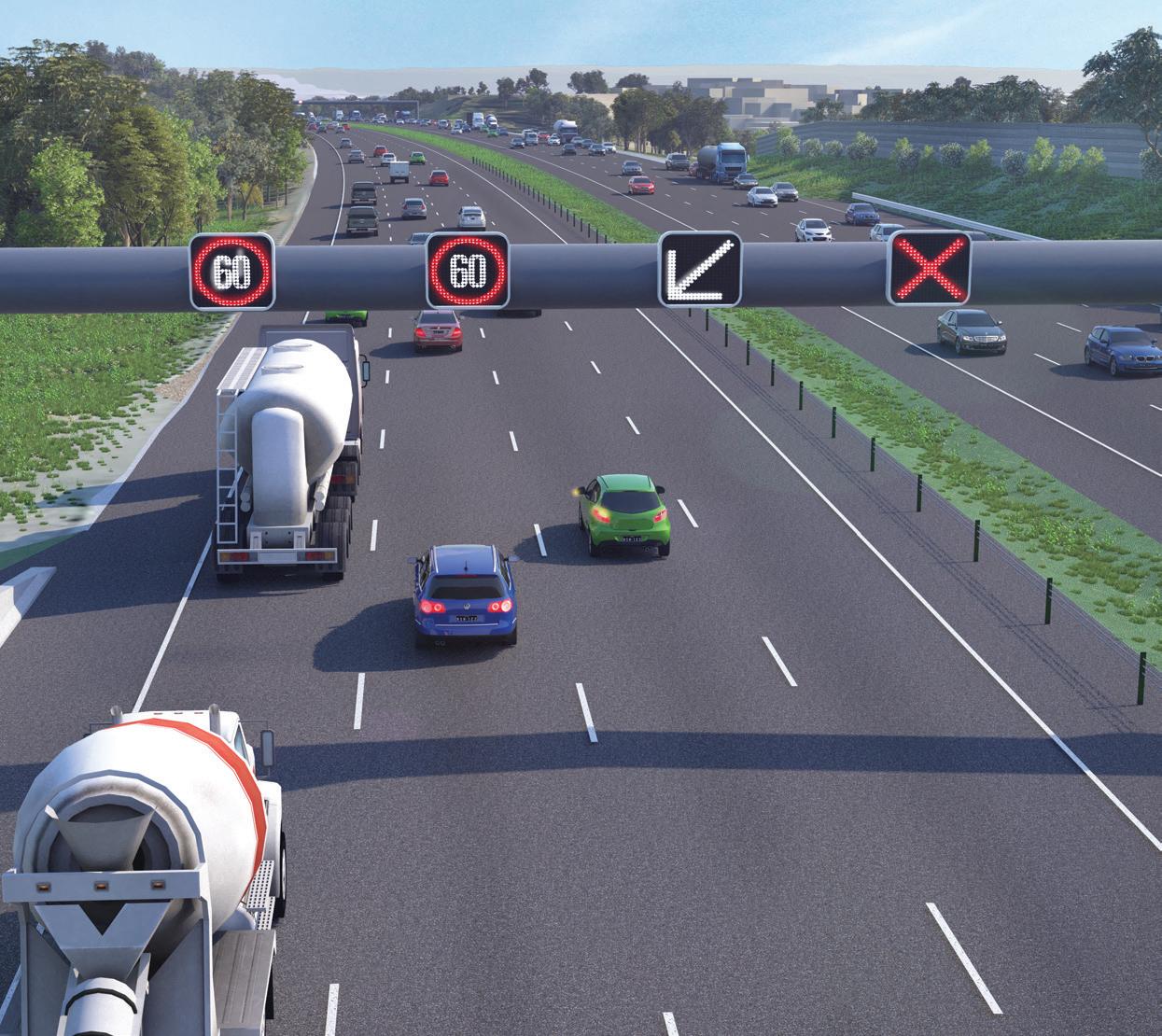
Issue 12 September 2019 ROAD - RAIL - AIRPORT - PORT - URBAN - UTILITY A MENTAL HEALTH BLUEPRINT FOR THE CONSTRUCTION INDUSTRY HOW SYDNEY TRAINS ACHIEVED ISO RECERTIFICATION THE IMPACT OF 5G ON NETWORK INFRASTRUCTURE NSW’s FIRST SMART MOTORWAY

WE’RE PROUD TO BE THE SPECIALIST EQUIPMENT PARTNER OF THE CONTRACTORS THAT ARE LEADING THE WAY FORWARD. NORTH QUEENSLAND 671 Ingham Road Mount St John QLD 4818 QUEENSLAND 147 Archerfield Road Richlands QLD 4077 NSW & ACT 45 Eastern Creek Drive Eastern Creek NSW 2766 VICTORIA & TAS 415 Fitzgerald Road Derrimut VIC 3026 SOUTH AUSTRALIA 9-11 Hakkinen Road Wingfield SA 5013

Vermeer surface miners and track trenchers have been part of methodologies proven on numerous Australian infrastructure projects. Whether it’s lowering the bench in a road tunnel, a box cut for a train station, or trenching a comms channel, we have the equipment and team to support your project. Contact your local Vermeer team to learn more.
Australia
VERMEER.COM.AU | 1300 VERMEER Vermeer and the Vermeer logo are trademarks of Vermeer Manufacturing Company in the United States and /or other countries. © 2019 Vermeer Equipment Holdings Pty Ltd. All Rights Reserved. . / VermeerAustralia
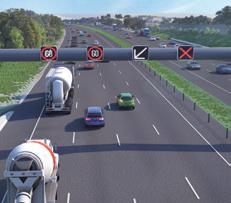

EDITOR’S WELCOME
One of the more interesting findings from Infrastructure Australia’s recently released 2019 Australian Infrastructure Audit is that despite common thinking we are unlikely to be in the middle of an infrastructure ‘boom’, but rather the current increase of infrastructure investment is actually the new normal rate of activity for the sector in order to cater for new challenges.
Given that the industry is grappling with a changing climate, aging and increasing population, and the significant disruption of new digital technologies, it’s no surprise that new projects and developments have been created in order to deal with these issues and ensure our assets continue to run at optimal levels.

ABN:
204/23–25 Gipps St Collingwood VIC 3066
P: (03) 9988 4950
F: (03) 8456 6720
monkeymedia.com.au
info@monkeymedia.com.au infrastructuremagazine.com.au news@infrastructuremagazine.com.au
Editor
Business
Alastair
Rima Munafo
Publisher
We’ve talked a lot about digital and new technologies here at Infrastructure, but we believe the innovation and forward-thinking that is currently driving operations and infrastructure development needs to be shared across the different sectors so collectively we can see what’s possible and combat these future challenges.
One particular innovation that is doing exciting things in the road sector is the implementation of Intelligent Transport Systems (ITS). From the application of data processing and electronic technologies for in-vehicle, vehicle-to-vehicle, vehicleto-infrastructure, and mode-to-mode systems, ITS is helping to improve road safety, congestion and travel times, curbing emissions, and increasing the efficiency of our networks. Studies have also shown that the global intelligent transportation system market is expected to grow exponentially over the next decade.
This issue has a big feature on ITS and how it’s currently being implemented across Australian networks, from NSW’s first smart motorway with new gantries, ramp signals and traffic sensors; to the collection of road use data from vehicles to help manage road networks. One significant result of the implementation of new technologies like ITS is the increase in public safety, which is especially important as Australia’s road death toll continues to climb.
When it comes to safety and risk management in the infrastructure sector, a lot of time and money has been spent on developing ways to protect workers’
physical safety in the field. However, with men in the construction industry being 53 per cent more likely to die by suicide than other employed men across Australia, it’s also time we start to look at mental health safety and risk factors. We’ve taken a closer look at this issue and what the sector can do to support better mental health.
These are all important issues and ones that will be delved into even further at the numerous industry events happening over the next few months. Infrastructure is proud to be distributing this edition at the Australian ITS Summit, the Roads & Traffic Expo, and the Australian Tunnelling Conference, among others.
Speaking of events, Infrastructure had its own event, Asset Management for Critical Infrastructure Conference in August, which explored the most pressing issues in asset management across road, rail, port, and water and power utilities. Thank you to everyone who came along and actively contributed in these discussions, and if you missed out, keep an eye on assetmanagementevent.com.au for upcoming announcements about the 2020 conference.
Or if you don’t want to wait until next year to network and learn from some of the infrastructure industry’s best, Disaster Management is also coming up in November, which will look at how organisations can best prepare for any crisis, from natural disasters such as bushfire, flood or drought; to cyber terrorism attacks, or the threat of an industrial accident, an economic crisis, a resource crisis, or even a disease outbreak. Head to disaster-management.com.au for more info.
2 September 2019 // Issue 12 www.infrastructuremagazine.com.au
Jessica Dickers Editor
Drop me a line at jessica.dickers@monkeymedia.net.au or feel free to call me on 03 9988 4950 to let me know what you think. by www.disaster-management.com.au EXCLUSIVE prepare, survive and thrive disaster events ALBERT PARK, MELBOURNE Disaster Management 2019 September 2019 ROAD RAIL AIRPORT PORT URBAN UTILITY A MENTAL HEALTH BLUEPRINT FOR THE CONSTRUCTION INDUSTRY HOW SYDNEY TRAINS ACHIEVED ISO RECERTIFICATION THE IMPACT OF 5G ON NETWORK INFRASTRUCTURE NSW’s FIRST SMART MOTORWAY INFRASTRUCTURE SEPTEMBER 2019 Published by
Media Enterprises
Monkey
36 426 734 954
Jessica Dickers
Editor
Ho Journalists
King
Assistant
Kim
Rhianna
Development Manager
Bryers
Senior Designer
Molano Designers
Buckmaster
Harris
Alejandro
Jacqueline
Danielle
Chris Bland Managing Editor
Harvey Operations Manager
ISSN: 2206-7906 8,648 This publication has been independently audited under the AMAA’s CAB Total Distribution Audit. Audit Period: 1 October 2018 – 31 March 2019
Laura
Kirsty Hutton

OUR POWER TEAM

SPRINGS!... NO SCREWING AROUND
WAGO’s high-current, rail-mount terminal blocks are available in four sizes for the connection range 6 to 185 mm². Smaller cross sections for supplying control cabinet lighting or other applications can be connected with power taps.
• Easy to use: Even conductors that are difficult to bend can be easily connected, since the locking tab keeps the clamp open for hands-free wiring
• Fast termination: No time-consuming preparation – no ring terminals or ferrules required
• Always reliable: Perfect clamping force – independent of operator skill



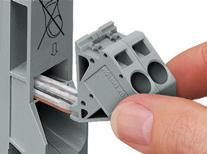

sales.anz@wago.com | (03) 8791 6300 | www.wago.com.au WAGO is a registered trademark of WAGO Verwaltungsgesellschaft mbH.
AVAILABLE UP TO 185 mm2 Accessories at a Glance 35 mm2 125 A 50 mm2 250 A 95 mm2 232 A 185 mm2 353 A Rail-Mount Terminal Blocks 285-135 285-134 285-137 285-150 285-154 285-157 285-195 285-194 285-197 285-1185 285-1184 285-1187 Adjacent Jumper 285-435 285-450 285-495 285-1171 Voltage Tap 285-427 285-447 285-407 285-1175 Voltage Tap with CT855-501/ 150-000 855-951/ 250-000 855-1851/ 350-000 Operating Tool 210-721 285-173 285-173 285-173 NEW
Adjacent Jumper
Voltage Tap
Operating Tool - Hex Wrench NEW NEW Vibration-Proof – Fast – Maintenance-Free
Voltage Tap with CT
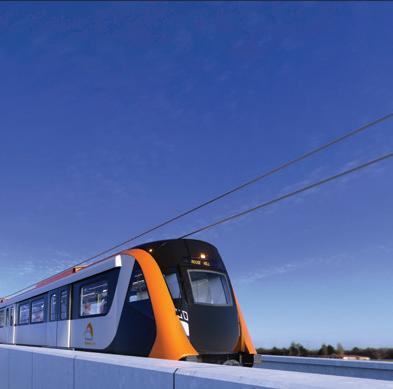

A WORD FROM INFRASTRUCTURE AUSTRALIA
THE INDUSTRY’S EFFICIENCY, CAPACITY AND CAPABILITY FINDINGS
INDUSTRY INSIGHTS
HOW SYDNEY TRAINS ACHIEVED ISO RECERTIFICATION
When Sydney Trains won two of the five awards at the Asset Management Council Excellence Awards earlier this year, host Peter Rowsthorn of Kath and Kim fame, quipped, “Sydney Trains, really?” Winning awards for excellence in managing its $39 billion of assets may be a surprise to some, but for the last few years, Sydney Trains has been working away behind the scenes to overhaul entrenched working practices and business systems in the pursuit of becoming a world-class asset management organisation.
FINDING A NEW STRATEGY FOR WESTERN AUSTRALIA’S PORTS
In September 2017, the Westport Taskforce assembled to begin a colossal undertaking: to develop a strategy to guide the supply chains through Western Australia’s ports for the next century. As it gears up to release its five shortlisted options, Infrastructure spoke to Westport’s Independent Chair, Nicole Lockwood, about its findings thus far and where the strategy is headed.
QUEENSLAND’S FUTURE INFRASTRUCTURE PIPELINE
Job-generating infrastructure, investment opportunities and better services are coming down the pipeline in Queensland’s 2019-20 $12.9 billion capital program. This will support 40,500 jobs, including 25,500 outside of Greater Brisbane.
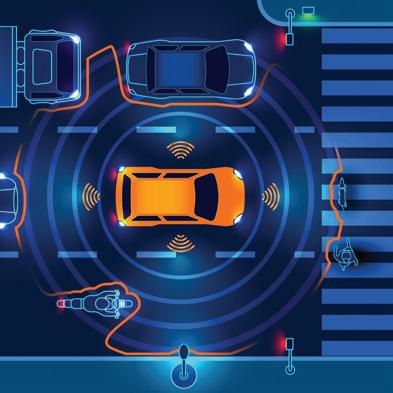
INTELLIGENT TRANSPORT SYSTEMS (ITS)
DIGITAL OVERLAYS AND FUTURE INFRASTRUCTURE
POWER: WHEREVER YOU NEED IT, WHENEVER YOU WANT IT
ALL ABOUT THAT ACE
INTELLIGENT TRANSPORT SYSTEMS HIT THE ROAD IN NSW
SAFETY AND SIDE ROADS
ROAD USE DATA COLLECTION OPTIMISING NETWORK MANAGEMENT
THE IMPACT OF 5G ON NETWORK INFRASTRUCTURE
ROAD AND TRAFFIC
A GUIDE TO AUSTRALIA’S NEW ROAD AUTHORITIES AND PROGRAMS
SHEAR FORCE: MINIMISING INJURY FROM COLLISIONS WITH ROAD SIGNS
THE LATEST ON VICTORIA’S WEST GATE TUNNEL
QUIET METRO TUNNELS WITH NOISE ABSORPTION MATERIALS
September 2019 // Issue 12 www.infrastructuremagazine.com.au 4 CONTENTS
20 22 30 33 34 36 38 40 42 24 28 46 50 52 56 TUNNELS



WORLD-FIRST GREEN CONCRETE TRIAL
CUTTING A PATH TOWARDS A RENEWABLE FUTURE
LACK OF EXTRACTIVE CONSTRUCTION MATERIALS CHALLENGES PLANNED PROJECTS THE BLUEPRINT FOR BETTER MENTAL HEALTH IN THE CONSTRUCTION INDUSTRY
LEARNING HOW TO CREATE SAFER WORKPLACES
TRACK RECORD: QUEENSLAND RAIL IMPROVING SAFETY IS YOUR ORGANISATION PREPARED TO HANDLE A CRISIS?
MILLION DOLLAR CONSTRUCTION CONTRACT AWARDED FOR NORTH-SOUTH CORRIDOR
WINNERS OF THE AUSTRALASIAN RAIL INDUSTRY AWARDS ANNOUNCED
www.infrastructuremagazine.com.au September 2019 // Issue 12 5 CONTENTS
REGULARS 02 EDITOR’S
06 CONTRIBUTORS 80 ADVERTISERS’
80 FEATURES
NEWS 66 10
11
12
WORKS
13 DARWIN
14 VIRTUAL
NEW
AVAILABLE 14 AUSTRALIA’S LARGEST SMART CITY PROJECT COMPLETE 16 ADELAIDE
OUTLINES
PROJECTS 18
CRANES &
ENERGY
FREIGHT AND LOGISTICS
CHECKING IN, NOT CHECKING OFF THE KNOWLEDGE GAP FOR CRANES AND PRECAST CONSTRUCTION 64 78 58 62 70 72 74 76 CONCRETE SAFETY AND RISK MANAGEMENT
WELCOME
INDEX
SCHEDULE
MELBOURNE AIRPORT COMMENCES
ON $300 MILLION TAXIWAY
PORT APPOINTS NEW CEO
TRIPS OF THE
M4 TUNNELS
AIRPORT’S MASTERPLAN
FUTURE INFRASTRUCTURE
THE NEXT LEVEL OF DOZER GPS MACHINE CONTROL PERFORMANCE
HEAVY LIFTING
INFRASTRUCTURE
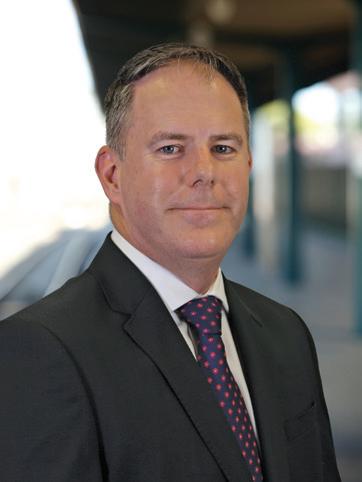 Grant Burton
Deputy Executive Director, Asset Management Division, Sydney Trains
Grant Burton
Deputy Executive Director, Asset Management Division, Sydney Trains
Grant Burton is a railway professional with a civil engineering background and holds a Master’s Degree in Asset Management and an Executive MBA.
Grant is currently the Deputy Executive Director Asset Management at Sydney Trains. Sydney Trains is a complex rail network with over 1.4 million customer journeys a day. Grant is responsible for managing Sydney Trains ISO55001 Accredited Asset Management System and planning the Sydney Trains integrated annual works program valued at $1.5 billion per annum.
Grant has more than 29 years’ rail industry experience working in both mainline and metro railways for public and private sector organisations. He has held senior management positions with London Underground, the Hong Kong Mass Transit Railway (MTR), National Rail Safety Regulator and private consultancies. He joined Sydney Trains in July 2013 and has increased network availability and utilisation of access for maintenance work; implemented improved asset management planning with detailed work requirements extending the planning horizon; and developed a range of improvements which incorporate essential asset management principles.
Grant also implemented an Enterprise Asset Management System across Sydney Trains providing an integrated set of standardised processes, systems and data to support over 7,500 users. This implementation provides the basis for improved business decisions accurate lifecycle costs, integrated long-term maintenance planning and delivery, mobile data capture and integration into the GIS system.
Nicole Lockwood
Independent Chair, Westport
Nicole Lockwood is the Independent Chair of the Westport Taskforce, charged with planning the infrastructure to drive the freight future of WA’s South West for the next 50-100 years. Nicole is also the Chair of the Freight and Logistics Council of WA, and a member of the Boards of the Water Corporation and Infrastructure Australia. She Chairs MNG Surveying and the Sienna Wood JV, and is the Deputy Chair of Leadership WA.
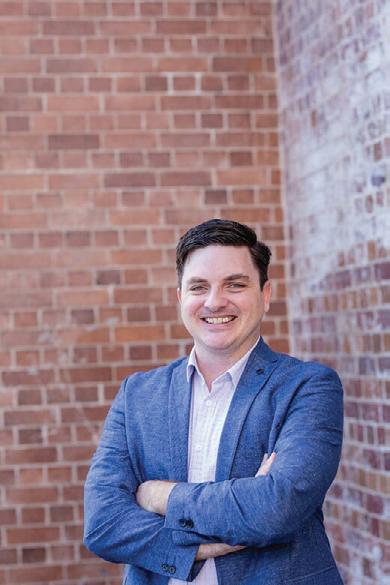
With a background in law and regional economic development, Nicole works with government and the private sector to develop long-term infrastructure plans to secure the future prosperity and liveability of our cities.

Nick Thompson
Industry Engagement Coordinator, MATES in Construction
Nick is a social worker with 12 years’ experience in the not for profit sector both at a service delivery and management level with a focus on population groups impacted by trauma. Nick holds a Bachelor of Social Science, Graduate Certificate in Facilitating Men’s Behaviour Management and Master of Social Work. Nick commenced with MATES in Construction as an Industry Engagement Coordinator in 2019 and recently completed a Global Certificate in Mental Health; Trauma and Recovery from Harvard. He is passionate about the potential of organisations to implement workplace well-being strategies that place mental health and suicide prevention as a normative component of overall workplace health and safety.
6 September 2019 // Issue 12 www.infrastructuremagazine.com.au Contri
September 2019 // Issue 12 www.infrastructuremagazine.com.au
butors
 John Kilgour CEO, Civil Contractors Federation,
Susan Harris Chief Executive Officer, ITS Australia
John Kilgour CEO, Civil Contractors Federation,
Susan Harris Chief Executive Officer, ITS Australia
With an extensive career in transport strategy, as Chief Executive of ITS Australia Susan is ideally placed at the nexus of technology and transport to translate the benefits to business and the Australian community, supported by strong connections to the international ITS community and the global network of ITS Associations. Susan is highly regarded for her roles supporting the growth and innovation of our industry including: convener of Austroads CAV Industry Reference Group; National Transport Commission Industry Advisory Group; and 2026 Spatial Agenda Leadership Group.
Victoria
John Kilgour is the Chief Executive Officer for the Civil Contractors Federation Victoria. Known for his strong advocacy work and networks at local and state government levels, John joined CCF in February 2016 from the Committee for Ballarat where he was CEO. Prior to joining the Committee for Ballarat, John had a long and distinguished career in the downstream oil industry with BP.
During his 34 years with the BP Group of companies, John delivered major investment projects in the oil and gas, retail, petrol and convenience sectors throughout Australia, New Zealand and South East Asia. In February 2017, John was appointed President of the Victorian Civil Construction Industry Alliance, which CCF is a member.
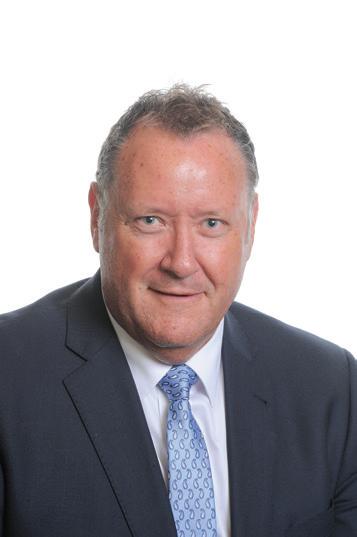

Gavin
Hill
General
Manager Strategy & Delivery, Transport Certification Australia
Gavin has 18 years’ experience in working across stakeholders in government and the private sector to deliver public policy reforms. Previous roles include senior policy advisory positions in the Office of the Minister for Roads and Department of Premier and Cabinet (NSW), as well as management roles at the Roads and Traffic Authority and Austroads.
Gavin is active in international collaboration, including work on the OECD (Organisation for Economic Cooperation and Development)/ITF (International Transport Forum) initiatives, the International Forum for Road Transport Technology, and telematics deployment projects in Scandinavia.
7 www.infrastructuremagazine.com.au September 2019 // Issue 12
www.infrastructuremagazine.com.au September 2019 // Issue 12
A NEW WAY TO BUILD
Finally, take control of your projects at every phase of construction. Find out how with InEight software.



INEIGHT’S PROVEN RESULTS
Manage your projects through all stages of construction by utilizing InEight’s complete portfolio of project management solutions. InEight has over 30 years of experience deploying these solutions on billions of dollars’ worth of capital projects for contractors, owners and engineers worldwide.
INEIGHT SOFTWARE PORTFOLIO
Offering you the most comprehensive, functionally rich and modular software portfolio built to optimize capital programs and project workflows, control costs, reduce risk and drive predictable outcomes.
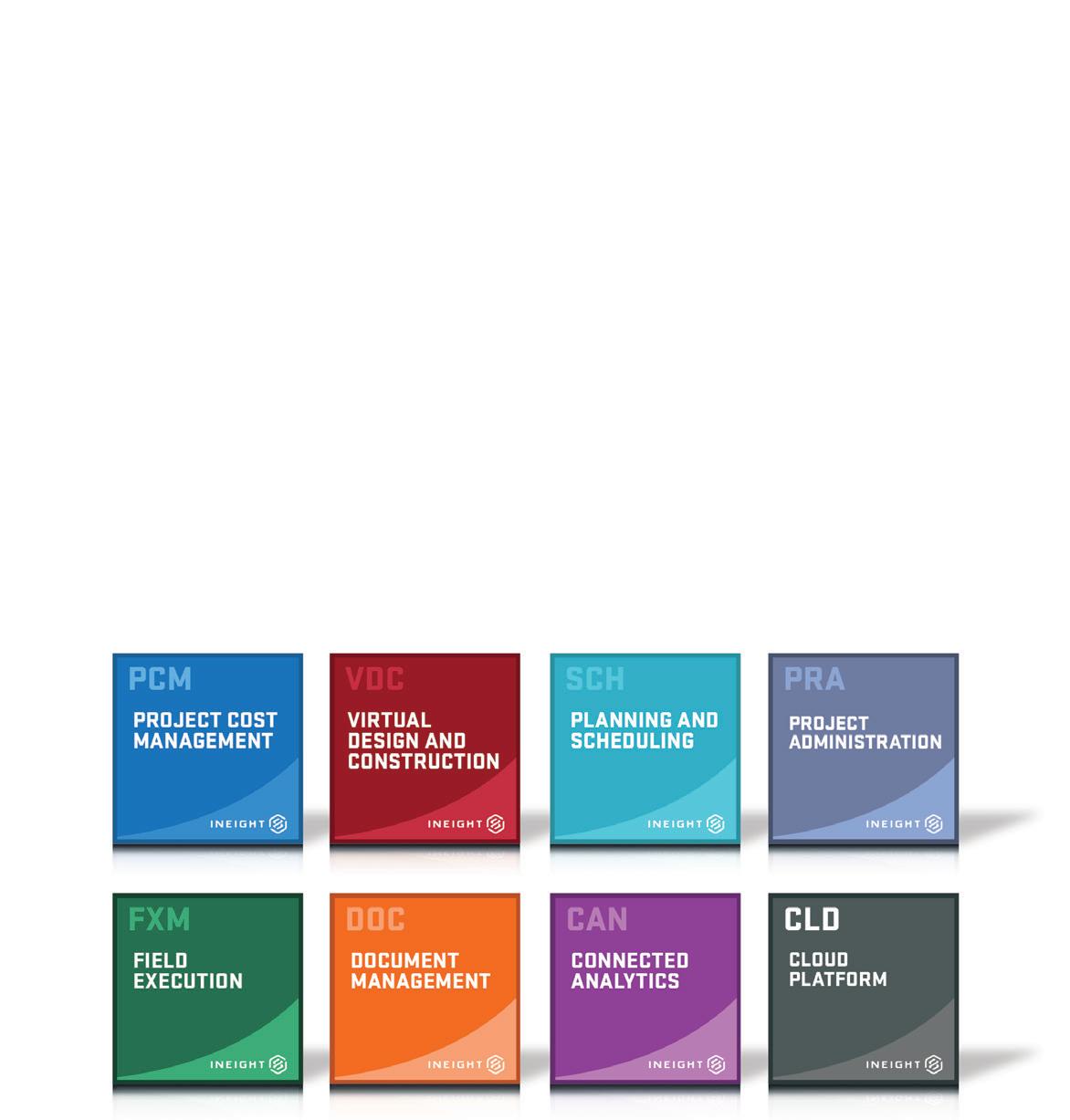


InEight.com/infrastructure


866.463.7718
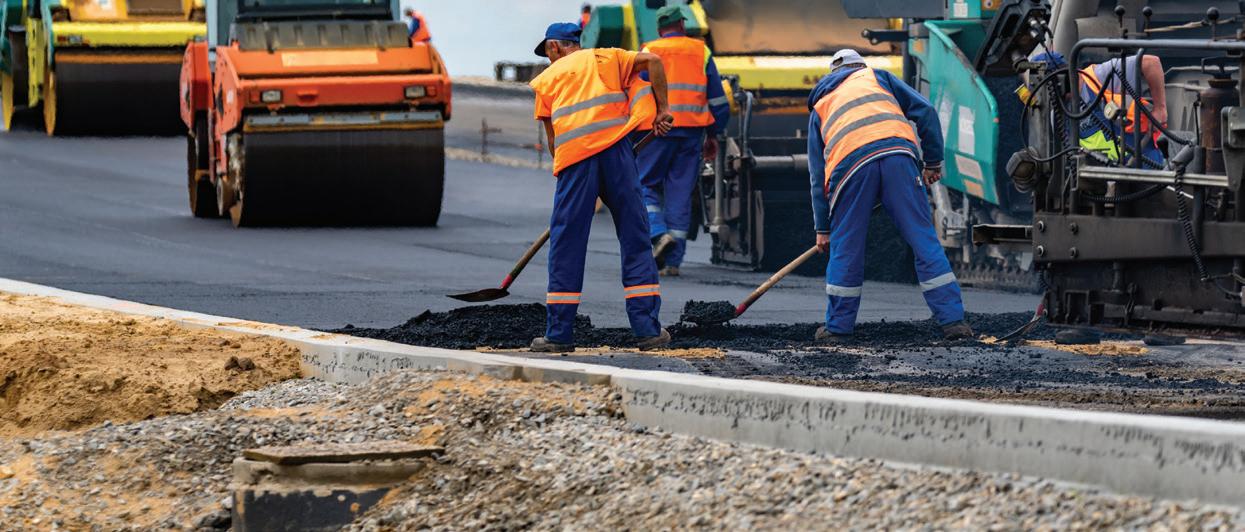
MILLION DOLLAR
CONSTRUCTION CONTRACT AWARDED
The $354.3 million construction contract for the North-South Corridor—Regency Road to Pym Street Project in South Australia has been awarded.
A consortium of McConnell Dowell Constructors, Mott MacDonald Australia and Arup Group will design and construct a new 1.8km motorway along South Road, connecting the South Road Superway to the Torrens Road to River Torrens Project.
Main construction works for the upgrade are expected to commence in late 2019, with completion expected in 2022. It is anticipated that the project will support an average of 210 full time equivalent jobs per year, over the life of the project.
Minister for Cities, Urban Infrastructure and Population, Alan Tudge, said that this project is the final missing link of the North-South Corridor between Gawler and the River Torrens.
“When complete, it will deliver efficient and reliable travel for up to 53,000 vehicles per day on this section

of South Road, by removing the need to travel through two signalised intersections,” Mr Tudge said.
The Federal Government has invested $5.3 billion in infrastructure and transport across South Australia.
“The Morrison Government is partnering with the Marshall Government to deliver congestion busting infrastructure upgrades right across Adelaide,” Mr Tudge said.
Minister for Transport, Infrastructure and Local Government, Stephan Knoll, said this section of the North-South Corridor formed part of the $11.9 billion infrastructure pipeline announced in the Marshall Government’s 2019–20 State Budget.
“The Marshall and Morrison Governments are committed to keep building South Australia,” Mr Knoll said.
“We are building congestion busting infrastructure that will cut travel times, make our roads safer and also secure construction jobs into the future.”
The concept design includes:
♦ A 1.8km section of non-stop
roadway, providing three lanes in each direction (at-grade)
♦ Two lanes in each direction on the South Road surface road, providing access to the surrounding community and local businesses
♦ An overpass over Regency Road (three lanes in each direction). Two lanes in each direction (at-grade) on the surface roads underneath
♦ Left-in and left-out only access at Pym Street
♦ Full access to and from the nonstop motorway at Regency Road
♦ Intersection upgrade at Regency Road
♦ Improved cycling and pedestrian facilities
♦ A grade separated pedestrian and cycle overpass over South Road in the vicinity of Pym Street
♦ Landscaping and noise barriers
The Federal and State Governments are jointly funding the project as part of their overall commitment to build a non-stop 78km North-South Corridor between Gawler and Old Noarlunga.
ANCOR LOC AUSTRALIA works in the field of earth anchoring solutions with an outstanding reputation for product quality and customer service. We offer a complete line of mechanical ground anchors designed for temporary or permanent use.
NO DIGGING, NO EXCAVATION, NO SOIL DISTURBANCE
SAVE TIME AND LABOR
With fast and easy installation, the patented DUCKBILL®, MANTA RAY® and STING RAY® Anchors work like toggle bolts in the soil.
NO HOLES, NO DIGGING AND NO CONCRETE
Anchors are driven into the ground and provide a safe and environmentally sensitive installation.
PERPENDICULAR “LOAD LOCK” IN UNDISTURBED SOIL
An outward pull on the tendon rotates the anchor into position.
SAFE, STRONG, LIGHTWEIGHT AND ECONOMICAL
Our anchor systems offer an effective and easy way to install solution to earth anchoring systems. Anchors can be load tested immediately after installation to exact holding capacity.
IDEAL FOR:
• Demountable buildings
• Cyclone-prone areas
• Containers
• Retaining block and gabion walls
• Playground equipment
• Scaffolding
• Revetment mats




10 September 2019 // Issue 12 www.infrastructuremagazine.com.au NEWS
www.ancorloc.com.au / 03 9585 6808 / info@ancorloc.com.au
FOR NORTH-SOUTH CORRIDOR
WINNERS OF THE AUSTRALASIAN RAIL INDUSTRY
AWARDS ANNOUNCED
The Australasian Rail Industry Awards Gala Dinner celebrated the outstanding achievements and innovations within the industry, with over 500 representatives attending.
The awards acknowledged the contributions of the 13 category winners. The award categories and winners were:
♦ Career Achievement Award – Denise Sclater, NSW TrainLink
♦ Customer Service Award – Keolis Downer Gold Coast
♦ Employee Engagement Award – Sydney Trains
♦ Frank Franklyn Young Rail Specialist Award (RTAA) –Simon Lehman, John Holland
♦ Freight Rail Excellence Award – Rio Tinto
♦ Innovation and Technology Award – Laing O’Rourke
♦ Permanent Way Institution Young Achiever Award (PWI) –Jarod Wakefield, John Holland Rail
♦ Rail Sustainability Award - Downer Rollingstock Services
♦ Safety Award Joint Winners - V/Line; and Prescribe Australia, Aurizon and JPC
♦ Systems Engineering Award (IRSE) – Frank Bartolo, FMB Signalling
♦ TrackSAFE Award Joint winners – Queensland Rail and John Holland Rail
♦ Workforce Diversity Award – Transdev
♦ Young Rail Professional Award (RTSA) – Mark Xerri, CPB Contractors
Australasian Railway Association (ARA) Chief Executive Officer, Danny Broad, congratulated the winners for their outstanding achievements and contributions to the rail industry.

“It was exceptional to see so many talented individuals and committed companies within the rail sector awarded for their excellence, passion and dedication,” Mr Broad said.
“With over 120 nominations for the 13 award categories, we had a high-quality field.”
“I particularly want to pay tribute to Denise Sclater from NSW TrainLink, for her Career Achievement Award. As the first female train driver in NSW, Denise paved the way for many more to follow.
“Through hard work, determination and diligence, she has won the respect of her colleagues and forged a route for others to follow.”
Proceeds from the Australasian Rail Industry Awards will go towards the TrackSAFE Foundation, a registered harm prevention charity that endeavours to reduce near collision, injuries and fatalities on the rail network resulting from suicide, reckless behaviour and human error.

11 www.infrastructuremagazine.com.au September 2019 // Issue 12 NEWS
AIRPORT COMMENCES WORKS ON
$300 MILLION TAXIWAY
Ground has broken at Melbourne Airport’s new taxiway network ‘Taxiway Zulu’, with the $300 million project beginning works.
As the largest single airfield investment for the airport since its opening in 1970, the new taxiway network will provide valuable additional space for aircraft traffic, improving the efficiency of movements on the ground, as well as supporting the growth in Melbourne’s international connectivity.
The construction project will see the development of more than 250,000 square metres of new taxiway pavement and is designed to be completed without significant interruption to a single one of the airport’s daily flights.
Melbourne Airport Chief of Aviation, David Hall, said it’s “not just about breaking ground on a $300 million investment in our airfield; it is about transforming the travel experience for our passengers.

“When completed, these new taxiways will mean better
on time performance for flights, more space for international aircraft and access to new destinations – it’s all part of our vision to support Melbourne on its journey to become Australia’s biggest city.”
Fulton Hogan CEO, Duncan Gibb, said, “We are passionate about designing a new future for Melbourne Airport while setting a benchmark for sustainable infrastructure.
“Melbourne Airport has ambitious plans for its future and we are proud to be selected to help deliver their inspirational
DCWC’s Project Management Director, John O’Callaghan, said, “We are delighted to be supporting Melbourne Airport in the delivery of this challenging airfield development that unlocks the airport’s
The finished taxiway network will result in parallel taxiways in the north of the airfield in supporting wide-body aircraft movements in both the eastwest and north-south directions.

AusRail PLUS Sydney
December 3 – 5, 2019 Come and visit us at our stand 349

As a leading engineering and consulting company in the rail sector, we off er sustainable, made-to-measure mobility and transport solutions. From light rail to high-speed traffi c, from industrial railway to complex logistics concepts –as a full-service provider we take care of consulting, design and realization, from the idea to operations. No matter what challenges you face – we will find the best solution. We always keep the goal in mind: to make your project a success.
www.db-engineering-consulting.com


12 September 2019 // Issue 12 www.infrastructuremagazine.com.au NEWS
MELBOURNE
DARWIN PORT APPOINTS NEW CEO
Darren Lambourn has been appointed as the new Chief Executive Officer at Darwin Port and will be responsible for the overall operations and management of the port.
He assumed his role on 19 August, reporting directly to Landbridge Australia’s Managing Director, Mike Hughes.
Mr Lambourn has a wealth of experience in supply chain operations in general cargo and bulk logistics.
Most recently, he worked as the General Manager Bunbury for Southern Ports Authority where he was instrumental in the development and implementation of new port masterplans, which successfully streamlined systems, processes and recruitment of critical positions.
In his role as the General Manager of CITIC Pacific Mining and the Cape Preston Port Company, Mr Lambourn developed and managed a new operational bulk loading port for the $12 billion Sino Iron project in the Pilbara.
Mr Lambourn has also held positions as the Regional Manager of the P&O Automotive and General Stevedoring and the Queensland Bulk Manager for P&O Ports.
He is set to bring to Darwin Port a strong focus on safety and environment with extensive experience in asset utilisation, port commissioning, stakeholder management and new business development.
Mr Hughes said Mr Lambourn’s extensive experience in supply chain operations and port management made him an ideal candidate to continue the port’s transformation to a world-class port capable of supporting the growing demands of Northern Australia.
Mr Lambourn will succeed Terry O’Connor, who announced his resignation earlier in 2019 after an eleven-year career with Darwin Port.
“On behalf of Landbridge, I would like to thank Terry for his significant contribution to Landbridge and to Darwin Port. Terry has successfully led Darwin Port through its transformation from a Northern Territory Government business to a thriving privately-owned port under Landbridge’s management. We wish him well for the future,” Mr Hughes said.

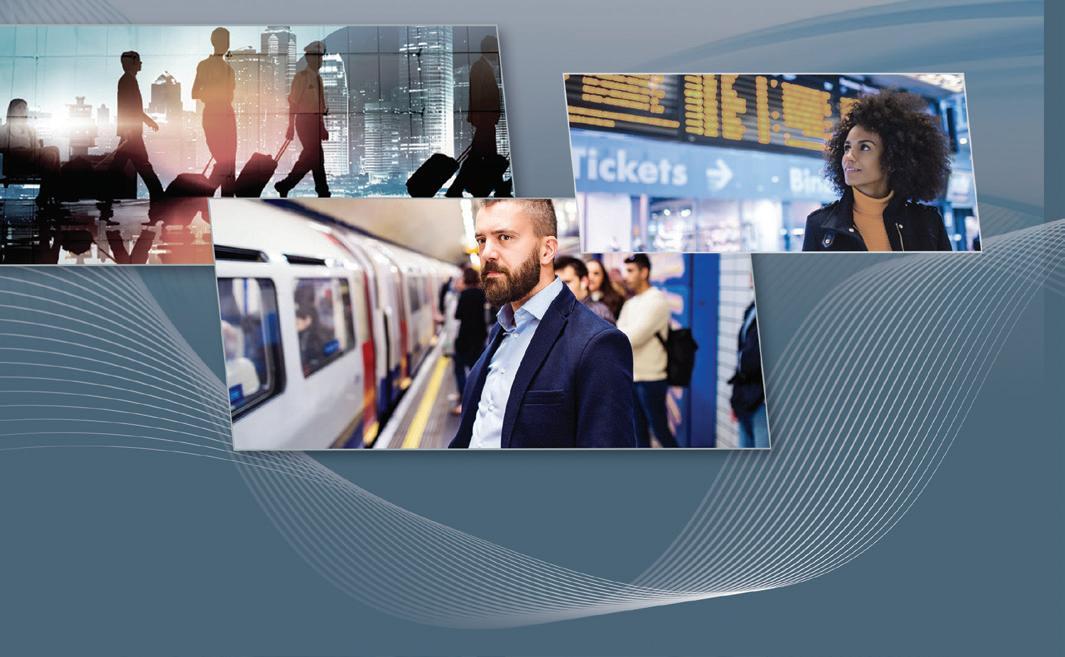
13 www.infrastructuremagazine.com.au September 2019 // Issue 12 NEWS
VIRTUAL TRIPS OF THE NEW M4 TUNNELS AVAILABLE
NSW drivers have been able to experience virtual trips through the new M4 Tunnels ahead of its official opening via a series of new driver experience animations by WestConnex.
New M4 Project Director, Terry Chapman, said animations simulate the driver experience and could help to familiarise motorists with new entry and exit points, and help to plan future journeys.
“The $3.8 billion new M4 Tunnels will connect to the widened M4 and extend it via twin tunnels, three lanes in each direction, from Homebush to Haberfield.
“The M4 is going underground and it will be a game changer for western Sydney with motorists soon able to travel on the M4 between Penrith
and the inner west of Sydney without stopping at a single traffic light.
“With the tunnels nearing completion, new animations have been developed to promote awareness and replicate the exact tunnel fit-out and experience motorists can expect when using the new M4 Tunnels, which will be the first road tunnels to open in Sydney since 2007.
“The animations have been designed to educate motorists about the new M4 Tunnels before they open to live traffic, and show how to enter and exit the tunnels, lane configurations, the various connections to the existing road network, as well as what signage and wayfinding methods drivers will see when driving in the tunnels.
“The new M4 Tunnels provide a vital bypass of the congested Parramatta

Road, allowing motorists to avoid up to 22 sets of traffic lights that they face every day when they come off the M4 and onto Parramatta Road at Concord.
“Motorists travelling on the entire length of WestConnex’s new M4 between Parramatta and Haberfield will bypass up to 42 sets of traffic lights,” Mr Chapman said.
The tunnels will emerge east of Bland Street on Parramatta Road and on Wattle Street, Haberfield, connecting to City West Link. There will also be connections at Concord Road, Concord (known as the Concord Interchange).
The new M4 Tunnel Project is expected to be finished by 2021.
AUSTRALIA’S LARGEST SMART CITY PROJECT COMPLETE
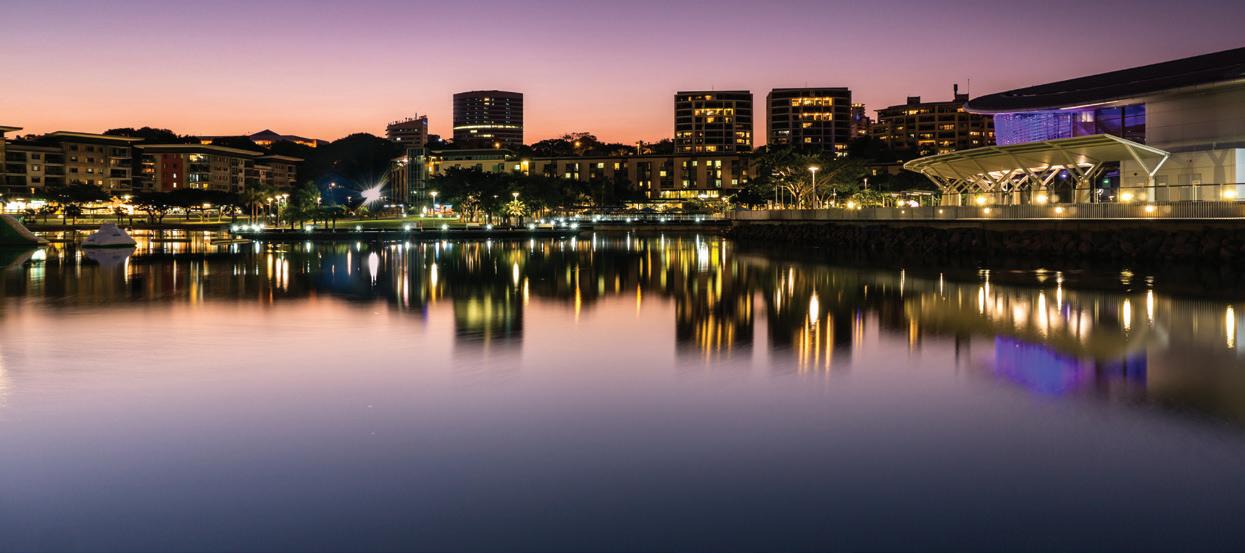
The nation’s largest smart city project, Switching on Darwin, has successfully been completed on schedule and within budget.
The project aims to make Darwin a world-leading smart city with the addition of 912 new LED lights, 138 new CCTV cameras, 39 new hotspots to extend free Wi-Fi, 24 environmental sensors, smart parking sensors, along with an audio system in the Mall.
The $10 million project, which received $5 million funding from the Federal Government and $2.5 million each from the NT Government and City of Darwin, was launched in July 2018. Switching on Darwin will deliver many benefits to the community and our environment, including:
♦ Enhanced community safety
♦ Improved and more efficient council services
♦ Greater environmental sustainability by reducing energy consumption and carbon emissions
♦ Smart planning where data will inform planning and design
♦ Innovation with data available to the community and business sector
♦ Improved public spaces through Wi-Fi, lighting, smart parking and better understanding of pedestrian movement
of
said completion of the project positioned Darwin as a leader in innovation.
“We now have the tools to improve the liveability of our city, the delivery of services to our community and to better understanding our local environment.”
Local Member for Port Darwin, Paul Kirby, said the Esplanade is one of Darwin City’s most pristine and popular exercise areas.
“Since being elected I’ve been having discussions with people about making it brighter and safer for exercise in the evenings.
“That’s why the NT Government is committed to funding and partnering this project.”
Senator for the Northern Territory, Sam McMahon, said the Federal Government was pleased to invest in better services and infrastructure for all Territorians.
“The completed Switching on Darwin project is an important part of the Morrison Government’s commitment to keeping Darwin residents and visitors safe and improving the amenity of our public spaces.
“This project simply would not have been possible without the $5 million investment by the Morrison Government and I’m proud to see the completion of this great initiative.”
14 September 2019 // Issue 12 www.infrastructuremagazine.com.au NEWS
City
Darwin Lord Mayor, Kon Vatskalis,
























www.terrapinn.com/exhibition/road-tra ic-expo 250 SPEAKERS 200 EXHIBITORS 5000 ATTENDEES 17 - 18 September 2019 Melbourne Convention & Exhibition Centre, Australia JOIN US ON LINKEDIN Co-located with: Sponsored by: With participation from: AUSTRALIA’S BIG TRADE EXPO FOR THE ENTIRE ROADS TRANSPORT ECOSYSTEM Weldlok® Galintel® Galserv® EQUIPMENT INNOV8 SAFETY · INNOVATION · COMPLIANCE REGISTER FREE NOW TRAFFIC MANAGEMENT TRAFFIC MANAGEMENT
ADELAIDE AIRPORT’S MASTERPLAN OUTLINES
FUTURE INFRASTRUCTURE PROJECTS
Adelaide Airport has released its 2019 Preliminary Draft Master Plan which outlines its plans for infrastructure, job creation and sustainable economic development over the next 20 years.
The airport has grown significantly as a major economic and employment generator in South Australia and this growth is expected to continue over the next two decades.
Over the next 20 years, forecasts indicate that passenger numbers will grow to 19.8 million – including 3.3 million international travellers – while air freight will almost triple from 58,500 tonnes to 146,000 tonnes.
Infrastructure projects that will help assist with the expected passenger growth are estimated to be underway or completed over the next five years.
These projects include the domestic and international terminal expansion (currently under construction), and a freight and logistics hub in the Airport East Precinct to the south of the main runway with dedicated access via Richmond Road.
Adelaide Airport Managing Director, Mark Young, said a lot had been achieved in the past five years.
“Adelaide Airport remains one of the fastest growing domestic and international airports in Australia, and since 2014 we’ve attracted major new airlines such as Qatar Airways and China Southern.
“We’ve also built the new Atura Hotel, commenced a major terminal expansion project and attracted major companies to our precinct such as OZ Minerals, Australian Clinical Labs, Otis, Kennards Self Storage, Aldi and AFL Max.
“The growth of Adelaide Airport is inextricably linked to the development of South Australia. We play an essential role
in the economic prosperity and development of the state through creating jobs and supporting business, tourism and leisure activities.
“We are planning and building appropriate levels of infrastructure to stay ahead of this growth and maintain our reputation as one of Australia’s most modern airports.
“The masterplan is one of our most important documents in that it is our primary planning tool for the next eight years, while presenting our long-term strategic plans until 2039.
“Looking forward, we see the completion of the terminal expansion project in 2021 and the creation of a freight and logistics hub in our Airport East Precinct as important goals for our business.”

Mr Young said the masterplan was just one part of Adelaide Airport’s ongoing consultation with the community, with regular stakeholder consultative committees and community updates just two of the ways the airport reached out to the local community.
“Ultimately, this Preliminary Draft Master Plan seeks to provide, to the best of our current knowledge and forecasts, clarity and certainty on growing and developing Adelaide Airport in a well-planned and logical manner, which is consistent with our central role in the development of the state as a key infrastructure asset.
“The masterplan is about the art of the possible, not probable. It does not dictate what will be built, but rather what can be built based on growth conditions and stakeholder considerations.”
The Adelaide Airport 2019 Preliminary Draft Master Plan (PDMP) is on public display until 28 October 2019.
16 September 2019 // Issue 12 www.infrastructuremagazine.com.au NEWS
CROWN PROMENADE
24–27 NOVEMBER 2019

CORROSION & PREVENTION 2019
The annual ACA conference is a three day gathering of world experts on corrosion mitigation. This will be a premium networking event as well as a source for the latest information concerning corrosion mitigation. Entitled Corrosion & Prevention 2019, the conference will comprise a program of keynote speakers and presentations under a range of industry ‘streams’, integrated with an exhibition that will showcase the latest products and services of the corrosion mitigation industry.
Over 500 delegates and visitors are expected to attend from industries such as; protective coatings, water, defence, building and construction, mining, oil & gas, cathodic protection, power and more.
C&P2019 INCLUDES:
• Quality Technical Program
• 62 Booth Trade exhibition
• Social & Networking functions
• Technical Forums
• Awards Dinner

• Partner Program

Willie Mandeno Principal Engineer Materials – WSP Opus

Carmen Andrade President – Alconpat

Dudley Primeaux Owner – Primeaux Associates LLC

Srdjan Nesic Russ Professor of Chemical Engineering – Ohio University

Stuart Lyon AkzoNobel Professor of Corrosion Control, – the University of Manchester Institute of Science and Technology (UMIST)

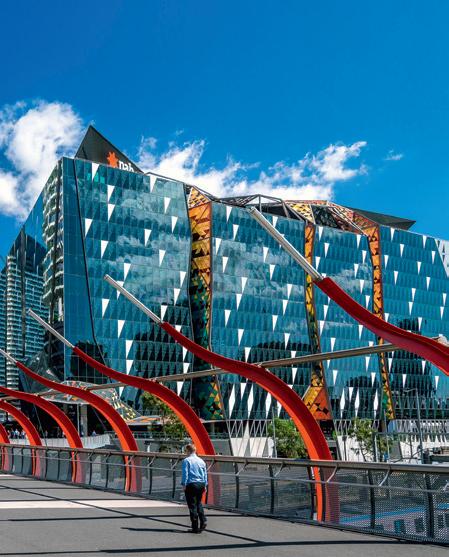
MELBOURNE, AUSTRALIA
PROUDLY PRESENTED BY:
For more information and to register go to: https://conference.corrosion.com.au
PLENARY LECTURERS:
Andrew Wright, Director and Owner of Digwright, said when the opportunity came for them to install a [3D-MCMAX] mastless system on one of their new CAT D6T VPAT machines they were keen to give it a go.

THE NEXT LEVEL OF DOZER GPS MACHINE CONTROL PERFORMANCE
Digwright had been using Topcon 3D-MC² systems from Position Partners on its dozers since 2009 and had always found the 3DMC² systems to be more responsive and smoother than other systems on the market, so when the opportunity to implement the Topcon 3D-MCMAX mastless machine control system arose, Digwright jumped at it.
“The rate of speed the machine was able to trim at in higher gears is impressive.”
WHY DID DIGWRIGHT CHOOSE THE TOPCON 3D-MCMAX MACHINE CONTROL SYSTEM?
Mr Wright found that the Topcon 3D-MCMAX machine control system from Position Partners took Digwright’s dozer GPS machine control to the next level of performance.
“This system saves our business time, fuel and money through making our dozer more efficient in bulking and trimming to grade applications,” Mr Wright said.
“The system works well in all types of materials especially when densities and compacted material change frequently. It reduces the blade ride on harder surfaces and seamlessly reacts to softer material, where the blade would normally bite in, the Topcon 3D-MCMAX from Position Partners will correct the blade lighting fast to leave a smooth level finish.”
Another benefit that Mr Wright has noted since implementing the 3D-MCMAX machine control system is improved safety due to the system being mastless.
“Removing the mast pole from the blade has also improved safety through better visibility and no need for the operator to stand on the blade to remove the GPS antennas at the start and end of a shift,” Mr Wright said.
THE IMPORTANCE OF SERVICE AND SUPPORT DURING PURCHASING AND IMPLEMENTATION
Product support is an important part of Mr Wright’s decision-making process when researching new technology and equipment to implement: minimising the downtime of Digwright’s machines is critical.
“If it’s not working, it’s not making money,” Mr Wright said. “In the past ten years of dealing with Position Partners, we have found them to be proactive, helpful and responsive to a fix, repair or to come with a solution that will keep us moving.”
The team at Digwright also implemented Position Partners’ Tokara Link, an Australian-designed telematics solution created specifically to improve efficiency and productivity for earthworks and civil construction projects.
Using a modem installed in the machine, Tokara Link connects your machines to the office, provides access to Position Partners' technical support and links you to any GPS network required for the job.
“Our 3D-MCMAX dozer linked with a T-MESH and Tokara Support allows Position Partners to better support our machine with remote access by their support team to fix any issues or upload files for hundreds of kilometres away. Meaning no need to wait for a technician to come to site in most cases,” Mr Wright said.
”Overall, we are extremely happy with the 3D-MCMAX and the install of the system by Position Partners. It looks just like a factory integrated system and not a tacky bolted on after market system.
“If you are looking to get more efficiency out of your dozer, and save time and money on your next project, I can thoroughly recommend a Topcon 3D-MCMAX system,” Mr Wright said.
18 September 2019 // Issue 12 www.infrastructuremagazine.com.au NEWS // PARTNER SOLUTIONS

Growing infrastructure demands around the world are creating tremendous challenges and opportunities.
Topcon works to stay a step ahead, by creating solutions that incorporate technology advancements into the way you work today and tomorrow, transforming the way infrastructure is built.
Our integration of high-accuracy positioning, high-speed imaging, cloud-based information management and down-to-earth simplicity creates higher productivity, enhanced quality and improved sustainability. With Topcon, you can stay ahead of your competition and meet the challenges of Infrastructure growth.
Watch Topcon Positoning Systems President and CEO Ray O’Connor’s Bloomberg “NEXT INFRASTRUCTURE” interview: www.topconpositioning.com/Infrastructure.
Let’s discuss your next project: 1300 867 266 | www.positionpartners.com.au
The Intersection of Infrastructure and Technology
THE INDUSTRY’S EFFICIENCY, CAPACITY AND CAPABILITY FINDINGS
Infrastructure Australia advises governments, industry and the community on the investments and reforms needed to deliver world-class infrastructure for all Australians. The organisation’s recently released 2019 Australian Infrastructure Audit is a forward-looking document that highlights the key challenges and opportunities facing Australia’s infrastructure over the next 15 years and beyond. In this edited extract from the 2019 Audit, Infrastructure Australia examines how the infrastructure sector is responding to changing pressures and demands, and how it can meet best practice.
Twenty-eight years of uninterrupted economic growth in Australia has supported the development of a highly educated population, a robust economy and a diverse culture.
Infrastructure has been a fundamental component of this success story, supporting a world-class standard of living that is rightly a source of national pride. But looking forward, Australia faces an unprecedented period of uncertainty. The compounding issues of a growing and aging population, digital disruption, changing climate, a deepened dependence internationally on trading partners in Asia, and increasing political polarisation within established democratic nations is reshaping global institutions and norms.
The nature of work is changing too. Millennials and younger generations have new expectations of flexibility, and the persistent shift within the economy towards services and knowledge-based industries are fundamentally reshaping our day-to-day lives.

The 2019 Australian Infrastructure Audit is a timely opportunity to take stock of the most important issues facing our infrastructure as we prepare for a future that is set to be fundamentally different to what we have experienced in the past.
STATE OF THE AUSTRALIAN INFRASTRUCTURE SECTOR
Chief amongst the findings of the Audit is that while infrastructure investment is elevated, we are unlikely to be in the midst of a boom, but rather a new normal of elevated activity in the sector as we cater for these new and emerging challenges.
While the sector faces challenges, such as access to skills and a patchwork of performance on planning and decisionmaking, the 2019 Audit finds that the efficiency, capacity and capability of Australia’s infrastructure industry is strong by global standards.
The sector ranks higher than average for developed countries across a range of measures of infrastructure governance, planning and delivery.
20 September 2019 // Issue 12 www.infrastructuremagazine.com.au
A WORD FROM INFRASTRUCTURE AUSTRALIA
How we plan, fund and deliver infrastructure has improved since the last Australian Infrastructure Audit was published in 2015, however the industry is still not consistently achieving best practice.
Our institutions and regulatory systems are well-established and have performed reasonably well in ensuring affordable, accessible and high-quality services for users.
However, the large number of projects is overstretching the workforce and some public sector organisations. This in turn results in varying levels of performance, and can create long-term costs that are borne over the life of the project.
In order to address these challenges, the expansion of commercial and project skills within the public sector will be critical. The objective of such an investment should be to achieve a balance across the negotiating table to ensure contracts – and their management – are mature and have long-term partnership as a goal.
The emergence of independent infrastructure advisors within state and territory governments and the focus on long-term multi-sector strategies, has helped to bring greater transparency and certainty to the infrastructure pipeline.
Strong governance, coupled with a large and growing pipeline of projects, particularly in the transport sector in NSW and Victoria, has resulted in a stable and attractive environment to operate, invest and innovate in infrastructure.
We are also undertaking a historic infrastructure build. Australia’s inward foreign direct investment has nearly doubled over the last decade, from $444 billion in 2007 to $849 billion in 2017.
However, increased activity and transparency has not necessarily translated into better coordination across jurisdictions and projects. Duplication and inefficiencies still exist.
Infrastructure and land use planning can be siloed and poorly integrated. As a result, the sequencing and coordination of infrastructure investment can be misaligned.
response to greater transparency in the pipeline. Governments are seeking to align or combine smaller projects into programs of work. If well thought through and clear alignment exists, these projects can reduce duplication and expedite delivery. However, they can increase complexity of projects and reduce the number of organisations with the capability to deliver them.
This concentration within the market is compounding skill constraints and subsequently reducing competition and therefore value-for-money outcomes. In some cases, small and medium size contractors may be squeezed out of a tender by an insistence on the transfer of specific risks that go beyond the technical capacity of the market to manage.
However, the solution is not to buffer the market from risk exposure. The public sector response must be more sophisticated, tailoring procurement models and risk transfer to the specific capacities of the market at the time, and the skill and resource mix of contractors.
For larger projects, the development of a well-founded strategy for aligning risks with the parties best placed to manage them is critical. Risk allocations must respond to market conditions and ensure those best placed to

Renewed effort to translate the visibility of the pipeline, as well as a more widespread acceptance that elevated activity will be maintained over the long term, will help to contain costs and support the development of further capacity within industry.
THE RISE OF THE MEGA PROJECT
At the same time, projects across Australia are getting larger and increasingly complex, and will require new approaches if they are to be effectively delivered.
While they were rare and infrequent less than a decade ago, so-called mega projects – projects larger than $1 billion in value –are becoming the default, increasing the burden on infrastructure builders, and in some cases exceeding industry capacity.
The emergence of these larger projects are in part a
While larger, bundled projects may seem like better options for the delivery of similar projects, the benefits of combining projects, and potentially limiting competition, must outweigh the costs.
Infrastructure planners and decision makers need to take a whole of life view of our infrastructure assets, and turn their focus to smaller investment and optimising existing assets where possible.
This is often a more efficient and cheaper method of meeting future needs than constructing expensive, long-lived assets. This is an option that is often overlooked, however will require greater attention as we seek to respond to changing pressures across the Australian infrastructure sector.
HOW YOU CAN GET INVOLVED
The Australian Infrastructure Audit provides industry with a greater understanding of the challenges and opportunities that must be met to ensure they can provide the infrastructure services Australians rely on, now and in the future.
Infrastructure Australia is accepting feedback and submissions in response to 180 challenges and opportunities identified in the 2019 Audit.
Submissions are accepted via the Infrastructure Australia website, and will inform the strategies and recommendations for reform identified in the forthcoming Australian Infrastructure Plan.
For more information, visit www.infrastructureaustralia.gov.au
www.infrastructuremagazine.com.au September 2019 // Issue 12 21 A WORD FROM INFRASTRUCTURE AUSTRALIA
HOW SYDNEY TRAINS ACHIEVED
ISO RECERTIFICATION
When Sydney Trains won two of the five awards at the Asset Management Council Excellence Awards earlier this year, host Peter Rowsthorn of Kath and Kim fame, quipped, “Sydney Trains, really?” Winning awards for excellence in managing its $40 billion of assets may be a surprise to some, but for the last few years, Sydney Trains has been working away behind the scenes to overhaul entrenched working practices and business systems in the pursuit of becoming a worldclass asset management organisation.
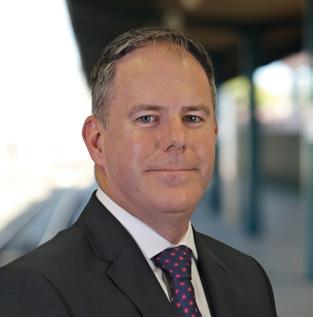
Sydney Trains Deputy Executive Director Asset Management Division, Grant Burton, recalls when the journey began in 2014.
“Our first step in this whole process was to undertake a self-assessment to identify methods to improve our asset management system, including a new framework, new policy, procedures and processes to better manage our assets and asset lifecycle,” Mr Burton said.
“2014 was also the year that the International Organization for Standardisation released its certification for asset management, ISO 55001, the international gold standard for asset management.
“We identified very early on back then that this presented an opportunity for us to become the first Australian public sector organisation to achieve this certification, which we managed to do in June 2017.”
ACHIEVING ISO RECERTIFICATION
Mr Burton said Sydney Trains has just notched up some more ‘firsts’ by becoming the first rail organisation and the first public sector organisation in Australia to achieve integrated, aligned ISO 55001 and ISO 9001 (achieved in 1992) recertification.
Getting to this point hasn’t been easy and there are a number of factors that add to the complexity of Australia’s biggest and busiest rail operator, where 1.4 million journeys are made every day on the 165-year-old network.
One major complexity is Sydney Trains’ 11,000-strong workforce, which is as diverse and dispersed as the community it serves; as are the billions of dollars of assets it manages, from train stations to overhead wiring, as well as signals, bridges and turnouts across 1,600km of track.
But change was, and continues to be, vital.
“In this time we also delivered the Enterprise Asset Management (EAM) system, which meant for the first time in Sydney Trains’ history we had all asset information in one system, providing a single source of truth for planning, execution, recording and reporting of maintenance activity across Sydney Trains’ network,” Mr Burton said.

Delivering the EAM system was a huge step for Sydney Trains, but it was just the start.
“Receiving ISO 55001 certification in 2017 was confirmation Sydney Trains was and is up to international standards in asset management. But to become a leader in the field and to ensure recertification of both standards (55001 and 9001) in two years’
September 2019 // Issue 12 www.infrastructuremagazine.com.au 22
INDUSTRY INSIGHTS
Grant Burton, Deputy Executive Director, Asset Management Division, Sydney Trains.
time required taking it to another level,” Mr Burton said.
“We’re faced with increasing external demands, such as growing patronage under tightening budgets. It’s critical we have a full line of sight of our assets so that stakeholders can work in tandem to fully optimise asset efficiency, cost, performance and risk mitigation.”
DIVIDE AND CONQUER
To achieve this, Sydney Trains set up two teams — one to align business systems, and one focused on asset maturity. Through a dedicated team of staff, Sydney Trains needed to effectively drive compliance, system alignment and alignment of all asset management functions across the organisation within the two year timeframe — in time for ISO recertification in June 2019.
The team focused on asset maturity had the task of aligning asset management functions and identifying areas of improvement to minimise knowledge and process gaps. They decided that to break the silos and bridge information gaps in such a complex organisation needed a simple, common sense approach.
They worked with stakeholders to analyse their inputs and outputs and matched them with the requirements of the next stage in the process. Through this analysis they were able to understand where there were gaps in the system, and they could then minimise the gap between what was happening on the ground and what should happen.
The team engaged more than 200 decision-making stakeholders, responsible for managing the 11,000 workforce, to move from a tick box delivery function to a common sense model where stakeholders brainstorm to resolve the varied and conflicting expectations and requirements.
This gave them a direct line of sight between asset management planning and all the downstream delivery related functions such as procurement, scheduling and site delivery. This enabled stakeholders to analyse their inputs and outputs without getting bogged down with the complexity of the process.
Through this, they put together an action plan to close the information gaps, get rid of bottlenecks and help stakeholders to operate in tandem for collective decision-making to optimally manage the lifecycle of the organisation’s assets into the future. By engaging the decision makers, the team were able to speed up the change process and implement outcomes that would benefit the entire workforce.
CUSTOMERS RECEIVING THE BENEFITS
One of the key functions of the second team, tasked with aligning business systems, was to ensure alignment of the ISO 9001 certification, which covered just the Engineering and Maintenance Directorate (approximately 40 per cent of Sydney Trains) and ISO 55001 certification, which covered the whole of Sydney Trains. The alignment of both ISO standards has allowed for effective management of the additional compliance of managing two ISO certifications.
“Through these two small teams, we’ve been able to realise many benefits such as business efficiencies, the financial benefits of cost efficiencies, reduced internal and external auditing, and improved audit outcomes,” Mr Burton said.
“The recertification has also led to better stakeholder engagement, improved team performance and effectiveness through building competence and tapping into team capability, and establishing more efficient platforms to drive further continuous improvement and business maturity.”
Receiving international recognition through ISO certification and recertification was the first step on Sydney Trains’ path to asset management excellence and with business systems in place and stakeholders engaged in the process, the tracks have been laid for institutionalising asset management at an organisational scale.
And what does this all mean for Sydney Trains’ customers?
“Ultimately, being world-class asset managers and optimising our $40 billion dollars of assets translates to increased performance in terms of reliability and punctuality, less disruption to the network and increased financial sustainability, ensuring the highest value for the community and taxpayers,” Mr Burton said.
Sydney Trains, really? Yes, really.



www.infrastructuremagazine.com.au September 2019 // Issue 12 23 INDUSTRY INSIGHTS
STRATEGY FOR WESTERN AUSTRALIA’S PORTS

In September 2017, the Westport Taskforce assembled to begin a colossal undertaking: to develop a strategy to guide the supply chains through Western Australia’s ports for the next century. As it gears up to release its five shortlisted options, Infrastructure spoke to Westport’s Independent Chair, Nicole Lockwood, about its findings thus far and where the strategy is headed.

September 2019 // Issue 12 www.infrastructuremagazine.com.au 24
INDUSTRY INSIGHTS
Nicole Lockwood, Independent Chair, Westport.
Kwinana Bulk Jetty. Image credit: Fremantle Ports.

Established in 2017 by the WA Minister for Transport, Rita Saffioti, Westport was tasked with developing a longterm strategy for the state’s freight supply chains. In order to meet growing trade need for WA’s rapidly expanding population, the WA Government understood that its supply chain needed to change.
Westport needed to select the best option for WA’s supply chain that integrates port, road, rail and intermodal freight transport, while accommodating for the specific capabilities of WA’s three major ports: Fremantle, Kwinana and Bunbury.
What makes this project so unique is its scope: Westport needed to create an integrated supply chain across a large footprint to service Western Australia for the next 50 years and beyond. In essence, the undertaking boiled down to a single question: how can WA create the capacity for its freight network to accommodate growth in containers over this timeframe?
In order to keep the supply chain as costeffective as possible, Westport’s solutions needed to be located as close as possible to where people live, but not too close as to disrupt citizens’ lives, and to ensure that the growth of urban areas could be blended with the needs for the growth in freight for the benefit of the community.
WESTPORT: THE JOURNEY SO FAR
The Westport Taskforce, a cross-agency, independent project team led by its Chair, Nicole Lockwood, spent all of 2018 conducting extensive interviews and gathering data from stakeholders and the wider WA community.
Based on these findings, it spent the first half of 2019 working through a list of 25 possible supply chains that would allow WA to grow its network capacity.
Four of these options centered on Fremantle, four on Bunbury and 17 on Kwinana. This disparity stems from the fact that Kwinana is largely a greenfield site for containers, allowing Westport to try a number of different alternatives, whereas the four options in Fremantle and Bunbury are largely fixed to the port’s pre-existing precincts.
The Taskforce spent months expanding the 25 options to understand how they would function. Westport tested them through a multi-criteria assessment process, taking into account social, economic, environmental and operational factors, as well as community and amenity impact and social license.
During this process, the Taskforce considered each option’s economic development opportunities, and their costs to run and maintain. The options were then measured against each other to rank them from one to 25.
In August, Westport released five shortlisted options that it will then take forward to a second round of analysis. At the time of print, these options had not been selected, but keep an eye out on www.infrastructuremagazine.com.au for a full overview of the five shortlisted supply chain options.
BIGGEST CHALLENGES
The second round of analysis of these five options will be similar to the first round of multi-criteria assessment, but far more extensive.
“We’ll build those five options out with a lot more detail, and a lot more granularity than the first round,” Ms Lockwood said. “This will involve understanding the port precincts and how they operate, and establishing a lot more detail around the capital and operating costs.”
In thinking through the transition from the current situation into the new end strategy, Westport will also have to undertake a more detailed analysis of some of the options’ social and environmental impacts.
Ms Lockwood said Westport was committed to providing the WA Government with a final recommendation in late 2019.
“The biggest challenge we have is time, because we want to make sure we’ve got a very robust, high-quality answer for the government by the end of the year. There’s a lot of work to do in a short space of time.”
In working to this timeframe, Westport will have to point to a number of gaps in knowledge because some of this analytical work will take significant periods of time – including multiple years for certain modelling and assessment tasks.
However, the nature of a shortlisting process means that, should the government want to proceed with any one of Westport’s options beyond 2019, there is more time to do more detailed work.
“So it’s not the end, it’s actually just a planning continuum,” Ms Lockwood said. It may even be that the Taskforce does not land on one option alone, but rather one preferred option with a secondary alternative. This is because one of the big unknowns in the process is gaining environmental approvals.
A COMMITMENT TO ENVIRONMENTAL SUSTAINABILITY
In a Westport survey of community and interest groups from late 2018 to early 2019, 55.3 per cent of respondents listed environmental sustainability as their number one area of interest, well above any other issue. Concurrently, the Westport Strategy has committed to an ISV2.0 rating from the Infrastructure Sustainability Council
www.infrastructuremagazine.com.au September 2019 // Issue 12 25 INDUSTRY INSIGHTS
of Australia (ISCA). The natural environment has therefore emerged at the forefront of debate around the Westport Strategy.
“Westport is the first masterplanning project nationally that ISCA is looking at rating. ISCA is normally involved in the project delivery phase, so this is quite new for them and for us. Together, we are thinking through what steps to take right at inception to ensure that the message and ethics of sustainability is infused in the project right from the outset.”
The Taskforce has done this by employing frameworks from the Permanent International Association of Navigational Congresses (PIANC), a global group extensively involved in innovative port planning.
Westport is following PIANC’s framework, A Guide for Applying Working with Nature to Navigation Infrastructure Projects, which proposes a reversal of traditional planning methods. The planners start with the environmental landscape, consider their infrastructure needs, then plan the infrastructure to accommodate the environment, rather than the other way around.
“For example, when we developed the 25 options, we did that with a basis of the environmental values first,” Ms Lockwood said. “We actually had them mapped, and then looked at where we thought we could locate a port, looking for spaces that weren’t impacted by important environmental areas. Then we built around those.”
This is combined with ISCA’s frameworks, which promote the engagement model Westport is employing: being open and transparent, having people at the table, and allowing for feedback.
In addition, as members of Ports Australia, which joined the World Port Sustainability Program in March 2019, Fremantle and Bunbury Ports have the support of the Program’s frameworks, networks and resources.
ENGAGING STAKEHOLDERS
Embarking on a masterplanning exercise of such magnitude inevitably involves a vast number of community engagement programs. Given how integral containers are to supporting Australians’ quality of life, the Westport Strategy will have wide-ranging impacts on the state and Australia more generally.
In order to avoid the trap of hasty, top-down planning, Westport has undertaken extensive community consultation to take into account the views of all relevant stakeholders.
“What we’re doing is planning for a network that is partially owned and operated by government, partially owned and operated by the private sector, and entirely connected to people and their everyday lives,” Ms Lockwood said. “So in trying to come up with an answer that everyone thinks is a good one, you really need to have all of those views at the table.”
Westport’s stakeholder engagement is evidence-based and the Taskforce has taken this approach in order to encourage private sector investment and ensure confidence in the strategy.
Westport created a reference group, which currently includes over 90 organisations – about 35 local governments, as well as community groups and members from academia.
This has allowed Westport to continually test its work. While some of the technical work had to be completed by technical experts, the reference group gives Westport the opportunity
to understand the different outcomes – how they might be implemented by private sector, and how they might be received by the community, were they to be pursued.
“Stakeholder management adds a lot of value to our process,” Ms Lockwood said. “In some ways, it mitigates risk in the project even though it’s more involved. You’re potentially having numerous difficult conversations, you’re not landing on one answer, and you’re navigating how to deliver it. We’re really on that journey the whole way through.”
LEVERAGING OLD KNOWLEDGE TO INFORM NEW THINKING
Community feedback is only one part of the data that the Taskforce must gather and analyse. Another major part of the process involved bringing together decades of previous work.
The question of the future of WA’s terminals had been posed many times before, however, these discussions usually only related to the ports themselves, not in relation to the whole supply chain. Since a lot of technical reports on road designs, port designs and environmental work was still valid (albeit in need of an update), the Taskforce catalogued and compiled all this previous research, so as not to spend more government funds than necessary.
The next stage involves consolidating these years of knowledge with new, forward-thinking work.
“There’s a new landscape now that maybe wasn’t in existence then,” Ms Lockwood said. “There are new trends emerging – globalisation and the trends of containers. We’re 50 years into containers being established, so what will the next 50 hold? What’s the future of movement in terms of both road and

26 www.infrastructuremagazine.com.au
INDUSTRY INSIGHTS Fremantle Harbour. Image credit: Tourism WA.
rail, and how are those modes going to change?
“In terms of port design, the automation journey around the world is certainly going very quickly. When designing a new port you really need to be thinking about the opportunities those new builds present. So there has to be new work done thinking that through.”
COLLATING VAST AMOUNTS OF DATA
In order to manage this vast amount of information, the Taskforce built a Geographic Information Systems (GIS) database where it can enter all of its information – both past and present. A dedicated team maps all of the outputs produced and layers them, creating sophisticated, interactive resources to guide decision-making.
All existing data sets across government; detailed data from relevant agencies; environmental assessment work, terrestrial work; and the 25 supply chain options have all been mapped and catalogued into this database.
“The other critical part is the trade forecasting work we’ve done, because that’s really the growth factor that we need to consider in terms of timing,” Ms Lockwood said. “When do we need new infrastructure? So that’s also a component of what they’ve created.”
In this way, the second stage of multi-criteria assessments of the five shortlisted options will involve two parallel processes – both analytically, crunching numbers and data, and also spatially, mapping the outputs. This will allow the Taskforce to test a given set of questions and then test it using the database.
“When we finish, we will be able to hand this database to government and it’s got everything built in,” Ms Lockwood said. “This means that if the work needs to store for a little while, or if there’s a change in economic circumstances, we’ve not lost all of that work, and it’s actually refreshed a lot of things that have been buried over a long period of time.”
It also means that as the trade forecasting changes, the WA Government can continue to update the database to understand exactly what the changes mean for trigger points.
This spatial database will also be updatable into the future. The detailed modelling that will need to be done beyond 2019 – road modelling, environmental impact assessment work and so on – could be built into the platform.
FINDING THE BEST WAY TO GUIDE CHANGE
“Change is inevitable,” Ms Lockwood said. “Doing nothing is not an option; there is the requirement to build new infrastructure, as well as optimising what we have. What we’re trying to ensure is that we get the balance right between any new impacts and maintaining amenity.
“I think Perth and Southwest Australia are at a tipping point, where we’re growing to the size of some of the larger cities around the world and that means a different way of living. People’s expectations need to change about what’s realistic if they want to continue to receive the services that they expect – particularly around things like online shopping and other current trends.
“The way we want to live our lives has a cost associated with it, and that may mean a slightly different way of running our freight sector than people have seen in the past.”
The ultimate aim of the Westport Strategy is to ensure its final recommendation to the WA Government will be the best option for the state, and safeguard quality of life for decades to come.
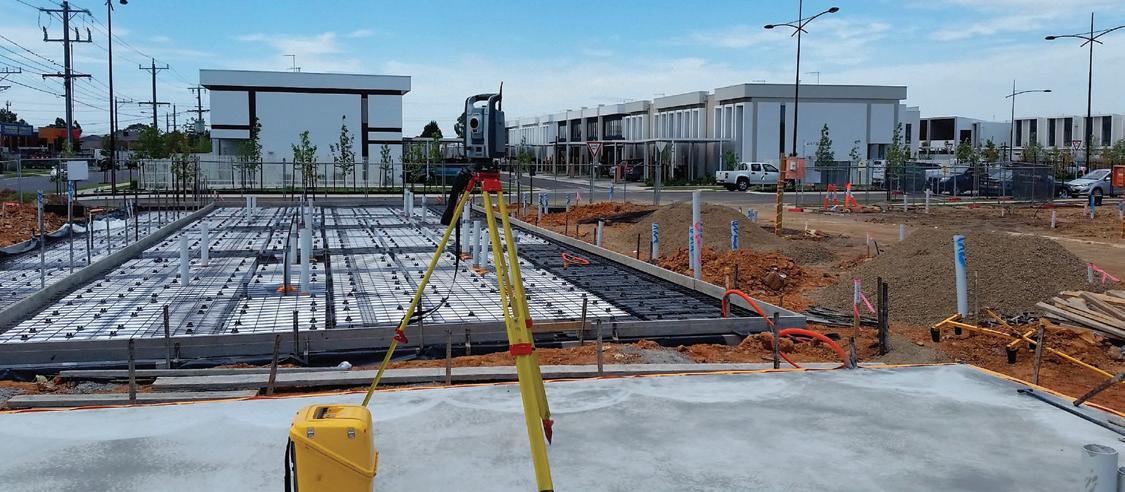
Mobile Laser Scanning
• Terrestrial Laser Scanning
• 3D Modelling and BIM
• Drone mapping
• Z boat hydrographic surveys
• Virtual and Augmented Reality Solutions
• TIMMS (Trimble Indoor Mobile Mapping System)
preliminary development estimates
• servicing advice on master planning
• roads, earthworks, drainage, sewer and water main design
• water quality modelling
• construction surveillance, field audits
• site and environmental management plans
www.infrastructuremagazine.com.au September 2019 // Issue 12 27 INDUSTRY INSIGHTS
For your turn-key spatial solution visit www.taylorsds.com.au
QUEENSLAND’S FUTURE INFR ASTRUCTURE PIPELINE

Job-generating infrastructure, investment opportunities and better services are coming down the pipeline in Queensland’s 2019-20 $12.9 billion capital program. This will support 40,500 jobs, including 25,500 outside of Greater Brisbane.
The annual update of the Palaszczuk Government’s State Infrastructure Plan (SIP) highlights the essential infrastructure including roads, rail, schools and hospitals being delivered as part of the $49.5 billion commitment over the next four years – up $3.8 billion on last year’s figure.
This financial year sees $9.2 billion allocated to economic infrastructure and $3.7 billion for social infrastructure, with 60 per cent being spent outside Greater Brisbane, where it will support more than 25,000 jobs.
Underpinning this investment are the government’s priorities to:
♦ Create jobs in a strong economy
♦ Give all children a great start in life
♦ Keep Queenslanders healthy
♦ Keep communities safe
♦ Protect the Great Barrier Reef
♦ Be a responsive government
The SIP shows how projects are progressing through the pipeline, from concept to business case to reality.
In total, there are 162 infrastructure proposals in the planning phase of the 2019 pipeline, with 67 new proposals. Forty proposals have moved from planning into delivery since 2018 and will be delivered in the next four years.
Since 2015, the Queensland Government has focused on reducing capital program under-expenditure and is forecast to achieve a near-zero per cent underspend for 2018-19, the best performance in ten years.
During this time, more than 207,000 new jobs have been created.
Queensland’s strong infrastructure program underpins and unlocks private sector investment, and its $147 billion pipeline is the nation’s second largest, as reported in the March 2019 Deloitte Access Economics Investment Monitor.
The State Government works closely with the private sector to maintain this investment momentum and to ensure a highly skilled and adaptable workforce is ready to deliver the infrastructure pipeline.
Queensland’s overseas goods exports hit a new 12-monthly record of $85.8 billion to May 2019 – up more than 16 per cent on the same time last year. Minerals exports alone increased $1.2 billion to $10.6 billion, driven by rises in the value of aluminum, zinc, lead and copper.
More than $20 billion worth of new investment in natural resources has been attracted in the past four years, and 44,000 square kilometres of land are earmarked for resource exploration.
The state’s reputation as an energy powerhouse through gas, solar and wind is expanding as it leads a global revolution in renewably produced hydrogen.
September 2019 // Issue 12 www.infrastructuremagazine.com.au
INDUSTRY INSIGHTS // PARTNER SOLUTIONS 28
Planning approvals are being streamlined to help business cases and project opportunities transition to reality faster.
New state development and priority development areas have been declared to facilitate large scale and heavy industries growth, and the accelerated delivery of community developments.
The Queensland Government has also developed a Strategy for Social Infrastructure to help build thriving and inclusive communities with agile and responsive social infrastructure that grows with its residents.
The strategy, supported by a best practice guide, takes a place-based approach for social infrastructure planning and delivery that is built on stronger cross-agency collaboration to provide easily accessible, well-located and flexibly designed infrastructure that can be adapted to changing needs as Queensland’s
The State Infrastructure Plan at a glance
population continues to grow past the five million mark.
This 2019 update of the State Infrastructure Plan (SIP) Part B: Program contains all the projects and achievements, with maps and case studies, that reflect Queensland’s infrastructure investment priorities across regions, industry and community – creating the right conditions to unlock private investment, economic growth and jobs.
» $49.5 billion infrastructure program over the next four years
» Supporting 40,500 jobs in 2019–20
» $23 billion for Queensland Transport and Roads Investment Program over four years
» Cross River Rail (including commencement of tunnel and station works)


» $686 million to build and upgrade hospitals and health facilities in 2019-20
» $215 million for Townsville’s Haughton Pipeline in 2019-20
» $28.7 million for Indigenous Councils critical infrastructure program in 2019–20.
View the State Infrastructure Plan (SIP) Part B: Program at www.dsdmip.qld.gov.au/SIP.

Invested in Queensland’s infrastructure
• $23 billion for Queensland Transport and Roads Investment Program over next four years
• $686 million in 2019–20 to build and upgrade hospitals and health facilities.

www.infrastructuremagazine.com.au September 2019 // Issue 12 INDUSTRY INSIGHTS // PARTNER SOLUTIONS 29
North Queensland Stadium
Connect with us @GrowingQld
DIGITAL OVERLAYS

FUTURE INFRASTRUCTURE
by Susan Harris, CEO, ITS Australia
One of the most important things to consider when planning and building our cities, transport assets and critical infrastructure is to integrate digital engineering into all stages of the process. While the implementation of a lot of new technologies is still a work in progress, ITS Australia highlights some of the digital architecture that companies need to be thinking about and implementing in their operations.
Australia is currently seeing very large investment in the development and delivery of major transport infrastructure across the nation. The delivery of efficient and effective transport networks is integral to the economic success of our nation, now and into the future. From major roads projects underway around the country, to the recent opening of the Sydney Metro and ACT Light Rail, the current scale of investment into transport infrastructure is enormous. Over the next ten years, Australia’s state and federal governments will invest $100 billion in transport infrastructure across the nation. This program of work is vital for our expanding urban and regional centres, and to prepare for emerging and future transport technologies. However, it is imperative that
September 2019 // Issue 12 www.infrastructuremagazine.com.au 30
INTELLIGENT TRANSPORT SYSTEMS (ITS)
OVERLAYS AND


INFRASTRUCTURE
both the design and construction of these major roads, rail networks, light rail systems and other transport developments be built for the future.
The integrated development of digital engineering is necessary from the early planning and design stages, through to construction and implementation, and of effective asset management systems. Intelligent Transport Systems need to be built into all stages of transport infrastructure to ensure we build for the networks of tomorrow. This includes building physical and digital infrastructure into which emergent and future technologies can be integrated, ensuring safety, security, connectivity and multi-modality.
Whilst some of the specific technology
choices are as yet undetermined, there are important elements that require national architecture and development to enable “no regrets” investments that are platform agnostic. These include, but are not limited to:
SUITABLE COMMUNICATIONS
Enabling a nationally integrated C-ITS ecosystem that leverages multiple wireless communications technologies including DSRC, WiFi, Bluetooth, 4G/5G and Satellite to enable the best ‘fit-forpurpose’ communications architecture.
HIGHLY ACCURATE MAPPING
Creating high-accuracy maps based on reference points on 3D models of the road and infrastructure environment.
These maps need to be updated continuously with real-time information, conveyed utilising sensor data from onroad vehicles, about traffic, roadworks and any other information critical to the safety of road users, now and in the future.
HIGHLY ACCURATE POSITIONING CAPABILITY
Enabling precise, centimetre-level position determination, integrated into the vehicle sensor network. This positioning capability will be essential to create a digital infrastructure ecosystem within which Connected and Automated Vehicle (CAV) technology can be safely and successfully deployed. These developments will likely use positioning
www.infrastructuremagazine.com.au September 2019 // Issue 12 31
INTELLIGENT TRANSPORT SYSTEMS (ITS)
ITS Australia CEO, Susan Harris.

techniques based on Global Navigation Satellite Systems (GNSS) such as Global Positioning System (GPS), cellular network infrastructure, or on the integration of the two technologies.
SECURITY BY DESIGN
Within technological systems, addressing vulnerabilities and patching security holes as they are found can be a difficult process and will never be as effective as designing systems to be as secure as possible from the start. Security by Design is a ground up approach based on proactively embedding security into the design and operation of IT systems, networked infrastructure and business practices. As we increasingly move toward the Internet of Things (IoT), Security by Design will become a critical consideration in the initial stages of product design and manufacturing and will offer increased protection of the confidentiality, integrity and availability of user information.
DIGITAL TWIN FOR VIRTUAL ASSET MANAGEMENT
Digital twin is a dynamic, up-to-date and accurate virtual model of an existing physical asset. The digital twin provides asset owners with real-time data about how their asset, equipment or product will function under various conditions. It enables them to make informed decisions based on facts, rather than assumptions about how a product should perform. Digital twin technology provides organisations with valuable information that they can use to monitor an asset, schedule repairs and make
improvements based on the results that are delivered.
EDGE DEVICES
Edge computing allows data produced by IoT devices to be processed closer to where it is created instead of sending it across long routes to data centres or clouds. Computing closer to the edge of the network lets organisations analyse important data in near real time.
Edge computing will be essential to the successful and safe deployment of CAVs. Effectively, CAVs will function as edge devices, analysing and processing enormous amounts of data in real time so that vehicles are piloted safely and efficiently.
The advancement of connected and automated vehicle technology and the appropriate deployment of the technology is a pathway to provide safer, more efficient and more sustainable transport.
Safety needs to be the foundation on which any development of Connected and Automated Vehicles (CAV) rests. We are optimistic about the innovation and expertise in our industry and the functionality that will be available to the wider community.
These technologies have the potential to revolutionise transport in a way not seen since the mass production of the private vehicle more than 100 years ago and to save thousands of lives.
It is critical that governments establish very clear regulations which are performance-based, to ensure that the deployment of CAVs is guided to improve the safety and quality of life of the community. Governments need to
About ITS Australia
provide regulatory oversight to give the public confidence in CAV testing and deployment, as well as data sharing.
While the mass production of private vehicles obviously had a stunning impact on society and the built environment, the advent of connected and automated vehicles and other revolutionary technologies offer the potential for even greater levels of disruption.
Transport innovation like ‘Mobility as a Service’ (MaaS) offers the potential to drastically improve customer choices, reduce travel costs, increase network capacity and transport sustainability while improving social and environmental outcomes.
Concepts like MaaS and evolving our transport networks are ways we can adapt to and positively leverage societal and technological disruption.
A key component of MaaS is the integration of planning, booking and payment into one seamless customer interface. This is a complex process involving many closed back end systems and proprietary platforms. From the customer perspective, this interaction will need to be simple and frictionless.
To enable competition for MaaS, a level playing field should be provided to ensure reasonable access to potential players. This will require the standardisation of a range of systems that are currently closed or siloed. As we are in the embryonic stage of these new transport delivery models, we anticipate that both perceptions and realities will evolve as we start to experience MaaS, and further advance on-demand transport in Australia.
ITS Australia is a membership-based peak body representing Australian industry, government and research organisations in promoting Intelligent Transport Systems initiatives. We are a Not-for-Profit association and serve the interests of our members in Australia and globally. We represent the Australian ITS sector within Australia and Australian ITS interests internationally.
September 2019 // Issue 12 www.infrastructuremagazine.com.au 32 INTELLIGENT TRANSPORT SYSTEMS (ITS)
POWER: WHEREVER YOU NEED IT, WHENEVER YOU WANT IT
In certain markets and geographies, connection to the power grid is either not available or just too expensive over many kilometres to run cables and install conventional poles. In these instances, the Independent Smart Pole (ISP) offers a reliable, consistent, tested and certified rechargeable energy source that supports a range of applications.
The ISP is a 24/7 off-grid DC power pack designed for standalone use anywhere, at any time – be it remote areas or in metropolitan regions. The ISP provides reliable off-grid power for critical applications.
Combining efficient wind, solar and batteries, the ISP has the capacity to store energy for up to ten days without wind or sun. This makes it completely self-sustainable in an off-grid setting. An installed base provides solutions for rail, environmental monitoring, mining, traffic management, construction sites and surveillance among others, changing the game for customers across the globe.
One example of the ISP’s application is at remote rail crossings. An LED sign board is attached to the ISP, 500m prior to the crossing. When an approaching vehicle is detected, the sign automatically switches on and flashes to warn the driver. Another unit is installed around 200m from the crossing. If a train is approaching, the sign’s text will change accordingly, and the ISP will floodlight the crossing.
ROBUST SYSTEM FOR OPTIMAL ENDURANCE
The ISP is engineered to provide sufficient battery endurance when wind and solar generation is low. Battery performance can be remotely monitored via the hybrid controller. In the unlikely event that batteries become excessively discharged, an alert is sent calling for remote intervention.
Depending on user configuration, the ISP1 and ISP2 will provide 40W or 80W of continuous power respectively, 24/7. There is enough redundancy built into the system to provide continuous power for three days without further solar or wind generation. This is achieved by using a 400W wind turbine generator plus two photovoltaic panels on each model.
The wind-solar hybrid successfully powers a range of highly efficient and functional applications using its AGM/LiFePo4 battery technology. The software can conserve energy by
controlling the load on/off times and load power levels where appropriate. It can then increase the power for the period required. After the requirement is met, it can then reduce the power again.

POWER Wherever you need it Whenever you want it
KEY BENEFITS
Off grid power solutionup to 80W continuous power 24/7 * Provides secure, reliable off-grid power for critical applications, including:
• Environmental Monitoring
• Mining
• Rail Crossings
• Traffic Management
• Construction Sites
• Communications
• Surveillance
• Public Safety
• Lighting etc.
CE Certified/Designed to UL standards. Substantial immediate savings by avoiding trenching and cabling.
FEATURES
Remote performance monitoring and controlling via 2G / 3G / 4G and Zigbee connection.
Smart energy management.
Easy installation.
Pole

9.1m pole, galvanised and powder coated for 20 year design life.
To see a real world installation go to:
* Note:



www.infrastructuremagazine.com.au September 2019 // Issue 12 33
24/ 7 OFF
Independent Smart
A HYBRID WIND AND SOLAR POWERED UNIT WITH BUILT-IN RECHARGEABLE ENERGY STORAGE
GRID CONTINUOUS POWER*
For further information contact: TrafficSensors.com Tel: (07) 5444 2910 email: sales@trafficsensors.com
https://youtu.be/ML60fW6TDYY
24/7 OFF GRID Continious Power subject to site assessment
INTELLIGENT TRANSPORT SYSTEMS (ITS) // PARTNER SOLUTIONS
ALL ABOUT THAT ACE
The age of connectivity has turned out to be the age of complexity. While the promise of the so-called Internet of Things (IoT) era is anchored in the vast amounts of useful data being generated, the challenge has always been our ability to actually put it to use.
Instead of the IoT generating trillions in value, business and industry have been confronted with a different reality — the sheer volume of data generated daily by connected things has defied our ability to capture, store, see, understand and put it to work.
While the upside of the IoT remains as promising as ever — with connected “things” becoming smarter and more ubiquitous — if we are ever to realise this enormous potential, businesses must tame the complexity they are generating by their very own IoT strategies and the enormous amounts of data they create.
Hexagon is focused on the real IoT breakthrough, uncovering the world-changing solutions that hide in plain sight behind the mountains of data we create every day. To realise this promise, we can’t rely on the technologies of the past.
THE NEXT EVOLUTION WILL BE DRIVEN BY AUTONOMY
The single greatest need in business today isn’t automation; it’s autonomous insight. This means much more than operational line of sight — it means being able to leverage vast amounts of data behind the scenes, where connected devices and machines interpret what’s happening and why, and then act accordingly, autonomously.
The shift from automation to autonomy is so monumental, so critical to our collective future that the simple notion of “putting data to work” is our singular focus at Hexagon. This is key as more and more of our customers are eager to move beyond automation and embrace technologies — a trend we are uniquely positioned to deliver on.
This is the future we are enabling. We call it Autonomous Connected Ecosystem, or ACE for short.
This is the real value of IoT: to connect, automate and ultimately ‘autonomise’ entire ecosystems that can self-optimise performance and self-adapt to — and learn from — new conditions in real time to autonomously run entire processes.
THE FUTURE BELONGS TO ACE
The power of an ACE is its ability to evolve and grow along with the changing needs of each business ecosystem — whether an autonomous smart factory, city or fleet of vehicles. ACEs enable organisations to adapt to change in ways that would have been impossible before.
This will embed the power of disruptive technologies such as AI, edge-cloud orchestration, mobility and data visualisation, to name a few, in the hands of every customer.
With the acquisition of BricSys earlier this year, Hexagon PPM can now provide the AEC market with an end-to-end platform to connect, automate and ultimately ‘autonomise’ the entire building and construction ecosystem.
Other acquisitions such as EcoSys, J5 International and Continuum Edge, mean Hexagon PPM is rapidly building on its 50 years’ experience providing digital solutions in the space of the connected worker, shift handover, fabrication, completions and enterprise project performance. We’re also addressing the need of capital projects to have effective communication and collaboration through the secure exchange of information deliverables between project stakeholders with HxGN SDx™ Projects and Operations.
This SDx™ technology provides a project-wide, web-based submission, validation, distribution, and review of data and document deliverables. A data centric “digital twin” of the facility can be viewed and navigated to locate relevant data and documentation in context. Electronic workflows, distribution rules and subscriptions ensure the correct and consistent review of deliverables with auditable traceability. In turn, this reduces project costs, time to completion and risk.

SHAPING SMART CHANGE HAS NEVER BEEN MORE IMPORTANT
For the first time in history, it’s possible for companies to unlock and harness the full potential of their data. This is the real promise of IoT, and this is where Hexagon is doing its greatest work — shaping smart change.
To see how HxGN SDx™ Projects can digitally transform your asset lifecycle, download the whitepaper at http://bit.ly/2G7KCNY. For information on all of Hexagon PPM’s solutions, visit hexagonppm.com.
September 2019 // Issue 12 www.infrastructuremagazine.com.au 34 INTELLIGENT TRANSPORT SYSTEMS (ITS) // PARTNER SOLUTIONS
Over 1,250 attendees and 90 exhibitors from Asia Pacific and surrounds


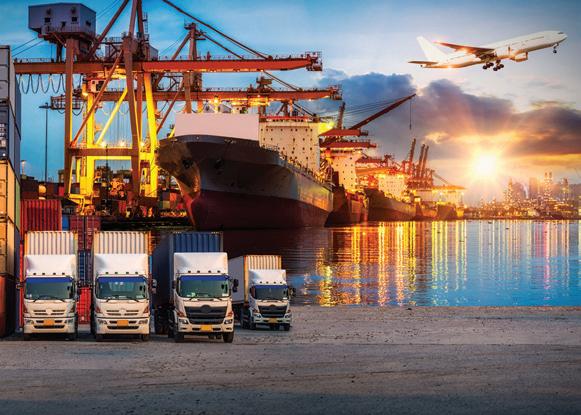

The 4 day forum will include a strong industry program including tours and demonstrations, an exhibition as well as an exciting social program.
The 17th ITS Asia Pacific Forum 2020 theme of “ITS Innovation Creating Liveable Communities” will demonstrate Australia’s new initiatives and adapted learnings from the advances of our neighbouring mega cities. Key topics to be covered included MaaS, Autonomous Vehicles, Data Analytics and network development.
Hosted by
Register now itsap2020.com
INTELLIGENT TRANSPORT
SYSTEMS HIT THE ROAD IN NSW

With more than 12 million people expected to live in NSW by 2056, demand on the transport system across the state will significantly increase, which is why Transport for NSW is investing in new technologies now to support future needs and expectations.
The strategy highlights the power of, and reliance on, technology in everyday life and poses the question, ’How can technology be used to make the movement of customers smarter, easier and more reliable?’
“Future Transport 2056 is the first plan to consider how we harness rapid advancements in technology and innovation to transform the customer experience and boost economic performance across NSW,” Transport for NSW Executive Director Sydney, John Hardwick, said.
“As transport needs and demands rapidly change across the most populous state in Australia, we have highlighted the immediate need to create data-driven, intelligent transport networks which will encourage a more efficient, flexible and dynamic service.”
NSW’S FIRST SMART MOTORWAY
While Future Transport 2056 is a strategy for the multi-modal transport system of the future, Transport for NSW has already put it into action. Work is well underway on the first smart motorway in NSW which will introduce intelligent technology to one of Sydney’s busiest motorways by the end of 2020.
NSW Minister for Transport and Roads, Andrew Constance, said the $600 million M4 Smart Motorway project will provide a tailored technology solution, through intelligent transport systems, to create a better travelling experience and a more consistent journey.
Technology has become the centrepiece for Transport for NSW and Future Transport 2056 – a 40-year vision for an integrated and multi-modal transport system across NSW – which will aim to support the 28 million commuter trips expected to be taken each day by 2056.
“The M4 Motorway is one of the busiest in Sydney and is often congested for up to 13 hours a day, so the introduction of intelligent transport systems will help to maximise the performance of the motorway and provide motorists with more reliable trips so they can spend less time on the road,” Mr Constance said.
“More than 150,000 vehicles travel along the M4 Motorway each day and the volume of traffic is only expected to increase as Western Sydney grows into one of the most populous cities in Australia.
“Given the amount of work which needs to be carried out to implement
September 2019 // Issue 12 www.infrastructuremagazine.com.au
36
INTELLIGENT TRANSPORT SYSTEMS (ITS)

the first smart motorway in NSW, the project is being delivered in stages to help limit disruption along the motorway while crews work hard to install intelligent transport systems and upgrade existing road infrastructure along a 35km section.”
IMPLEMENTING NEW ITS TECHNOLOGIES
Work on the project is progressing well, with the first stage almost complete. This stage involved building an additional lane in each direction between Roper Road and the M7 Motorway to provide more capacity and improve traffic flow.
Extensive work has also been carried out to upgrade key interchanges along a section of the motorway which included realigning and widening existing ramps to accommodate the new ramp signals to allow vehicles to enter the motorway in a steady and controlled manner.
Installing an array of intelligent transport systems along one of the busiest roadways in Sydney has proven challenging, with work on the project being carried out within live traffic conditions and at busy interchanges where thousands of motorists travel each day.
Contractors Fulton Hogan and Seymour Whyte are working hard to complete the project in 2020.
“As all aspects of technology become more personal and userfriendly, transport users also have the expectation their journeys will become more personalised, which is why intelligent transport networks are a key
focus of Future Transport 2056,” Mr Hardwick said.
“This project is making the strategy a reality, with the NSW Government bringing together a number of intelligent transport systems including ramp metering, electronic message signs, traffic sensors and lane use signs to one place to maximise the performance of the motorway and provide more reliable journeys.
“An overarching adaptive system known as a Managed Motorway System will bring together all of the newly installed intelligent transport systems, which will talk to each other and automatically adjust to incidents and congestion without a manual operator intervening.”
GANTRIES, RAMP SIGNALS AND TRAFFIC SENSORS
Motorists travelling along the motorway today will already see some of the infrastructure for these systems in place, including ramp signals at a number of entry ramps, as well as some of the massive steel gantries which will hold lane use signs and variable speed limit signs.
More than 40 gantries are being progressively installed to complement existing and new electronic message signs along the motorway and approach roads. These will inform motorists about expected travel times and traffic conditions ahead, allowing them to better plan their journey or choose an alternative route.
The gantries will be able to manage the use of the motorway by
automatically changing speed limits when traffic sensors detect particular traffic volumes, and close lanes to manage traffic flow when incidents occur.
Ramp signals are an important feature of the project as they will help regulate traffic entering the motorway and control the flow of vehicles trying to merge at the same time. This will result in less stop-start traffic and sudden braking at some of the most congested points along the motorway.
These signals will work hand in hand with newly installed traffic sensors by using the information provided to automatically switch on in peak travel times or when traffic reaches a certain level.
“Smart motorways have already been implemented in Melbourne, Auckland and further across the globe, so Transport for NSW is always looking at international intelligent transport solutions to further inform user experiences,” Mr Hardwick said.
“Once complete, this project will influence the way transport planners shape transport systems across Sydney and NSW, including key arterial roads and motorways – the M4 Smart Motorway project will be the blueprint for Sydney’s future motorways.
“Using complementary technologies to create a fully managed motorway is the first step towards easing congestion, reducing crash rates by up to 30 per cent and keeping motorists more informed while they move around the extensive NSW road network.”

www.infrastructuremagazine.com.au September 2019 // Issue 12 37
INTELLIGENT TRANSPORT SYSTEMS (ITS)
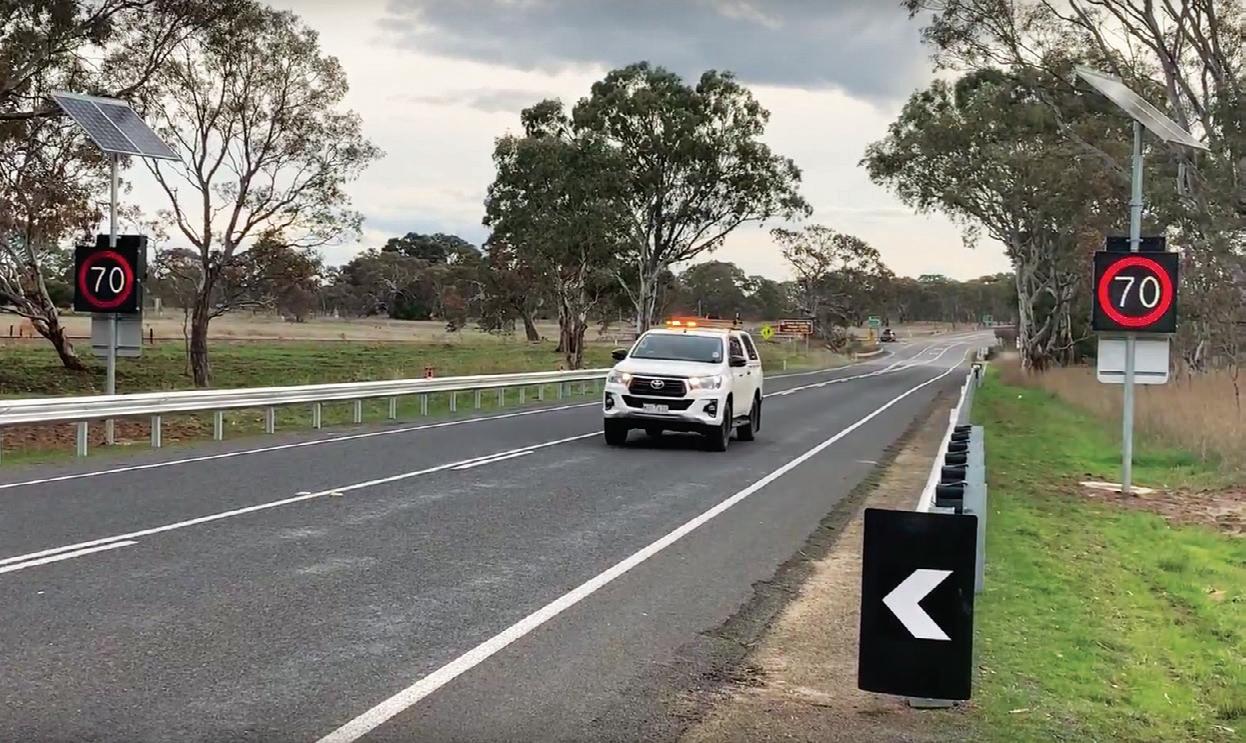
SAFETYAND SIDE ROADS
Road infrastructure systems and Intelligent Transport Systems (ITS) have a significant impact on the safety of motorists. The Side Road Activated Speedsign is one way of saving lives through clever system design, as it includes the integration of sensors and visual messaging through illuminated speed signs.
Side Road Activated Speeds (SRAS) systems are an innovative method to reduce crashes at intersections in rural areas. The system will detect when traffic is attempting to cross the intersection, then switch on signs that reduce the speed from an indicated speed. This allows for more reaction time and increases the gap for drivers to cross the intersection or turn onto the road. The SRAS is an active system that replaces static warning signs in a manner that is adaptable to the traffic requirements of the location.
Rather than permanently dropping the speed near the intersection, the active system will only reduce the speed when traffic is present at particular locations. This minimises disruption on the high speed lanes of the road, but also creates a more visually noticeable speed change to drivers nearing the intersection. The lower speed of the intersection will not only decrease the risk of crashes, but also increase survivability.
REDUCING CRASHES IN REGIONAL AREAS
The Victorian Government is increasing its commitment to road safety through smarter systems with programs such as the joint TAC and VicRoads Safe System Road Infrastructure Program (SSRIP) and the Safer Roads Projects in conjunction with Towards Zero.
As reported in a recent article published by the RACV, in the past five years over 70 per cent of fatal crashes at intersections in regional Victoria happened on high speed roads. Furthermore, this risk increased where the minor roads met the main roads.
A new trial by Hi-Lux Technical Services, an Australianowned manufacturer and supplier of quality LED Signs, Traffic
Management Systems and associated Control and Detection equipment, is a first for the new standard of SRAS systems installed in Australia.
As Australia has a significant amount of high speed main roads connecting its rural communities, there are many intersections that would benefit from the installation of the SRAS systems, especially where communities are attempting to reduce the deadly road toll.
As this trial involved installing some of the first of these new systems, getting the timing right for the location was a process of calculation, adjusting based on real world feedback from traffic activity, and coordination with VicRoads. As the system was connected through a 4G connection back to base, in addition to its connection to the STREAMS system, it was a simple matter for the software engineers at Hi-Lux to modify the existing system based on the clients’ request.
Hi-Lux was able to provide the SRAS system that was designed in-house, using Australian Standard VSLS signs, and software systems that could be catered exactly to the clients’ needs. This also made it easy to develop custom requirements based on the changing circumstances, tuning the system once it was in place. Hi-Lux was also able to install all civil works, taking care to manage the site according to environmental and situational requirements.
BUILDING UP
Hi-Lux develops smart traffic management solutions that incorporate the latest technology for sensing and detecting traffic, and produces its own in-house signalling and sign systems. With a focus on high reliability, low-power, solarbased systems, they can be installed in metropolitan or rural areas with a minimal installation process.
September 2019 // Issue 12 www.infrastructuremagazine.com.au 38
INTELLIGENT TRANSPORT SYSTEMS (ITS) // PARTNER SOLUTIONS
Hi-Lux is committed to local production and works with Australian suppliers and manufacturers to bring a distinctly reliable and Australian product environment, with local support and warranty. What this means for their customers is a commitment to working with local, state or federal governments to provide highly reliable systems that are backed up by Australian standards, specifications and the knowledge of professionals that have decades of experience in the design, operation and installation of intelligent road infrastructure.
LONG-TERM ITS EXPERIENCE
Another major product that is having a significant impact on the industry is Wide Area Network Vehicle Message Signs (WANVMS) which are large signs using high visibility and high reliability LEDs to display information to motorists. These have been installed in both Victoria and South Australia, and are used to display arterial road travel times. This time is sourced from online map and traffic flow services in conjunction with the state’s road authority.
Congestion Monitoring Cameras are also key in increasing road safety and their series of IP cameras have been placed near intersections throughout Melbourne. Installing them often requires the shutdown of intersections, hence speedy installation and commissioning is a direct benefit to the public.
Hi-Lux installed over 200 cameras to assist in monitoring the congestion caused by other infrastructure works such as Victoria’s level crossing removal project.
SUSTAINABLE TECHNOLOGIES
In recent years there has been a greater emphasis placed on remote sites using standalone power systems. Hi-Lux has installed many solar-based systems that will operate with minimal maintenance for more than ten years. The growth in off-grid ITS devices will continue to increase as the cost savings of solar systems outperforms the installation of mains-based devices. For example, a solar-based system that consists of a solar panel, battery box and the device operating may only involve the civil works required for a single pole.
AN INTEGRATED APPROACH
With the increasing need to implement infrastructure with smaller cost margins, using vertically-integrated services becomes more valuable – both in time, investment and ongoing maintenance. Hi-Lux Technical Services is a vertically
integrated ITS company, so it’s able to design and manufacture signage systems as well as install and maintain them. This allows Hi-Lux to be a single source for getting ITS built, installed and maintained for the long term.
Hi-Lux is also an SRAS manufacturer, so it can provide continuing support to the installed sites and the continuing operations of the equipment.

While other groups have just recently entered the world of interconnected infrastructure, Hi-Lux has been building and installing IoT devices that have been running, often unattended and functional, for more than 20 years.
Hi-Lux is also an advocate for open standards that allow interoperability between multiple manufacturers. It adheres to all Australian and New Zealand standards, while also working with state road authorities to meet their specifications. With the development of more advanced ITS requirements, implementation is always going to be a moving target.
Working with other organisations, Hi-Lux has integrated its technology into its own systems which has assisted with getting new sites developed fast, and installed with minimum effort.
As many states around Australia invest more heavily in infrastructure, it is imperative that long-term participants in the industry continue to assist in the implementation of ITS operations.
Governments must take note of the overall cost of installation, as well as the ongoing costs associated with sub par equipment. Hi-Lux has a commitment to quality and this is evident in the long-term installations of equipment, which include over 2000 ESLS units deployed in Victoria that have been operating with an industry-leading low failure rate.

Australian owned and operated
Hi-Lux Technical Services was started by Sam Sozio in 1991, primarily as a traffic signal maintenance company, then progressively applying its expertise in other fields. It now provides a complete range of products and solutions to the traffic signal industry and government departments throughout Australia. For assistance with the design, manufacture or installation of high reliability ITS products and signage, please contact Hi-Lux Technical Services and they are ready to work with you. Call 03 9462 4633 or visit www.hlts.com.au.
www.infrastructuremagazine.com.au September 2019 // Issue 12 39 INTELLIGENT TRANSPORT SYSTEMS (ITS) // PARTNER SOLUTIONS
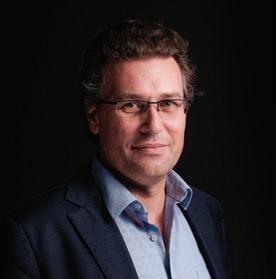

Innovations in Australian intelligent transport systems mean that newer and better applications are emerging to help shape the future of transport technology. Transport Certification Australia’s (TCA) new tool, Road Infrastructure Management (RIM), collects road use data from vehicles to help managers optimise the management of road networks.
ROAD USE DATA COLLECTION OPTIMISING NETWORK MANAGEMENT
by Gavin Hill, General Manager Strategy & Delivery, Transport Certification Australia
INTELLIGENT TRANSPORT SYSTEMS (ITS)
40 September 2019 // Issue 12 www.infrastructuremagazine.com.au
Gavin Hill, General Manager Strategy & Delivery, Transport Certification Australia.
Transport Certification
Australia has forged a reputation in its offerings of telematics monitoring and assurance applications, including the Intelligent Access Program (IAP).
There was a time when the IAP was the only form of regulatory telematics monitoring in Australia, managing higher risk vehicles and loads on the road network. However, it has become evident that transport operators and road managers are interested in other telematics applications that meet requirements beyond the monitoring of heavy vehicle operations against set access conditions.
The Road Infrastructure Management application (RIM) is a new offering that is a shift from regulatory telematics. RIM offers a new way of collecting road use data from vehicles to help road managers optimise the management of road networks. By focusing on ‘big data’ from a larger number of vehicles, road managers are able to better understand the planning, investment, maintenance and other needs of their road networks. RIM supports the right level of assurance needed for road usage reporting. For example, the RIM application allows transport operators to use whatever telematics device and systems they have in their vehicle, rather than requiring certified or approved devices.
HOW RIM WORKS

RIM enables the collection of road use data from a vehicle fitted with a telematics device through a service provider. The data is de-identified and aggregated to ensure individual operators and vehicles can’t be seen. It can be used with other applications of the National Telematics Framework, where needed to meet the conditions and requirements of road managers.
RIM allows TCA to produce
specialised reports on road usage, for example heavy vehicle traffic across a bridge, peak times of travel on certain routes, average vehicle speed at a particular location, or common stopping places for rest breaks.
These and other types of relevant data available through RIM can help inform road managers on transport maintenance, planning and investment decisions. Through RIM, governments and local councils may also be better informed to anticipate the risks of urban encroachment on high access routes for high productivity heavy vehicles and to apply the right futurefocused infrastructure planning.
six-month trial – operators seeking to participate in this trial can get in touch with TCA for more information.
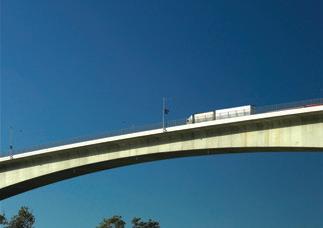
TCA also uses the anonymised data from RIM and other telematics monitoring applications to support broader policy, planning and education activities.

RIM creates data that allows us to visualise the way participating vehicles use the road network – at a whole-of-network level, but also right down to the level of individual roads and bridges.
IMPLEMENTATION IN THE SECTOR
Heavy vehicle operators will soon have an opportunity to opt in to the RIM app.
An early deployment of this application is in the construction sector in New South Wales. Roads and Maritime Services (RMS) has recently reissued business rules for telematics monitoring of the Safety, Productivity and Environment Construction Transport Scheme (SPECTS) – which allows transport operators using combinations that comply with the requirements of the scheme to operate at up to 57.5 tonnes.
SPECTS formerly required IAP monitoring, but RMS has reviewed the conditions of access. Transport operators will now be able to benefit from changes to business rules by allowing data from their existing telematic devices to be transmitted to TCA. This data will be aggregated and de-identified, and will provide a rich source of data on the construction sector for RMS.
Stage 1 of the RIM SPECTS application in NSW will run for a

These include:
♦ Helping the Heavy Vehicle National Regulator and road managers to review access for vehicles in return for improved visibility of vehicle movements
♦ Supporting the review of the Heavy Vehicle National Law
♦ Partnering with industry to publish reports about vehicle movements – such as Performance-Based Standards (PBS) movements
♦ Informing policy and planning discussions such as identifying key freight routes based on actual movement data and current policies relating to restricted access vehicles, such as dangerous goods or oversize, overmass vehicles.
In a nutshell, through RIM, road infrastructure managers can get de-identified telematics data about heavy vehicle use on the road network; make better investment decisions on road use through specialised reports; and have a single point of access for valuable telematics road use data.
INTELLIGENT TRANSPORT SYSTEMS (ITS) For more information on RIM, visit www.tca.gov.au/new-applications or call TCA directly on (03) 8601 4600. 41 www.infrastructuremagazine.com.au September 2019 // Issue 12
THE IMPACT OF 5G ON
by Nam Nguyen, Principal Consultant and Geof Haydon, Principal Consultant
WHAT IS 5G?
5G — the 5th Generation of Mobile Network Technology — has been hailed as the next big evolution in mobile phone technology. 5G promises to offer extreme speed, massive capacity for machine connections, and ultrareliability and low latency – characteristics that would fuel industry innovations, and in turn revolutionise the way we interact with the world. Officially, the 5G standard won’t be finalised until 2020, however, a number of mobile network operators around the world such as Verizon, AT&T and Vodafone, have launched their pre-standard 5G networks. In Australia, Telstra recently announced its 5G network in all Australian capital cities. So what does 5G offer? There are three key characteristics in 5G that covers most use cases.
Enhanced/extreme mobile broadband (eMBB)
5G standard promises significant speed improvement over 4G, with the goal to eventually reach a throughput of up to 20 Gbit/s. Early 5G test results in Australia have shown that download speeds of one Gbit/s, two Gbit/s and up to four Gbit/s were achieved in certain network conditions. Independent tests by CNET have shown the average 5G DL speed is around 500 Mbit/s around Sydney, which is still ten times faster than the current average 4G speed! eMBB will enable a more immersive experience. Applications such as VR/AR, healthcare and factory automation that need faster throughputs would benefit greatly with this 5G characteristic.
Source: ETSI
Massive machine type communication (mMTC)
There are a massive number of connections for Internet of Things (IoT) devices. 5G has the capacity to connect hundreds of thousands of IoT devices in a cell. The technology is designed to support the growing number of IoT connected devices. Various industry experts have put the number of IoT devices anywhere from 22 billion to 64 billion by 2025. The point is, there will be lots of devices in the future. Use cases in this category include smart cities, water and energy utilities, transportation, healthcare, mining, tourism and smart homes

Ultra-reliability and low-latency communications (URLLC) 5G technology is designed to support latency, as low as 1ms, compared to today’s LTE with latency of higher than 10ms. URLLC is needed for mission critical applications, and those use cases that require near real-time responses. Applications in this category include remote surgery, VR/ AR applications, drones, and factory automation, to name a few.
HOW 5G WILL IMPACT INFRASTRUCTURE
The Australian Communications and Media Authority (ACMA) has allocated the 3.6GHz as the lower 5G band. It has also indicated that the 26GHz band is most likely to be made available as the second 5G band.
As a rule of thumb, the radio signal doesn’t go as far at high frequency ranges. For instance, the radio coverage area of a 700MHz cell site will be larger than that of a 3.6GHz cell site. If an operator uses its LTE 700MHz radio tower infrastructure for
September 2019 // Issue 12 www.infrastructuremagazine.com.au 42
INTELLIGENT TRANSPORT SYSTEMS (ITS)
NETWORK INFRASTRUCTURE
5G 3.6GHz, there will be many coverage holes.
This means 5G technology will require new and additional network infrastructure in order to deliver the same network coverage of LTE, to provide the bandwidth and speeds, as well as the low latency. The required infrastructure translates to:
♦ More mobile towers with new antenna for macro coverage for 3.6GHz
♦ Lots of small cells for density coverage and ultra-high bandwidth, using millimetre wave, i.e. frequency in the 26GHz (or higher)
♦ In-building coverage infrastructure at 3.6GHz frequency, as it will be difficult for signal to penetrate office buildings
♦ Fibre backbone in order to support extreme bandwidths and throughout
♦ Core network architecture, including mobile edge computing capability
Operators in Australia have already deployed a lot of LTE Small Cells infrastructure to fill the coverage holes from the macro cell sites, and also to provide capacity for densely populated areas such as shopping streets, the Central Business Districts, etc.
In order to achieve the same breadth of network coverage as the current 4G network, 5G mobile network operators will need to deploy more cell sites (towers) for 3.6GHz band. For ultra-high throughput and capacity, small cell at 26GHz (millimetre wave), the second 5G band, would be needed. At this high frequency, the signal does not go far and there will need to be a small cell every 200 or 300m
SMALL CELL INFRASTRUCTURE
According to ZDNet, small cell infrastructure could remake landscapes. A carrier will need more of them — by one estimate, four hundred times more towers than are currently deployed, though conceivably better integrated with the landscape. The expectation is that a 5G small cell could become as common a feature in urban areas as lampposts and graffiti.
McKinsey has predicted that, based on studies on a number of global carriers, the 5G network infrastructure of new macro cells and small cells will represent a greater proportion of network spend between 2020 and 2025.
Operators could adopt network sharing to reduce the cost of 5G network infrastructure and lower the environmental impact of having multiple towers, however, this had not worked in
 Source:
Source:
Infyra
www.infrastructuremagazine.com.au September 2019 // Issue 12 43
INTELLIGENT TRANSPORT SYSTEMS (ITS)
the past due to different priorities, conflict of interest and the ability to differentiate between themselves. Network sharing is therefore not anticipated to be a successful business model anytime soon.
End-to-end network infrastructure will be needed to support high bandwidth and throughput. Optical fibre is necessary for backhaul transmission from cell towers and small cells back to the core network. In regional and remote areas where optical fibre is not available, millimetre wave microwave backhaul is the alternative.
5G will also require changes in core network architecture, with software defined network and virtualisation (SDN/NFV) in order to support 5G Network Slicing, one of the key enablers for operators to offer virtual networks to support different types of service level agreements. Many operators today are already implementing SDN/NFV.
Low latency and gigabits throughput requirements will also see operators build data centre infrastructure closer to the edge of the network to enable mobile edge computing capability closer to the users, in order to support high throughput, low latency and mission critical applications.
5G USE CASES — WHO WOULD BE INTERESTED IN 5G?
With expected wide bandwidths, Gbps download speeds, the low latency and ultra-reliability characteristics, it’s anticipated that industry sectors like public safety, rail, aeronautical, manufacturing and automation, utilities and automotive, and mining industries would be interested. 5G technology would enable a number of use cases:

Source: ETSI
Autonomous vehicles
Though near field communications will play a big part in autonomous vehicles, vehicle to everything, V2X communications will rely on a number of technologies, and 5G is one such candidate, as it can offer almost real-time communications with its low latency and ultra-reliability communications.
September 2019 // Issue 12 www.infrastructuremagazine.com.au 44 INTELLIGENT TRANSPORT SYSTEMS (ITS)
Virtual reality (VR) and augmented reality (AR)
Researches from Qualcomms and Huawei show that for lagfree visual between a server and the user headset mounted display, a bandwidth of around five GBps is needed, and if the user moves his/her head left or right, even more bandwidth is required. 5G small cell would be able to bring believable, real-time experiences to VR/AR.
Internet of Things (IoT)
One of the premises of 5G is the ability to connect a massive number of devices to central or mobile edge computing servers at high speeds and low latency.
Healthcare
High throughput and low latency connectivity in 5G will make remote operations possible, as well as enable remote/ regional healthcare centres to receive real-time support.
Private 5G networks
In theory, the Network Slicing feature in 5G would allow operators to create and offer virtual private networks for
different 5G use cases with SLAs to match each use case requirement. This should really eliminate the need for private enterprises to build their own private 5G network. However, it is likely that private 5G networks would still find their way in many industry sectors, like mining, manufacturing, emergency services and even in the agriculture sector. Especially if unlicensed bands are supported from a technical and regulatory point of view.
HOW FAR AWAY ARE WE FROM 5G SERVICES?
Despite early network deployment from operators in Australia, it will be a while before 5G becomes widely available, due to network infrastructure requirements. For regional Australia, it would take even longer as operators would target high population density areas first.
Any talk of 5G for agriculture will be unrealistic in the short term. 4G/LTE networks have been deployed in Australia since 2010/2011, and regional Australia still does not have good 4G services. So perhaps a decade from now, 5G for agriculture in regional Australia might be closer to reality.
Authors – Nam Nguyen and Geof Haydon
Nam and Geof are independent consultants and members of the IoT Alliance Australia (IoTAA) – a non-profit, independent and peak industry body representing IoT in Australia. The IoTAA has over 420 participating organisations and 800 individual participants are working to accelerate the adoption of IoT across the Australian economy and society.

CUTTER HEAD
133 Bluestone Circuit, Seventeen Mile Rocks, QLD, 4073
Tel: +61 7 3714 5700
Fax: +61 7 3715 8813
Email: info@hmi.com.au
Web: www.hmi.com.au PO Box 1467, Kenmore, QLD, 4069
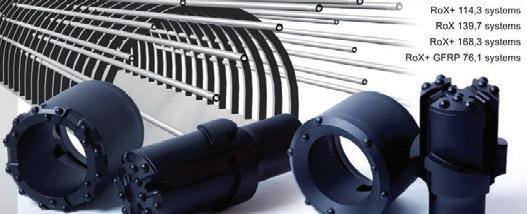


•
•
•
CANOPY TUBES
BOLTING & TUNNELLING
www.infrastructuremagazine.com.au September 2019 // Issue 12 45 INTELLIGENT TRANSPORT SYSTEMS (ITS)
A GUIDE TO NEW ROAD AUTHORITIES AND PROGRAMS
by Kim Ho, Assistant Editor, Infrastructure magazine

In the lead up to its re-election in April this year, the Coalition Government pledged funding for the development of new road authorities and initiatives to oversee improvements in the safety, interconnectedness, resilience and quality of our roads. Here, we take a deeper look into the suggested authorities, and what we know so far.
ROAD AND TRAFFIC
46 September 2019 // Issue 12 www.infrastructuremagazine.com.au
As part of its election pledge to invest $100 billion in infrastructure over the next decade, the LiberalNationals Government focused on the safety and productivity of Australia’s road network. These funding commitments include:
♦ $38.5 million to improve road safety nationwide (and $1.4 million per year ongoing)
♦ $16.5 million for initiatives as part of the National Freight and Supply Chain Strategy
♦ $2.2 billion to improve local road safety and provide upgrades across local road networks
The independent Review of National Road Safety Governance Arrangements, released in August 2019, found that while there was commendable commitment to reducing road trauma, there is a clear need for greater leadership, strengthened management, heightened accountability and more effective coordination to effect long-lasting change.
Part of the 2019-20 Federal Budget’s funding involves the establishment of brand new road authorities, advisory bodies and programs. Cumulatively, these measures aim to help Australia achieve a higher level of coordination and organisation to improve the safety of our road network – as well as its productivity.
COORDINATING ROAD SAFETY NATIONWIDE
In March 2019, the Federal Government announced it would establish a national Office of Road Safety to facilitate greater coordination and leadership within government for road safety.
The 2019-20 Budget, announced in April, allocated $5.9 million for the task. The Office commenced on 1 July, operating within the Surface Transport Policy Division of the Department of Infrastructure, Transport, Cities and Regional Development.
The Office will initially focus on establishing the functions needed to perform its lead agency role while delivering priority government commitments to new and continuing road safety programs.
The key objective of the Office of Road Safety will be to provide national leadership in eliminating road trauma in Australia. The Office will operate as the primary policy advisor to the federal ministers for road safety on matters related to delivering safe roads, vehicles, speeds and people, and will draw together interdisciplinary expertise and experience to learn, share and channel effort towards proven approaches to reducing national road trauma.
In doing this, it will work collaboratively with counterpart agencies across the states and territories, as well as expert agencies such as Austroads.
The authority was established on the recommendation of the Inquiry into National Road Safety Strategy 2011-2020 (NRSS), submitted in September 2018.
Funding a national leadership body like this was one of the key recommendations of Scaling up to Save Lives: Protecting current and future generations, a report summarising 12 main findings from the inquiry.
Citing road trauma as a hidden epidemic with a considerable impact on the health system, the report called for a national road safety entity reporting to a Cabinet minister with responsibility for road safety. It also called for the Federal Government to commit to a minimum $3 billion-a-year road safety fund.
Informing how the Office operates will be a Joint Select Committee on Road Safety, created in August 2019. Comprising nine members in total from across Parliament, the committee’s aim is to address the effectiveness of existing
programs and investments. It will consider recommendations for the role of the Office of Road Safety.
The committee will also examine the effectiveness of existing road safety support services and programs, including opportunities to integrate Safe System principles into health, education, industry and transport policy.
Safe Systems is a globally-recognised, holistic approach to road safety founded on the principle that our need to travel should not come at risk to our life and health. The committee’s work will attempt to rectify the findings of the Review of National Road Safety Governance Arrangements, which argued that Safe Systems must be more deeply ingrained within government.
While the committee’s goal is to help achieve zero deaths and serious injuries across Australia, it will have a particular focus on improving safety in remote and regional areas.
ROAD SAFETY INNOVATION FUND
The government also allocated $12 million towards creating a new Road Safety Innovation Fund to support road safety research and the development of new road safety technologies and products.
Prime Minister, Scott Morrison, said this research would focus on “priority areas such as regional road safety, driver distraction from mobile devices, protecting vulnerable road users and reducing drug driving”.
NATIONAL FREIGHT DATA HUB
$16.5 million was also allocated in the 2019-20 Budget towards a suite of initiatives as part of the National Freight and Supply Chain Strategy.
$8.5 million of this was allocated to finalise the design of a National Freight Data Hub, which aims to help businesses and governments plan and make better operational and investment decisions.
♦
The commitment to a Freight Data Hub includes:
$5.2 million to settle the hub’s design, including arrangements for data collection, protection, dissemination and hosting
♦
$3.3 million for the establishment of a freight data exchange pilot to allow industry to access freight data in real time and a survey of road usage for freight purposes
Over the next two years, the Department of Infrastructure, Transport, Cities and Regional Development will be working with stakeholders on the freight data hub design. As part of the design process, the department will also be integrating pilot projects and other data initiatives into a prototype hub to test and inform the design and business case for implementation.
A discussion paper is scheduled for release in September 2019 to gather initial views from industry.
A BIG YEAR FOR HEAVY VEHICLE REFORM
Much of the Federal Government’s investment focus on roads has been on heavy vehicles, with a view to improve national road safety and productivity for inland freight routes.
The Budget pledged an additional $6 million for the Heavy Vehicle Safety Initiative to fund projects that identify opportunities to improve heavy vehicle safety.
Alongside the Freight Data Hub, the other half of the $16.5 million allocated for National Freight and Supply Chain Strategy initiatives will go towards heavy vehicle projects.
$8 million will go to the National Heavy Vehicle Regulator to streamline the approval process for road access by heavy
www.infrastructuremagazine.com.au September 2019 // Issue 12 47 ROAD AND TRAFFIC

vehicles. This includes:
♦ $6 million to fund engineering assessments for localgovernment-owned road network infrastructure
♦ $2 million to go towards building an asset information collection, storage and sharing system
These funding commitments coincide with a series of policy reforms and industry transformation.
In January 2019, the National Transport Commission (NTC) began a comprehensive review into the Heavy Vehicle National Law (HVNL). The review will involve extensive consultations with stakeholders from both rural and urban areas, with the aim of improving road safety and productivity. These include trucking industry representatives and related industries; policy and law enforcement agencies; the National Heavy Vehicle Regulator; all three tiers of government; and members of the Australian community.
HEAVY VEHICLE SAFETY AND PRODUCTIVITY PROGRAM
As part of the Local and State Government Road Safety Package, the Federal Government also allocated an additional $275 million for the Heavy Vehicle Safety and Productivity Program (HVSPP)
The HVSPP is an initiative to fund infrastructure projects that improve the productivity and safety outcomes of heavy vehicle operations across Australia.
State, territory and local governments are eligible to apply for funding for projects that would upgrade road infrastructure to improve heavy vehicle safety and freight efficiency, help save lives and reduce travel times for freight on Australia’s roads.
The Federal Government is contributing up to 50 per cent of the total project cost to successful projects, up to a maximum of $5 million.
The 2019-20 Budget committed an additional $25 million per year to the HVSPP. This marks a total of $508 million to the program between 2013 and 2023, with an ongoing commitment of $65 million each year following.
Successful projects in Round Six of the program were announced in August 2018. The date for Round Seven has not yet been announced.
FUNDING PRE-EXISTING ROAD SAFETY PROGRAMS
In addition to the Office of Road Safety and the Innovation Fund, the Federal Government will provide additional funding of $2.2 billion from 2019-20 to improve local road safety and provide upgrades across local road networks.
This funding includes an additional $1.1 billion for the Roads to Recovery Program, which brings the total investment in the program to $9.1 billion since 2013-14.
There will also be an additional $550 million for the Black Spot Program, a total of $1.8 billion since 2013-14.
An additional $275 million will be allocated for the Bridges Renewal Program, marking $1.2 billion for the program since 2013-14.
$4 million has gone to supporting road safety awareness, education and collaborative initiatives with nationally focused road organisations that promote road safety. The Australian Automobile Association has also pledged to continue making a co-contribution of $1 million a year (cash and in-kind) with an emphasis on outreach in regional areas.
WHAT ELSE COULD BE ON THE HORIZON FOR AUSTRALIA’S ROADS?
The Australian Logistics Council (ALC) listed 39 priority actions to safeguard and improve the ongoing efficiency of Australia’s supply chains. While the Federal Government has so far committed to several of these priorities, including establishing the National Freight and Supply Chain Strategy and Freight Data Hub, there are more industry bodies that the ALC believes are missing from the ecology of Australia’s road sector.
According to the ALC, establishing a High Productivity Vehicle Infrastructure and Education Fund would allow local governments and road managers to apply for funding to upgrade infrastructure, or commence community education campaigns to facilitate the movement of high productivity vehicles on key freight routes.
Establishing a Low Emission Vehicles Contestable Fund and providing tax concessions would drive greater uptake of electric delivery vehicles (EVs). The ALC believes such a fund should be valued at $20 million per year, even recommending the Federal Government co-fund up to 50 per cent of the purchase price of an EV.
The ALC also recommends the creation of a fund to help local governments develop coordinated urban freight plans, since it is often municipal councils that manage roads and regulate access to warehouses, particularly for heavy vehicles.
It will remain to be seen if the government will look at adopting the ALC’s recommendations, but the establishment of new road authorities, funds and programs, along with a concerted effort nationwide to consolidate planning for freight and logistics, bodes well for the future of the road sector.
48 September 2019 // Issue 12 www.infrastructuremagazine.com.au ROAD AND TRAFFIC

SHEAR FORCE:
MINIMISING INJURY FROM COLLISIONS WITH ROAD SIGNS
A large proportion of car accidents in Australia involve collisions with poles and traffic sign structures. How can we design our roadside infrastructure to improve commuters’ safety?


Car accidents present a massive problem in Australia. There have already been over 635 deaths in 2019 so far, 13.8 per cent higher than the same period last year. What’s more, almost a quarter of all car accidents this year were caused by collision with a stationary object. In mitigating this risk, it is vital that we seek solutions to make our road infrastructure safer.
Road signs are traditionally supported by steel structures. In a collision, steel absorbs the full energy of the impact, retains its cohesion as an object and exerts force back onto the vehicle, endangering the driver and passengers.
A new, innovative design out of Europe aims to mitigate this risk. The Lattix range of supports is leading the way in terms of frangible posts – supports that break apart safely in the event of a collision.
Lattix will progressively crumple upon impact before shearing at specially designed points on the footplate. This process of plastic deformation cushions the occupants from the massive deceleration forces that so often result in serious injury.
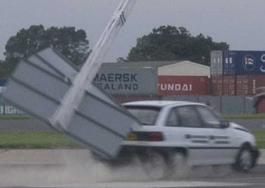

WORLD-CLASS DESIGN FOR OPTIMAL PERFORMANCE
Manufactured in Norway and Sweden from extruded aluminium, the complex lattice design is created by slotting and stretching the profile before mechanically forming the distinctive triangular or quadrangular posts. The mechanical strength used in this slotting and stretching procedure is directly responsible for Lattix’s energy absorption properties. Frangible supports can not only be used in road construction, but in any industry where safety and frangibility matters, including the aviation sector.

For example, Lattix will make buildings near runways safer in the event of an aircraft collision. Lattix can also be aesthetically colour-coded as an affordable alternative to traditional posts in commercial sign installation.
Artcraft Pty Ltd is the sole distributor in Australia and New Zealand for the Lattix range of frangible supports.
Artcraft Services, a division of Artcraft Pty Ltd, in conjunction with Lattix’s engineering team in Norway, can provide and assist contractors with design enquiries, supply and installation of Lattix products, from basic design to footings and completed work.
September 2019 // Issue 12 www.infrastructuremagazine.com.au 50
ROAD AND TRAFFIC // PARTNER SOLUTIONS
everything
need: safety, short lead time
easy construction process. For more
technical specification,
us on 1300 765 653.
Lattix offers
you
and
information and
please contact
VS.

Australian Tunnelling Conference
Promoting best practice in tunnel design, construction and maintenance
14 – 15 October 2019 | Aerial UTS Function Centre, Sydney
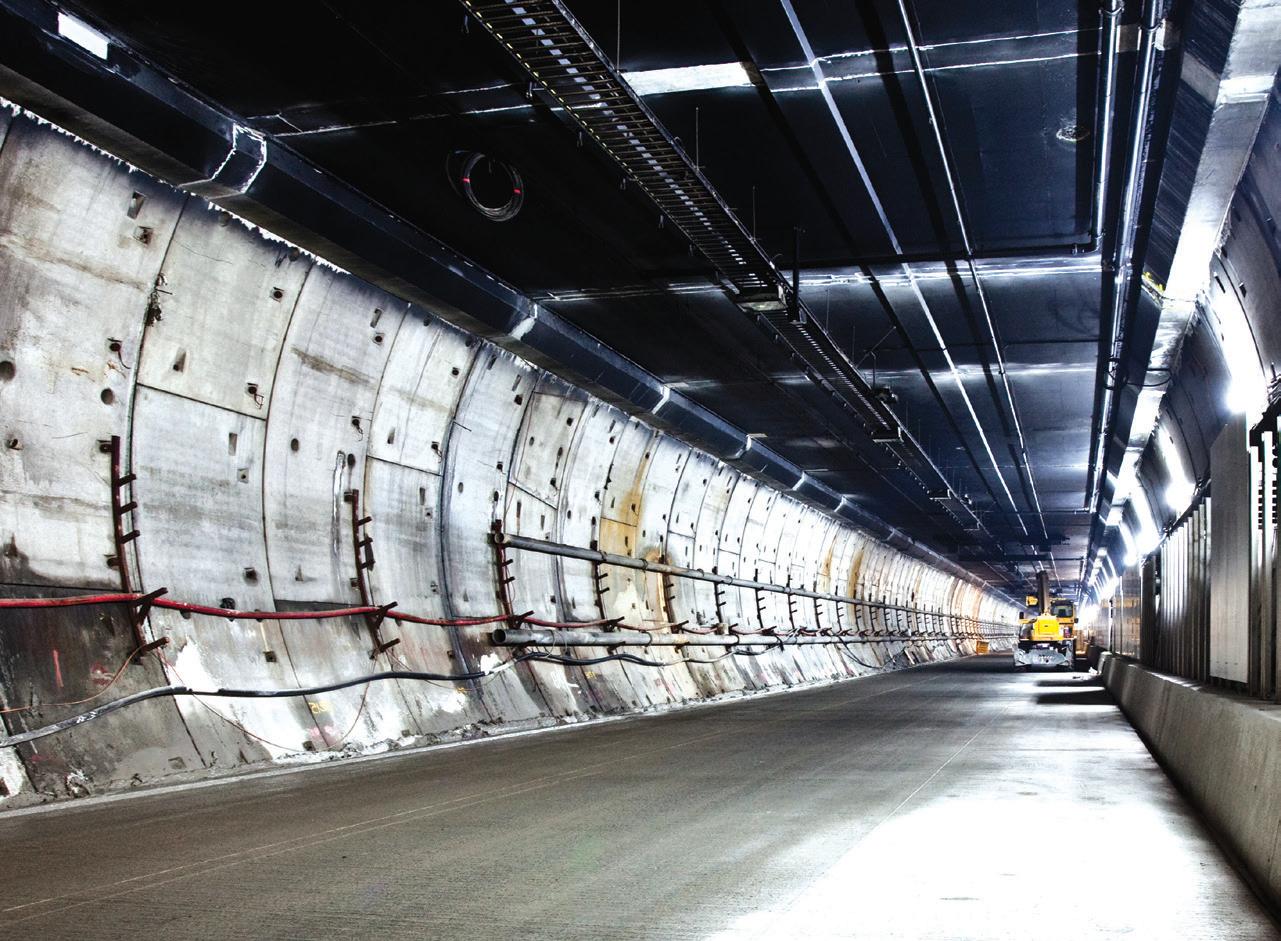
FEATURING INTERNATIONAL CASE STUDIES FROM:





SINGAPORE
MALAYSIA
ITALY
HONG KONG
NEW ZEALAND




THAILAND
CHINA
UK
INDONESIA
PROJECT UPDATES & INDUSTRY CASE STUDIES:
– WESTERN HARBOUR TUNNEL AND BEACHES LINK
– SNOWY 2.0
– WESTCONNEX TUNNELS
– CITY RAIL LINK NZ
– IMMERSED TUNNEL OF HONG KONG-ZHUHAI-MACAO BRIDGE
– MELBOURNE METRO TUNNEL
– BRENNER TUNNEL
– CROSS RIVER RAIL
– FORRESTFIELD-AIRPORT LINK
– GOLD COAST SEAWAY
GOLD SPONSOR: LANYARD SPONSOR:


REGISTER NOW www.informa.com.au/tunnelling19
PRESENTING THE 16TH SUPPORTED BY:
The West Gate Tunnel Project (WGTP) is an enormous city-shaping project that will transform the way Victorians travel and make Melbourne’s inner west an even better place to live by taking trucks off residential streets. Here’s the latest update on the construction and tunnel boring works, and a look at what’s currently happening under our feet for a project of this scale.
THE LATEST ON VICTORIA’S WEST GATE TUNNEL

TUNNELS 52 September 2019 // Issue 12 www.infrastructuremagazine.com.au
TMB Bella being transported from the Port of Melbourne to the northern portal site.
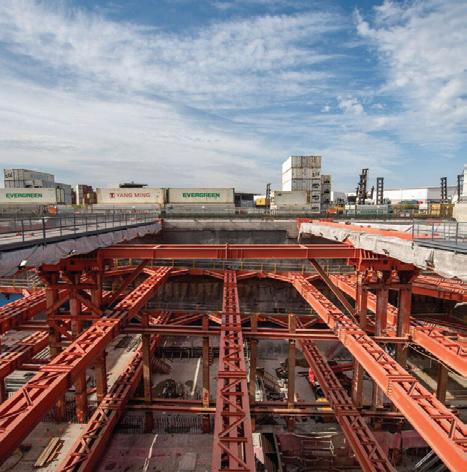
Victoria’s population is growing rapidly and the state needs more viable transport options. The West Gate Tunnel Project will deliver a vital alternative to the West Gate Bridge, create better connections to major Melbourne roads and freeways, and reduce travel time from the west to the city by up to 20 minutes.
Construction is well underway with state-of-the-art technology being used to build twin tunnels, a new bridge over the Maribyrnong River and additional lanes on the West Gate Freeway.
TUNNEL BORING MACHINES JOURNEY TO NORTHERN PORTAL SITE
Two massive tunnel boring machines (TBMs), Bella and Vida, will dig the 4km and 2.8km tunnels. The two TBMs were built in Germany before being assembled and tested in China. Due to their enormous size, they were disassembled into smaller parts before being shipped to Melbourne.
TBM Bella arrived at the Port of Melbourne earlier this year before being trucked to the northern portal site in Yarraville, Melbourne. It took nearly 100 truckloads to deliver all of Bella’s components and supporting equipment to site.
The heaviest TBM piece was the main drive (TBM motor), weighing 307 tonnes and measuring 10m long and 8.4m wide. Due to the weight and size, a major bridge was closed to other traffic while the delivery travelled over the Maribyrnong River.
It took three weeks to deliver all of Bella’s parts to the northern portal site. The same operation was then repeated for the second TBM, Vida.
HOW THE PROJECT’S TBMS WORK
The West Gate Tunnel Project’s TBMs are the largest in the southern hemisphere, standing at 15.6m in diameter, 90m in length and weighing around 4,000 tonnes each.
The TBMs will bore up to around 40m under the ground at the deepest point (the bottom of the tunnel), while also installing a concrete lining, forming the walls, roof and base of the tunnel. TBMs Bella and Vida will excavate rock and soil with a rotating cutterhead before moving forward to make space for the concrete lining. It then stops moving and installs the lining using a specialised rotating machine.
TBMs of this size need ten megawatts of power per machine. A new substation has been built on site at the northern portal to ensure enough power is supplied to keep the machines moving 24 hours per day, seven days a week.
Highly specialised crews operate the TBMs. Behind the TBM, crews work to build the road surface and install electrics, ventilation and safety systems.
THE CONVEYOR SYSTEM
Soil and rock excavated by the TBMs will travel along the conveyor belt system which loops from the TBMs across a road and into the big shed before being placed into two huge spoil bins and then transferred to treatment facilities. At its longest, the conveyor belt system will be a 15km loop.
The conveyor belt system is controlled from the TBM control room located near the head drive of the tunnel conveyors. It will be monitored via CCTV cameras and ensure that at each of the transfer belts, there are no issues. Additional monitoring will also ensure that the system is not being used above intended capacity.
The conveyor can move at 12.6km per hour and is designed to carry a maximum of 2,500 tonnes per hour.
Two people will operate the conveyor from inside the TBM cabin for the tunnel section of the conveyor, with an additional two to three people overseeing the maintenance for the rest of the conveyor alignment.
More than 1.5 million cubic metres of dirt and soil will be generated from tunnelling. The conveyor belt will launch when TBM Bella starts tunnelling.
CONSTRUCTION UNDERWAY
Construction on the West Gate Tunnel is well underway with several major project milestones completed earlier this year.
New electricity monopoles were installed in sections along the West Gate Freeway, replacing two of the lattice towers. These new monopoles take up less space, allowing an additional four new through lanes to be built along the West Gate Freeway.
To get ready for Bella and Vida, a big shed has been built to store excavated material and the TBM launch site has been completed. In the coming months, Bella and Vida will start
www.infrastructuremagazine.com.au September 2019 // Issue 12 53
TUNNELS
The project’s launch box

tunnelling and move from the northern portal site in Footscray and start tunnelling south west towards the West Gate Freeway.
Further east of the project, more activity has commenced around Footscray Road as piling rigs build the elevated road that will connect the tunnel to CityLink and the city. Piling has started in the Maribyrnong River area to get ready to start building the new bridge over the Maribyrnong River.
BUILDING MORE THAN A TUNNEL
In addition to building the twin tunnels and bridge over the Maribyrnong River, the WGTP will create nearly nine hectares of new parks and wetlands, spanning across Maribyrnong and Hobsons Bay suburbs.
These new open spaces will improve local parks with more than 17,000 trees and tens of thousands of native and indigenous shrubs and grasses planted across the project alignment.
Sections of the Maribyrnong River, Kororoit, Stony and Moonee Ponds Creeks will also be upgraded with the planting of native shrubs and grasses. The WGTP is working with local groups to preserve and enhance these waterway environments. Additionally, the new wetlands in Yarraville will be used to treat stormwater and rehabilitate creek banks.
Over 14km of cycling and pedestrian paths will be upgraded or built, creating better connections to popular trails across Melbourne’s inner west. A new 2.5km veloway along Footscray Road will create an express journey for cyclists to and from the city, completely separated from traffic with two emergency exits.
OVERCOMING CHALLENGES
A project of this enormity is a significant challenge. There are multiple stakeholders involved and many considerations to keep in mind.
The project aims to minimise the amount of traffic disruptions by organising traffic works to happen at night and provide clearly signposted detours where required. Additionally, the project works with other road and public transport authorities, Bicycle Network Victoria and other key stakeholders to implement traffic changes.
The West Gate Tunnel is due to be completed in 2022.
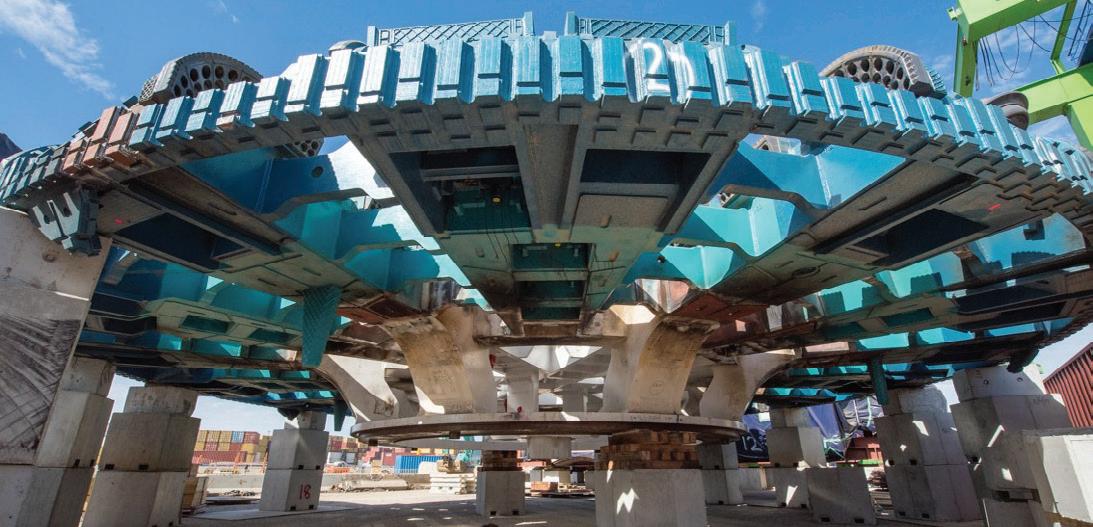
September 2019 // Issue 12 www.infrastructuremagazine.com.au 54
TUNNELS
TBMs Bella and Vida will excavate rock and soil with a rotating cutterhead.
The conveyor belt system transporting soil and rock excavated by the TBMs.

QUIET METRO TUNNELS WITH NOISE ABSORPTION MATERIALS

On 26 May, the first stage of Australia‘s largest public transport project was opened: the Sydney Metro Northwest. The immense project demanded unique specifications for noise minimisation, particularly with regard to the reverberation typically created in such tunnels.
Lining tunnels with the appropriately attuned material has been repeatedly proven, including in this instance, to make a significant difference to increasing sound attenuation within the tunnel. When it came time to engineer the acoustic properties of the tunnel, it came under the jurisdiction and expertise of Renzo Tonin & Associates.
Turning to a very high NRC performance, proven at 0.95 – which is an excellent result on its own, let alone part of a well-designed system – Reapor was a known solution, so naturally it would be included from the beginning.
The more challenging part? Creating a more robust, trafficable ‘between the track’ sound absorber.
Viterolite 900 was designed with specific porosity and airflow resistivity to provide maximum noise absorption within these applications. Furthermore, Pyrotek offers a bespoke solution where tile design requires consideration for ease of handling, accommodation of services or other design requirements, while maintaining a high sound absorption over a broad frequency range.
NETWORK OF NEW TUNNELS AND INFRASTRUCTURE PROJECTS
OCCURRING ACROSS THE GLOBE
In aiming for compliance with acoustic and design specifications, the materials actually exceeded expectations, reducing tunnel noise levels to under 78dB(A). Key requirements here essentially meant addressing noise discomfort in the carriage created by wheel rail impact, evacuation safety for passengers, and total non-combustibility or smoke risk if the material were to become too hot.
With safety also comes more comfortable journeys that have better speed and comfort. For those who have ridden the new Sydney Metro – you’ll notice it’s a very different experience. It feels lighter somehow, and its quietness when there are fewer passengers around feels very new. While the current schedule isn’t running at peak capacity, tests show that it’s built for the future.
Addressing tunnel noise reverberation to this degree means improved ambience and a truly worldclass travel experience.
Upon descending down the long
More than 42,000 panels were used to line the 15km of tunnels so far. Work continues on the new lines as they make their way all the way to Central and onward towards the CBD. Working in Australia and internationally to develop innovative noise mitigation solutions, Pyrotek is one of the world’s leading manufacturers of unique, high performance acoustic and thermal materials.
escalators, travellers on the new Sydney Metro experience great heights and vast spatial proportions, so its relevant to note that noise from the rail mechanisms can travel up through the 13 new stations. But does it? If it weren’t for these sound absorbers, it could be deafening for users and nearby residents.
With today’s result you can easily hold a phone conversation. It’s impressive when tested officially and also in the day-to-day commute, creating not only comfort, but value.

September 2019 // Issue 12 www.infrastructuremagazine.com.au 56
TUNNELS // PARTNER SOLUTIONS
Working in Australia and internationally to develop innovative noise mitigation solutions, Pyrotek has been specified by the world’s leading acoustic consultants. For more information, visit pyroteknc.com.
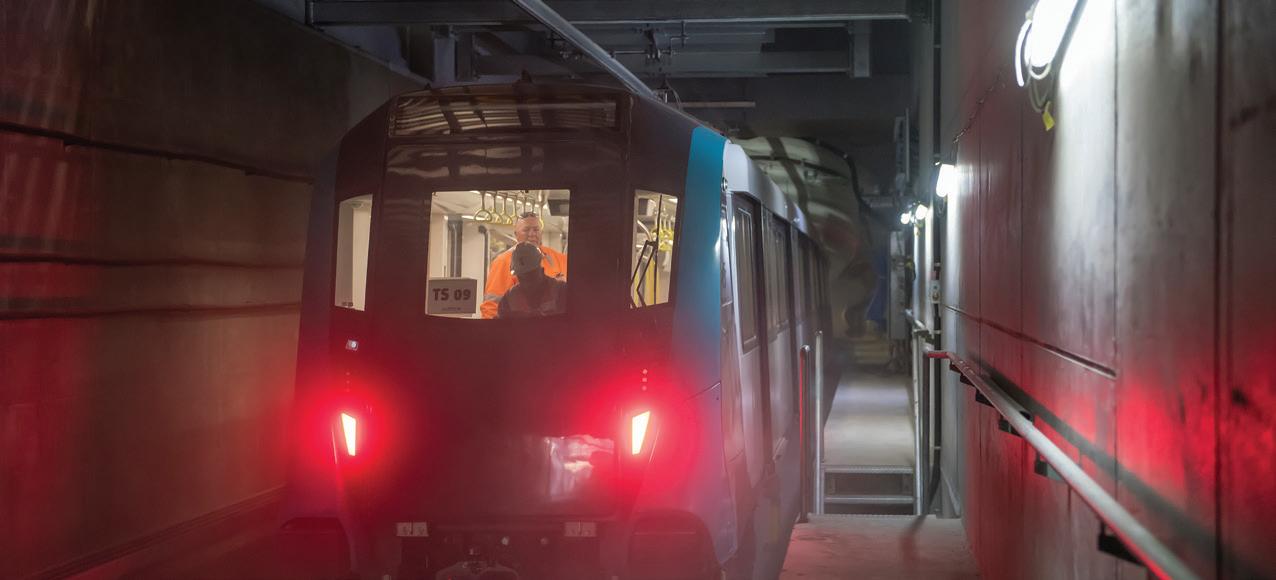
QUIETER TUNNELS, PLATFORMS AND CARRIAGES

VITEROLITE 900
ENGINEERED FOR SAFETY zero smoke emission, volatiles, toxic or noxious gases in tunnel and ventilation shafts.
MANUFACTURED Uses cement binding agents for use in high wear, high impact and trafficable areas.
MAXIMUM SOUND ABSORPTION
Tuned across a broad frequency range
QUICK INSTALLATION custom cast feet allow for fork access - this means easy placement of slabs.
DEVELOPED WITH INDEPENDENT TESTING AND





























sqm
LOCAL
LOGISTICS INCLUDED A
INNOVATION
4 ACOUSTIC EXPERTS NOISE LEVELS DEMANDED BY LAW 78 dB pyroteknc.com
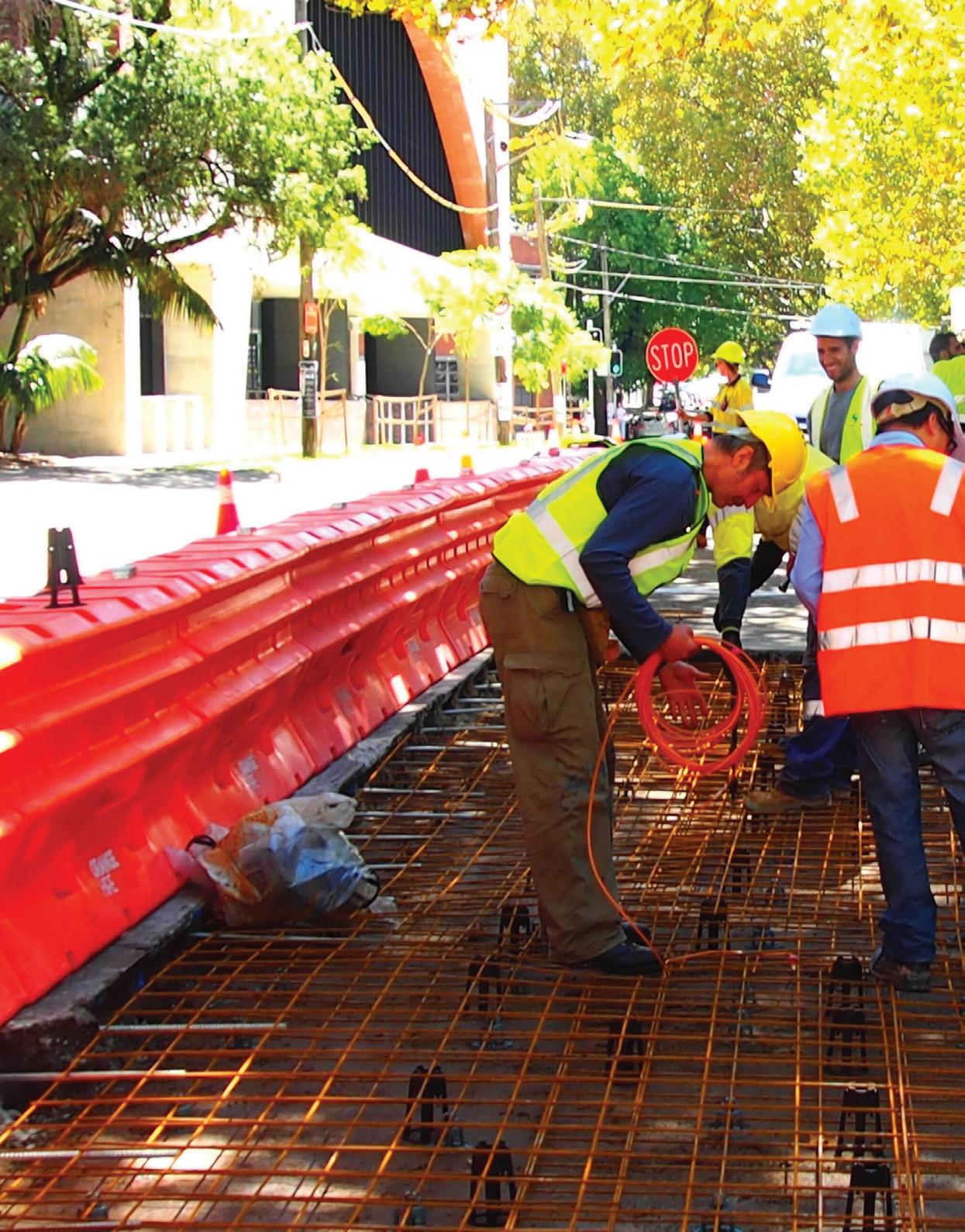
For most people, the suggestion of driving over industrial by-product would conjure up images of an apocalyptic environmental disaster. But, the City of Sydney is trialling a new ‘green’ approach that could be the first step in environmentally-friendly paving and footpaths.
The trail is being conducted on a 30m section of road on Wyndham Street – a busy inner-city Sydney street that leads to Sydney Airport in the suburb Alexandria. The site was chosen because the road was already in need of repair and as a major road leading to Sydney Airport, it has a high traffic volume, providing the perfect environment for an intensive trial.
LAID BARE
As part of the trial and to test the green concrete durability, the City has laid 15m of traditional concrete and 15m of geopolymer concrete, a sustainable blend of concrete and recycled materials.
Researchers from the University of New South Wales and the CRC for Low Carbon Living (CRCLCL) have placed nine sensors under the concrete to monitor and compare how the geopolymer concrete performs against the traditional variety.
UNSW Sydney researchers will monitor the road performance for up to five years. This data will help create new industry guidelines for using sustainable concrete blends in pavements and roads, and will form the basis of a handbook titled Guide and Standard Specification for Construction with Geopolymer Concrete. This handbook will provide engineers and end users with practical information and specifications for using geopolymer in construction projects.
It is also hoped that the trial will reduce perceived risks about using geopolymers and demonstrate that alternatives to concrete can be found, paving the way for this approach to be used elsewhere.
GREEN ROAD PART OF A BIGGER PICTURE
Sydney Lord Mayor, Clover Moore, said the City was committed to finding new ways to lower carbon emissions and have outlined measures as part of its sustainability strategy.
“I’m proud that the City of Sydney was Australia’s first carbon-neutral local government and that we’re continuing to take significant steps to reduce our carbon footprint,” Mayor Moore said.
“Projects like this geopolymer trial can result in new products that make a real difference in slashing carbon emissions.
“Local governments are responsible for maintaining local roads, so if we can purchase more environmentally sustainable materials, we can fight climate change and provide quality infrastructure for our community.”
Seventy per cent of concrete that is produced goes into pavements and footpaths, and concrete contributes seven per cent of all greenhouse gas emissions. In 2018, 4.1 billion tonnes of cement was produced around the world, which creates ten billion
58 September 2019 // Issue 12 www.infrastructuremagazine.com.au
CONCRETE
WORLD-FIRST
GREEN CONCRETE TRIAL
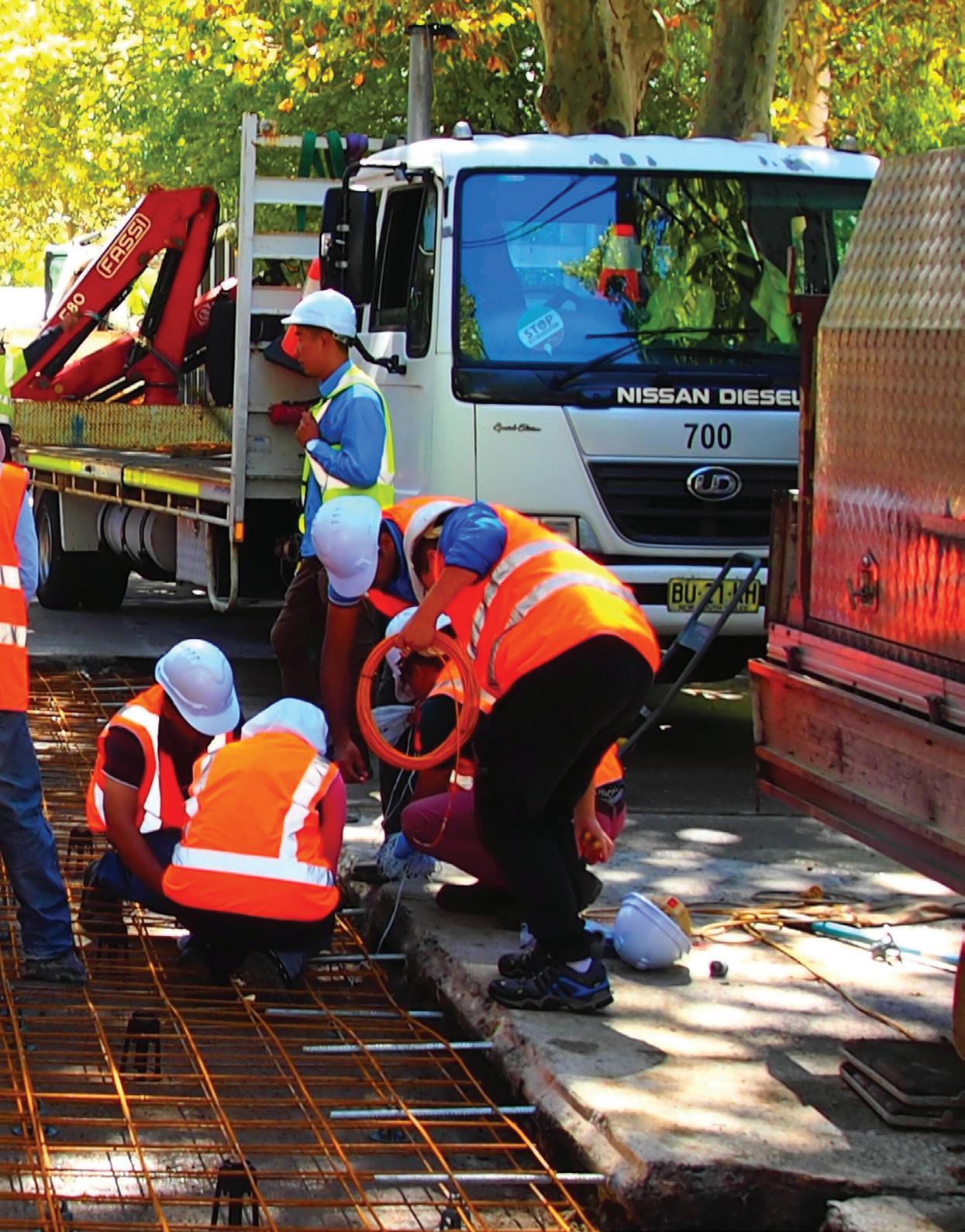
The City of Sydney is trialling the world’s first ‘green’ road on a major high-volume traffic road leading to Sydney Airport, with the concrete made from industrial byproducts of coal-fired power stations and co-products from the steel industry. The project is an important step in creating road surfaces that are more environmentally friendly, while remaining commercial viable.
59 www.infrastructuremagazine.com.au September 2019 // Issue 12
CONCRETE
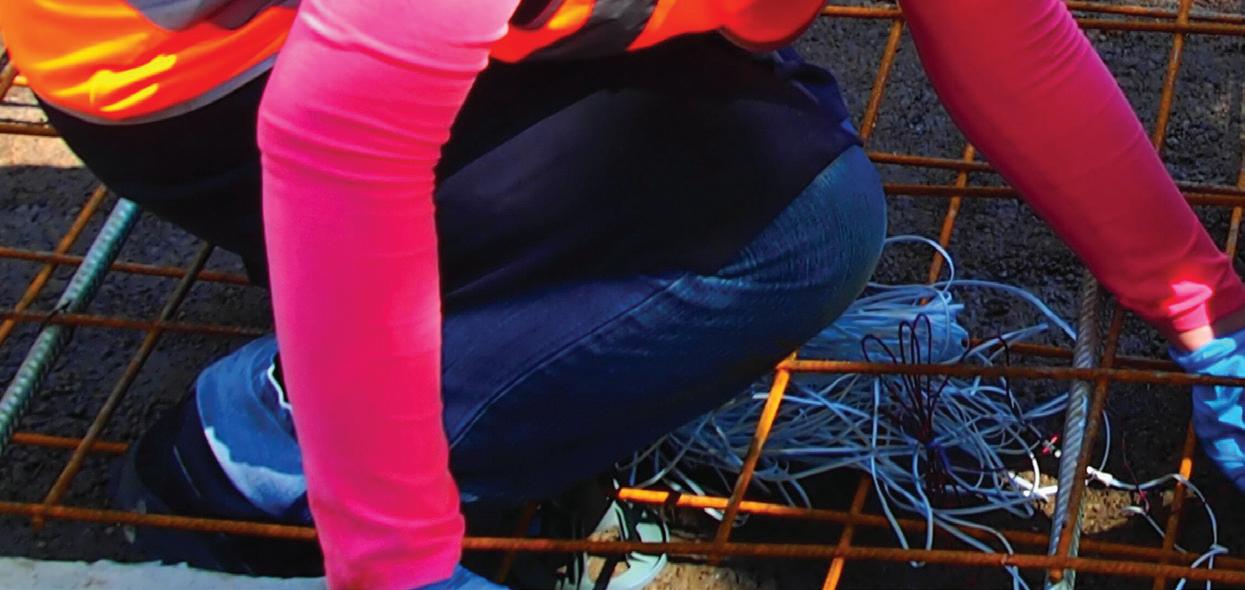
tonnes of concrete. This contributed about 3.5 billion tonnes of CO2.
However, geopolymer concrete has a 50 per cent reduction in carbon emissions compared with conventional cement.
“We’re continually working with concrete suppliers to reduce the amount of pollution and greenhouse
CONCRETE CONSTRUCT
Made from fly ash and blast furnace slag, geopolymer generates just 300kg of CO2 per tonne of cement, compared to the 900kg from traditional cement production – saving the equivalent of the electricity used by an average household every two weeks.
Research has been undertaken since
to put the 400 million cubic tonnes of globally documented by-product from the coal and steel industries to good use. While a small amount is currently used in construction, much of it is currently stored on site.
PAVING THE WAY FORWARD
Professor Stephen Foster, Head

CONCRETE

are already doing a lot to change, but this trial really gives it another push,” Professor Foster said.
“While we’ll monitor the road performance for up to five years, a lot of the data collected in the first three to 12 months of this world-first trial will be used to confirm our models and strengthen our predictions.
“Alternative, low CO2 concrete materials offer potential benefits in reducing greenhouse gas emissions associated with conventional concrete.
“This trial is important because we need demonstration projects to

accurately assess the performance of geopolymer over time so that there can be broader uptake.”
Industry Partner, Craig Heidrich, the Executive Director of the Australian (Iron and Steel) Association and Ash Development Association, said the benefits of the trial will be far-reaching.
“Our collaboration with organisations such as the City of Sydney and the publication of the research findings will further demystify and promote the use of geopolymer concrete in construction.
“Geopolymer concrete has great engineering properties. It is a durable,
high performance product that has a low carbon footprint when used in construction,” Mr Heidrich said.
“It’s a fundamental tenet in business that you need to be constantly innovating and investing into new technologies. This trial will provide real examples of geopolymer concrete use that we can all use.”
According to Dr Tommy Wiedmann, Associate Professor of Sustainability Research at UNSW, if all concrete was produced in one year was geopolymer instead of traditional concrete, this would save 12,000 kilotons CO2 per year.
CONCRETE
LACK OF EXTRACTIVE CONSTRUCTION MATERIALS CHALLENGES PLANNED PROJECTS
by John Kilgour, CEO Civil Contractors Federation, Victoria
With Victoria’s fast-growing population, the race is on to deliver affordable infrastructure and skilled labour within the civil construction sector. Key to this is the maintenance of a robust and efficient supply chain of extractive construction materials. Demand for construction materials such as cement, concrete, stone and sand is ever-increasing, raising significant challenges to those responsible for ensuring responsive supply.


John Kilgour is the Chief Executive Officer for the Civil Contractors Federation Victoria. Known for his strong advocacy work and networks at local and state government levels, John joined CCF in February 2016 from the Committee for Ballarat where he was CEO. Prior to joining the Committee for Ballarat, John had a long and distinguished career in the downstream oil industry with BP. During his 34 years with the BP Group of companies, John delivered major investment projects in the oil and gas, retail, petrol and convenience sectors throughout Australia, New Zealand and South East Asia. In February 2017, John was appointed President of the Victorian Civil Construction Industry Alliance, which CCF is a member.
CONCRETE
62 September 2019 // Issue 12 www.infrastructuremagazine.com.au
The massive demand for raw materials on major infrastructure projects such as the Melbourne Metro Tunnel, West Gate Tunnel and Level Crossing Removal Program are contributing to the draining of local supplies. Industry groups have warned we will soon need to start importing sand and other raw building material from interstate or overseas, dramatically increasing the cost of construction, if action isn’t taken now to address dwindling local supplies.
The further projects are from the quarry gate, the greater the cost of transport and logistics. Raw materials make up a third of construction costs and any rise in their price can dramatically impact a project’s bottom line.
For every 1km of highway built, 14,000 tonnes of gravel and raw materials are used.
The $9 billion Metro Tunnel alone needs more than 1.4 million tonnes of concrete to build its twin 9km tunnels, while a similar or greater amount would be needed for the proposed $16 billion North East Link.
In 2016, the Victorian Government launched a report assessing the state’s quarry resources, stating that, “Appropriately managing access to quarry resources and reducing future costs of transporting materials from quarries to market could have significant flow on effects to help deliver affordable infrastructure, including roads, bridges, rail lines, houses and hospitals in to the future.”
The report also found that 15 local government areas would be critical to efficiently supplying quarry materials to key growth area markets, which will also incur additional $2 billion in transport costs for every 25km that quarry materials must be transported over the 2015-2050 period.

It
is essential to our members and the wider industry that we continue to manage and protect our key quarry resource areas to ensure a steady flow of unhindered residential and infrastructure works across Victoria
THE URGENT NEED FOR REFORM
Major government studies have found under the current rate of use, by 2050 Victoria may need to have a third of its raw materials supplied from quarries not yet built or planned.
The industry’s key concern is the slow pace of reform to remove red tape and approve new quarries.
In order to deliver the 60 million-plus tonnes per annum of high-quality quarry products and the additional cement and concrete needed, there needs to be faster approvals for quarry and sand reserves.
CCF continues to engage with the Victorian Government, working as an advocate for civil contractors throughout the state to push for the reduction of regulatory constraints and redtape – the very factors that act as blocks to an effective and sustainable supply chain.
As a major procurer of infrastructure, the Victorian Government is responsible for recognising and implementing appropriate reforms to the policies and processes surrounding extractive materials.
Without these critical reforms the disparity between demand and supply will continue to grow.
THE WAY FORWARD
After his budget was released, Victorian Treasurer, Tim Pallas, admitted a shortage of raw materials were ‘weighing’ on the government’s $107 billion infrastructure program.
It is imperative that the required extractive materials are made readily available in order to successfully take projects from planning to reality.
A joint ministerial statement on extractive resources was recently released by the Victorian Government’s Resources and Planning Departments, outlining their commitment to take practical measures to address the issue:
“To assist quarries to keep operating and new sites to develop alongside growing suburbs and communities we commit to:
1. Streamline approval processes to expand production
2. Protect the continuity of supply from existing quarries
3. Apply the ‘agent of change’ principle to quarries
4. Provide better guidance to industry and local government
5. Identify and protect extractive resources of strategic importance
6. Reduce the environmental impact of quarrying and deliver landscapes for the community
“These actions are expected to increase the availability and affordability of extractive resources in Victoria, and we will closely monitor competition to ensure the market in operating efficiently.”
It has also been reported that the Victorian Government had almost doubled the amount of approvals for quarries and expansions this financial year.
Funding has been provided in the past three budgets, including $13 million this year to help industry meet demand for quarried materials. The government has also streamlined approvals so quarries can proceed with producing the critically needed materials, as well as identify new extraction sites.
CCF Victoria commends and supports these initiatives, recognising the beneficial impact they will have on Victoria’s civil construction industry for decades to come.
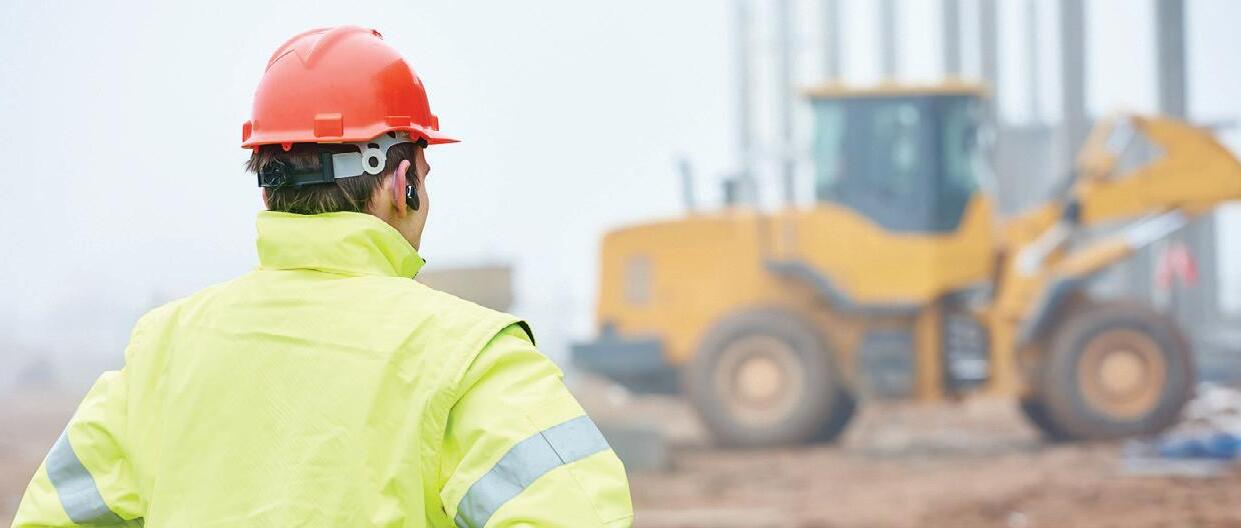
About Civil Contractors Federation (CCF)
Civil Contractors Federation (CCF) is the peak industry body representing Australia’s civil construction industry with more than 2,000 contractor and associate Members nationally and over 520 of these based in Victoria.
CCF members are responsible for the construction and maintenance of Australia’s infrastructure, including roads, bridges, pipelines, drainage, ports and utilities. Its members also play a vital role in the residential and commercial building industry by providing earthmoving and land development. services including the provision of power, water, communications and gas.
CONCRETE For more information on this issue, please contact the CCF Team on 1300 DIAL CCF or email support@ccfvic.com.au.
63 www.infrastructuremagazine.com.au September 2019 // Issue 12
CUTTING A PATH TOWARDS A RENEWABLE FUTURE

For a family-owned company like WEA Group, researching and selecting the right equipment is imperative to allow the company to expand its capabilities and profitability. Recognising the opportunities that an additional trencher to their fleet would offer, WEA Group researched and trialled a number of machines before deciding on procuring a Vermeer T755 Trencher.
September 2019 // Issue 12 www.infrastructuremagazine.com.au 64
ENERGY INFRASTRUCTURE // PARTNER SOLUTIONS

WEA Group has been providing underground cabling and civil works for renewable energy projects across the country since 2015. In 2019, the company decided to procure a Vermeer T755 Trencher to compliment its fleet.
James McLeod, Director at WEA Group, said, “We own all of our own plant and equipment now. The trencher was the last item on the list, so we are fully self-catered, which is very rare nowadays. A lot of companies are still hiring plant and equipment, so we’re very proud of that.
“We used to hire a trencher, and being able to purchase one has reduced our internal costs. It’s given us more flexibility for when we can actually use the trencher, as well as where we can use it, because obviously we’ve got the flexibility of now being able to move it around a lot more.
“It’s really complemented the fleet, helped our productivity and made us more efficient as well.”
RESEARCH KEY TO DECISION-MAKING
Mr McLeod said the company researched and trialled a number of different trenchers before selecting the Vermeer T755.
“We conducted significant research into what different brands of trenchers were out there, so we looked at some of Vermeer’s competitors too. We also looked at bucket wheels, rock wheels, plus other models and machines within the Vermeer offering,” Mr McLeod said.
“We did a lot of research and several trials with the T955 and the T1055, down to the T558 but we found the T755 was the best for our needs.”
Mr McLeod said there were a number of reasons the company chose the T755.
“The main reason we went for the T755 was because of its fuel consumption and reliability. We also looked at factors like how close the nearest service centres were for Vermeer,” Mr McLeod said.
“We loved the fact we could get someone out on-site to do a service, or maintenance if there was ever a fault or an issue, which was a big factor for us as well. We wanted to not only reduce our carbon footprint, but to reduce any downtime if there was an issue with the machine.”
A major feature of the T755 that appealed to WEA Group was its Auto Self Levelling system, which allows the machine to operate on a slight tilt while keeping the trench straight.
“This feature is extremely important when working on wind farms because unfortunately they don’t build wind farms on flat ground, they’re up and down mountains and hillsides.
“Its versatility on different types of terrain was extremely important to us, as well as the dual system on the chain and dual sprocket system to help stop chains slipping or the chain falling off, which reduces downtime.
“It’s a big investment. We’re only a small family company, so it’s very important that we got it right.”
PUTTING THE TRENCHER THROUGH ITS PACES
Mr McLeod said that the company put the trencher to work straight away on a wind farm, and within a week it had already covered a lot of land.
“It’s currently on the Lal Lal Wind Farm project cutting a 450m by 1100m deep trench down in Victoria. It’s going up hills and down dales; it’s done some interesting little bits already,” Mr McLeod said.
“It’s done the dam wall crossing, it’s done quite a number of V drain crossings, and a little water crossing already. It’s definitely done a lot. It’s probably trenched about 3,500m in one week, so it’s been busy.”
THE IMPORTANCE OF CUSTOMER SERVICE
Mr McLeod said the team at Vermeer has made the process of procuring the trencher easier, and made sure that the company had all the information it needed to get the most out of their new equipment.
“I can’t speak highly enough of Ken. He really assisted in areas that we were unsure about as we’ve never owned a trencher before,” Mr McLeod said of Vermeer Product specialist Ken Smith.
“He’s helped us get the right suppliers for the teeth and made sure that we set up a service vehicle. So we bought an Isuzu medium rigid truck, we set it up with a crane, oil pumps and all the equipment needed to make the plant run at top form. Everything we needed to run that machine.
“Generally he helped with how to get the best out of the machine and helped source the best suppliers for the machine.”
Mr McLeod said his experience with the Vermeer customer service team and the quality products has led WEA Group to look into potentially purchasing more equipment from Vermeer in the future.
“We’re currently looking at procuring more equipment from Vermeer as we are looking to expand into different areas. It’s definitely on the cards for the future of the company.”
www.infrastructuremagazine.com.au September 2019 // Issue 12 65 ENERGY INFRASTRUCTURE // PARTNER SOLUTIONS
The modernisation and streamlining of building construction methods in recent years, particularly of warehouses, has seen precast panel erection become one of the more common jobs for cranes and crew. There has also been a boom in residential development on the east coast of Australia with construction of medium size apartment dwellings using precast concrete because it is cost-effective and expedient.

THE KNOWLEDGE GAP FOR
CRANES AND PRECAST
September 2019 // Issue 12 www.infrastructuremagazine.com.au 66
CRANES & HEAVY LIFTING

Precast concrete is an alternative to cast-in-situ concrete, but lifting precast panels is particularly hazardous for a number of reasons including the weight of the panels, a requirement to rotate the panels in mid-air, high repetition and the necessity for workers to be near to attach props to support the panels temporarily, once erected. Each new panel is placed next to the last, so the amount of available space is reduced.
The Crane Industry Council of Australia (CICA) is the national peak industry body for the crane industry. CICA liaises with crane owners, hirers, operators, government and regulatory bodies as well as other establishments affiliated with cranes and their uses. CICA aims to:
♦ Improve the health, safety and well-being of crane industry personnel
♦ Drive compliance with applicable legislation and regulation
♦ Improve crane usage, customer experience and efficiency
DIFFERING DEFINITIONS
John Humphries, CICA’s Safety Liaison Officer, publishes monthly safety bulletins that address hot topic safety issues for crane owners, hirers and users. In the recent Safety Bulletin 245, John discussed a research paper from Monash University that evaluated causal and shaping factors attributing to fatalities in the crane industry. The paper highlighted root causes such as ‘physical site constraints’ and types of incidents such as ‘struck by load’, which refers to loads falling or becoming dislodged and has a very high representation of precast panels, beams and concrete loads.
The root causes of loads striking personnel are identified as gaps in industry knowledge, inadequate slinging, unstable stacking/dunnage, mechanical failure, cranes tipping, rigging failures and even cranes making contact with stacked material.
CICA has identified an ‘industry knowledge gap’ in the first paragraph of the Crane Safe Use standard AS2550.5-2016 Clause 6.10.1, which states, “Where both the main and auxiliary hoists of a single mobile crane are to be used simultaneously to lift a load (e.g. for tilt-up concrete construction), a lift procedure shall be prepared.”
This clause outlines a requirement to develop a lift procedure for multiple hoist or crane operations. The terminology used in the example “tilt-up concrete construction”, however, is not accurate and has been a cause of confusion in the crane industry.
AS3850-2105 is the Australian Standard applicable for the construction of buildings, this standard is currently being extended to cover prefabricated concrete elements used in civil and other constructions.
“Tilt-up” as defined in AS3850 means a method of lifting a prefabricated concrete element from a horizontal to a vertical position, by rotation about one edge. The use of “tilt-up” only has meaning for elements rotated from a horizontal position (e.g. in the casting bed or mould) to the vertical position either for transport, storage or more commonly for erection in-situ for site-cast panels. As shown in Image 1 from AS3850,
CONSTRUCTION
www.infrastructuremagazine.com.au September 2019 // Issue 12 67
CRANES & HEAVY LIFTING
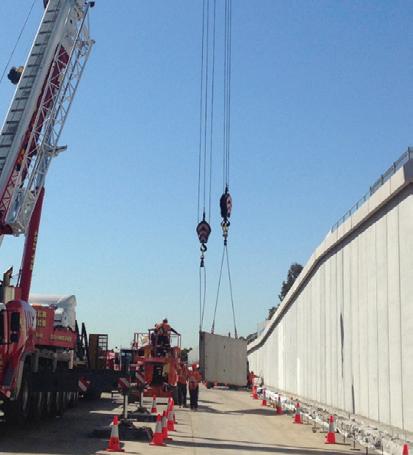


this operation only requires one hoist for the lift, it does not require multiple hoists for the operation.
In many situations, multiple hoist or multiple crane lifts are required for flat panels that need to be manipulated for erection by in-plane rotation in mid-air, whilst freely suspended from a crane or cranes. An example of the rotation of a flat panel using inserts located in its edge is shown in AS3850 Figure 2.6. According to the definition in AS3850, this type of lifting is not “tilt-up”. The example used in AS2550.5 Clause 6.10 is not appropriate for the content as the actions defined for “tilt-up” only require one hoist to perform. To close the knowledge gap, CICA’s Technical Project Engineer, Alice Edwards, is working with the standard development committee to put in an amendment to AS2550.5 to clarify this issue.

GUIDANCE MATERIAL NEEDED FOR ‘WRAP AROUND’ INDUSTRIES
When two industries cross over — in this case the crane industry and the precast construction industry — there is a potential knowledge gap. To deal with this more broadly, Tom Clark, National Technical Safety Advisor at Fulton Hogan, has been working on behalf of CICA to introduce a precast Australian Standard for construction materials.
He said, “As precast concrete element use continues to grow in building and infrastructure construction projects, industry has identified the knowledge gap in proper use and crew training. Standards Australia is working on guidance material for design and use of concrete elements specifically used in infrastructure projects. The drafting committee has taken a practical approach to make the standard ‘userfriendly’ through common language and reflective of the safe practices that industry has initiated. The draft will be released later in the year and public comment is welcomed to make the standard a useful document.”
Another challenge of precast panel erection is the reliance on the quality of the casting of which a crane crew has neither the control nor visibility to
detect. A concrete panel needs adequate time to set before it is lifted, or it may fracture and fall from the hook through no fault of the crane crew. The lifting inserts cast into the panel pose another challenge, and if not cast properly with correct reinforcement have the potential to fail. The crane, rigging and clutch are powerless to stop a panel from falling if the insert in the panel itself fails. For this reason, panels, when delivered to site, need to have paperwork, commonly known as a ‘Birth Certificate’ which provides evidence that a panel has had the required time to cure.
Precast concrete construction has many advantages, and greatly reduces on-site time and expenses. With the advances in this type of construction, however, careful consideration needs to be given to the ‘wrap around’ industries so that their safety practices and plans are informed and not playing ‘catch up’. Cranes are essential to the installation of precast and as they are required to operate over the entire building volume, the care and time taken by cranes and crew to plan the lift of each piece and shift it to its final position is critical in determining that safety is not trumped by construction schedules.
September 2019 // Issue 12 www.infrastructuremagazine.com.au 68
CRANES & HEAVY LIFTING
Image 2: AS3850-2015 Figure 2.6 mid-air rotation of elements.
Image 1: AS3850-2015 Figure 2.4 common edge lifting configurations.
Delivering Growth; Creating Opportunity; Embracing Technology

THE LARGEST RAIL EVENT IN THE SOUTHERN HEMISPHERE RETURNS TO SYDNEY
WHAT TO EXPECT, BESIDES THREE DAYS OF HIGHLY BENEFICIAL ENGAGEMENT WITH YOUR PEERS, SUPPLIERS AND SERVICE PROVIDERS...
• 1000+ senior rail sector, government and academic leaders participating in the conference
• Plenary and technical streams across three informative days
• 400+ exhibiting organisations from a diverse range of suppliers and service providers
• 13 catered functions for a cross range of attendees over three days of premium networking including Welcome Reception, Networking Drinks, 2 major Gala Dinners, Luncheons
• And more ARE YOU AN ARA MEMBER?
ARA Members receive a 20% discount on conference attendance, sponsorships and exhibitions (conditions apply)
YOUNG RAIL PROFESSIONALS – AUSRAIL SHINES A SPOTLIGHT ON TOMORROW’S LEADERS
• Young Rail Professionals Pitching Competition – ENTRIES NOW OPEN!
• Next Generation Scholarships
• NEW FOR 2019 – Mentor 50% discount rate now available for those 35 years and under (conditions apply)
• Visit www.ausrail.com for full information.
OUR SPONSORING PARTNERS INCLUDE:


LANYARD SPONSOR APP SPONSOR INNOVATION HUB SPONSOR SUPPORTING SPONSORS EXHIBITION NETWORKING DRINKS SPONSOR PREMIUM PLATINUM AND GALA DINNER SPONSOR PREMIUM GOLD AND RTAA YELLOW TIE DINNER SPONSOR GOLD SPONSOR SILVER SPONSOR To promote your organisation, secure a networking package, exhibit or advertise, email: Deborah.Bocock@informa.com.au
THE BLUEPRINT FOR BETTER MENTAL HEALTH

IN THE CONSTRUCTION INDUSTRY
by Nick Thompson, Industry Engagement Coordinator, MATES in Construction
Men in the construction industry are 53 per cent more likely to die by suicide than other employed men across Australia. It’s a startling statistic and one that the industry is trying to change, starting with the creation of The Blueprint for Better Mental Health which outlines common triggers and what the sector needs to be doing to better protect the safety of its workers.
The building and construction industry instigated and informed the MATES in Construction community development model of suicide prevention and intervention over a decade ago. Designed by and for the construction industry, MATES has been leading the way in increasing the industry’s capacity to respond to mental health and suicide.
The model empowers workers to recognise and talk about the welfare of their mates and walk alongside them to safety when times get tough. The industry has come a long way in improving awareness and understanding of mental health and its impacts on workers, yet evidence shows men in the construction industry are 53 per cent more likely to die by suicide than other employed men across Australia.
When looking at what impacts mental health, personal pressure and life triggers such as relationship break down, financial stress, grief, loss and conflict are present in most of our lifetimes and impact each of us in different ways. Within the construction industry, however, job insecurity, long working hours, a culture of heavy alcohol use and an undercurrent of bullying often occurs simultaneously. These patterns of life triggers and
workplace orientated pressures occurring in tandem, whilst not oversimplifying a complex issue, starts to demonstrate an identifiable picture of what the challenges to mental health and well-being are across the construction industry. When one in five construction workers experience a diagnosable mental health condition and one in 20 experience suicidal thoughts, the external factors attached to an individual’s wellness is very much interconnected with not only their job but the entire industry.
In the context of safety and risk management, it’s not hard to set a scene where we have a population group that are particularly at risk of suicide and mental health concerns, and an industry that can’t be divorced as a contributory factor.
A SHARED VISION FOR BETTER MENTAL HEALTH SUPPORT
When applying occupational workplace health and safety legislation to workplace mental health practices, workplaces are required to be safe and healthy, and not cause ill health or aggravate existing conditions. In understanding the underlying challenges to mental health and well-being across the industry on top of what is legally required to protect workers, the

Construction Industry Mental Health Roundtable was initiated.
MATES in Construction, Beyond Blue, employer groups and unions came together via the Roundtable to agree on a shared vision of being a global leader in workplace mental health and to adopt a nationally agreed framework. From senior executives to construction workers, to contractors to employer groups and unions, together the industry agreed on a plan to address workplace mental health and well-being. International standards and evidence around workplace related mental health was examined to see what conditions and what environments contribute to a strong sense of mental health and well-being. The result is the Construction Blueprint for Better Mental Health and Suicide Prevention 2018-2020.
THE FIVE CORE PILLARS TO ADOPT
The Blueprint provides an evidencebased model of improving overall mental health in the workplace. This model is informed by five core pillars or action items that together create an interconnected workplace environment of resilience. These pillars, when applied in unison, are demonstrated to manage the safety and risk attached to the industry at large via a micro scale at a workplace, worksite or project, informed by what we know impacts individuals within the industry.
1. The promotion of works positive impact on mental health
Work and a connection to productivity
September 2019 // Issue 12 www.infrastructuremagazine.com.au 70
SAFETY AND RISK MANAGEMENT
Nick Thompson, Industry Engagement Coordinator, MATES in Construction

and community in itself is a strong protective factor in an individual’s mental health. An environment where workers are informed and engaged through site events and project milestones, and are communicated and informed for their impacts, increases workers sense of belonging and agency. Providing wellbeing activities that encourage a healthy workplace that communicates in a way that’s inclusive and response to the needs of a team creates an environment of value, collaboration and well-being.
2. Reducing harmful impacts at work
Risk factors associated with the development or exacerbation of mental health issues in the workplace come from both work content such as high-pressured project deliverables and context such as bullying from workmates, unrealistic workloads or problematic management practices. Work situations involving low job control and poor support are linked to challenging health outcomes both physical and mental. Individuals differ in the amount of work they can reasonably be expected to undertake in a safe, healthy and productive manner. Policies and procedures that mitigate these risk factors and plan around managing their likelihood and impact are critical to improving workplace mental health.
3. Providing mental health and suicide prevention literacy
Suicide and mental health are arguably among the most stigmatised topics in the industry. These stigmas can prevent people from both seeking and offering help. Typically, stigma further isolates and disconnects individuals experiencing poor mental health. Evidence demonstrates that greater
awareness and education about mental health issues can facilitate help-seeking behaviour. Targeted information can break down stigma and normalise discussion of these topics.

4. Facilitating early intervention and treatment
Diagnosable mental health conditions, if treated early can often be effectively managed or cured. Workplaces need to provide clear pathways where workers with mental health issues can be identified, supported and provided with appropriate care. In particular, programs to increase and facilitate help offering could target individuals with poor helpseeking behaviour and may help to break down stigma.
5. Providing return to work and ongoing support
A work-related injury or illness can have a big impact on a worker’s life. Research has shown that returning to work is important for health and wellbeing. Employers have an important part to play in assisting with return to work. Many people have misconceptions about
mental health issues, including the belief that mental health issues cannot be treated, that mental health issues are caused by personal weaknesses or that recovery isn’t a reality. Processes that carefully manage the reintroduction of workers into the workforce that supports both the worker and their workmates increases a sense of well-being and encourages help-seeking behaviour when demonstrably supported.
A HOLISTIC APPROACH TO PREVENTION AND INTERVENTION
The Blueprint for better mental health has been designed by and for the building and construction industry, informed by what we know works and what challenges we face. The Blueprint provides a framework that enacted in unison directly mitigates the instances and impacts of mental health challenges in the workplace.
From a safety and risk management standpoint, acting on what we already know via evidence and experiential insight is a necessity, not just as it is the right thing to do, but because it’s the law. We have an industry that whilst challenged by causal factors to poor mental health, has shifted a startling figure in rates of suicide.
Building upon prevention and intervention to a holistic model of integrated workplace well-being and mental health by enacting the Blueprint’s five core pillars will not only mitigate the factors we all know bear down on our workforce but will assist in the long-term agility and resilience of the industry.
For more information on the Blueprint, please visit constructionblueprint.com.au/register.
www.infrastructuremagazine.com.au September 2019 // Issue 12 71 SAFETY AND RISK MANAGEMENT
LEARNING HOW TO CREATE SAFER WORKPLACES
For more than 20 years, Safety in Action has been the meeting place for the Australian health and safety industry. Thousands of safety professionals across the industry have visited the event to discover new solutions to help them achieve their goals in creating safer workplaces.
Safety in Action returns to Melbourne in 2019 to deliver an inspiring event, enabling professionals to network with peers, explore the latest trends and developments, and source the latest innovative products and services. It is a must-attend for every WHS professional.
Delegates can visit the two free seminar zones to hear from a range of high-calibre safety and HR professionals on major projects and innovation, and well-being and mental health.
MAJOR PROJECTS AND INNOVATION
This part of the conference focuses on organisations that have implemented, or are in the process of implementing new programs, management systems or safety culture resets. You can learn handy tips and tricks that can be transferred to your own workplace. Innovations that will be explored include the latest evidence-backed technologies, mobile technologies, PPE and many more.
WELL-BEING AND MENTAL HEALTH
With a focus on the difficult task of measuring mental health and well-being, there is a seminar that examines initiatives and approaches with proven results and return on investment.
FREE TO ATTEND SESSIONS
Musculoskeletal Disease (MSD) in the Workplace
Seven million people living with Musculoskeletal Diseases (MSD) are of working age. Coupled with an aging workforce, MSD represents a significant and growing risk for organisations. There will be a free session to learn how employers can support people who have, or are at risk of developing musculoskeletal disease at work. This session aims to:
♦ Increase awareness of the impact of MSDs in relation to work for both employees and employers
♦ Help people living with MSDs manage at work through a suite of specialised programs across a number of areas, including physical therapy, telephone support, information resources and educational seminars that address support in the workplace, career planning and condition/pain management
♦ Support employers to develop and maintain a healthy and productive workplace environment which can reduce absenteeism, staff turnover, workers’ compensation and medical claims
♦ Highlight new research conducted by Musculoskeletal Australia (MSK) on what resources and support people need to stay employed
♦ Target occupations with a high prevalence of MSD, such as the transport industry (truck drivers), health care industry (nurses, orderlies), education industry (teachers), the trades and sedentary occupations
Why investigations fail and how to identify the true organisational issues
This presentation discusses how to identify and collect evidence that unlocks the conditions that contribute to an incident. The session with Mark Alston, Principal Consultant, Immotus Consulting, will explore:
♦ Overclassification leads to poor investigations
♦ Collecting the right evidence is key
♦ Failure is not linear
♦ Comparing work as normal vs work as intended unlocks true organisational issues
♦ Root cause analysis does not add value. A targeted contextual ‘5 Whys’ can
♦ Identifying conditions that contributed to the event and developing actions
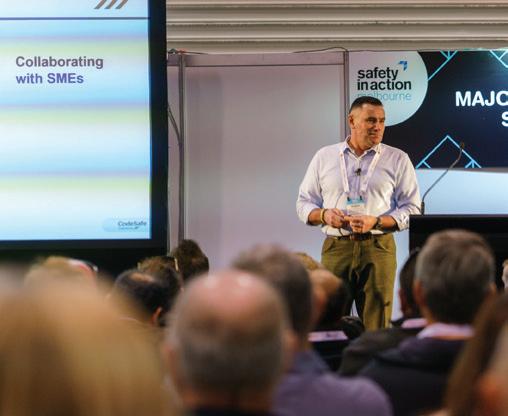
For more information and to register for a free visitor pass, please visit https://www.safetyinaction.net.au/ for more information.
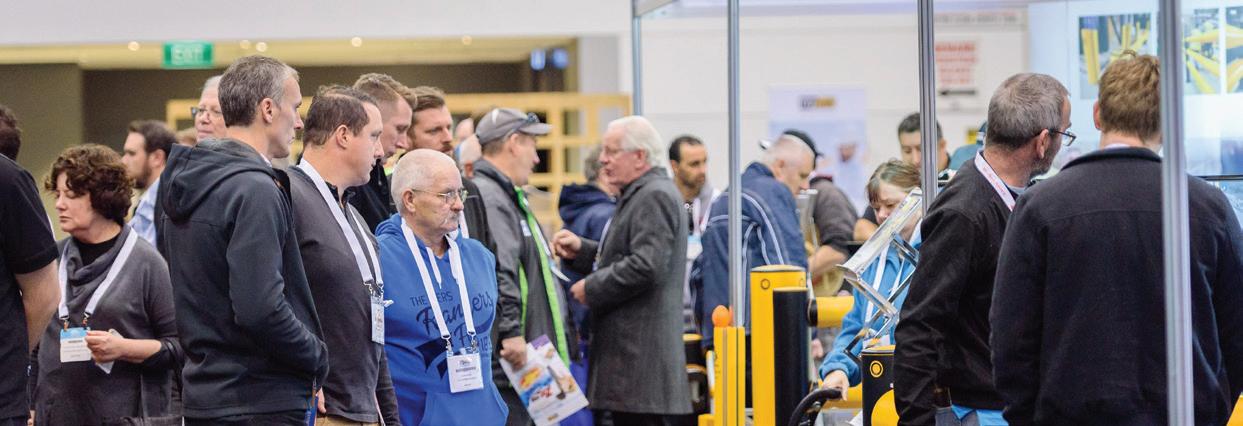
September 2019 // Issue 12 www.infrastructuremagazine.com.au 72
SAFETY AND RISK MANAGEMENT // PARTNER SOLUTIONS
10-11 SEPTEMBER 2019
Melbourne Convention & Exhibition Centre
AUSTRALIA’S LEADING WORKPLACE HEALTH AND SAFETY EVENT

EXHIBITION
Over 3500 professionals will be attending the show across two days. Join us at the longest running exhibition of the OHS industry!
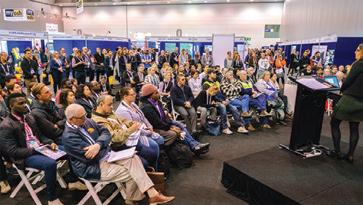
SAFETY SEMINARS
These informative seminars are FREE and take place within two Safety Zones across the exhibition floor.

CO-LOCATED CONFERENCES
Safety in Action presents three high-profile conferences. These will take place concurrently with the exhibition. Delegates will be able to switch sessions between the conferences to suit personal requirements.
MAJOR CORPORATE SPONSOR CONFERENCE SPONSORS SUPPORTING PARTNER


www.safetyinaction.com.au
TRACK RECORD: QUEENSLAND RAIL IMPROVING SAFETY
Signal Passed at Danger (SPAD) incidents – where trains pass a red stop signal into a section of track without authority to do so – are caused by a range of factors, and occur throughout the rail industry round the world. Since 2017, Queensland Rail has introduced a number of measures to reduce its SPAD rate and is consistently recording fewer incidents.
SPAD incidents are an industrywide issue faced by rail operators all over the world and can be caused by an error or violation by a driver, signaller or controller, or because of a technical glitch, and are often a result of the length of time and distance it takes to stop a train.
Queensland Rail, which is responsible for more than 6,500km of track and 216 stations, ranks safety as its top priority and is committed to improving its safety record. Drivers who are involved in SPAD incidents are removed from duty and undergo alcohol and drug testing, are subject to a safety investigation, and must pass a competency assessment and undergo on-track monitoring to confirm their skills before they can return to their usual duties.
However, when a slight increase in its SPAD rate was detected in the first half of 2017–18, Queensland Rail instigated a number of other measures to help reduce the number of SPAD incidents across its network.
PUTTING SAFETY MEASURES IN MOTION
In October 2017, Queensland Rail formed a SPAD Prevention Taskforce, which brought together key staff to deliver a strategy and devise safety
controls that focused on human factors, driver behaviour and increased levels of engagement with staff.
The taskforce implemented toolbox talks for staff and increased one-onone engagement with train drivers to improve SPAD awareness. An organisational psychologist specialising in human performance in safety-critical settings was also appointed to help guide the work of the taskforce.
In February 2019, Queensland Rail also engineered solutions for signal ME45 at Bowen Hills – north-east of Brisbane’s CBD – to improve visibility at the site for drivers, provide advanced warning of the signal, and reduce the likelihood of collisions occurring. Physical changes to signalling have also been carried out at a number of locations including Normanby and Northgate.
Queensland Rail is also analysing data from incident-free events to help identify train handling behaviour that has a known relationship to SPAD incidents, and to further improve driver training and awareness.
NUMBERS SPEAK FOR THEMSELVES
According to Nick Easy, Queensland Rail CEO, the number of SPAD incidents had stabilised by February 2018 and continues to decline.
“Following the establishment of the

Taskforce, Queensland Rail recorded the lowest number of SPADs since this measure was first reliably recorded over two decades ago,” Mr Easy said.
“In January 2019, Queensland Rail recorded its best-ever SPAD rate of 1.44 SPADs per million train kilometres travelled.
“In June 2019, Queensland Rail recorded a SPAD rate of 1.61 per million train kilometres. This number is a significant improvement from a year ago when the rate was 2.35 in June 2018, and is below Queensland Rail’s target of 1.78.
“This improvement was also reflected in the 2018–19 financial year, when Queensland Rail recorded 1.61 SPADs per million train kilometres travelled – a 30 per cent improvement on 2017–18 when it was 2.35.”
But Queensland Rail has no intention of resting on its laurels where safety is concerned.
“We’re extremely pleased to see the improvements the SPAD Prevention Taskforce has already delivered in terms of reducing the rate of SPADs on the network, and we will continue our strong focus in this area.”
74 September 2019 // Issue 12 www.infrastructuremagazine.com.au
SAFETY AND RISK MANAGEMENT
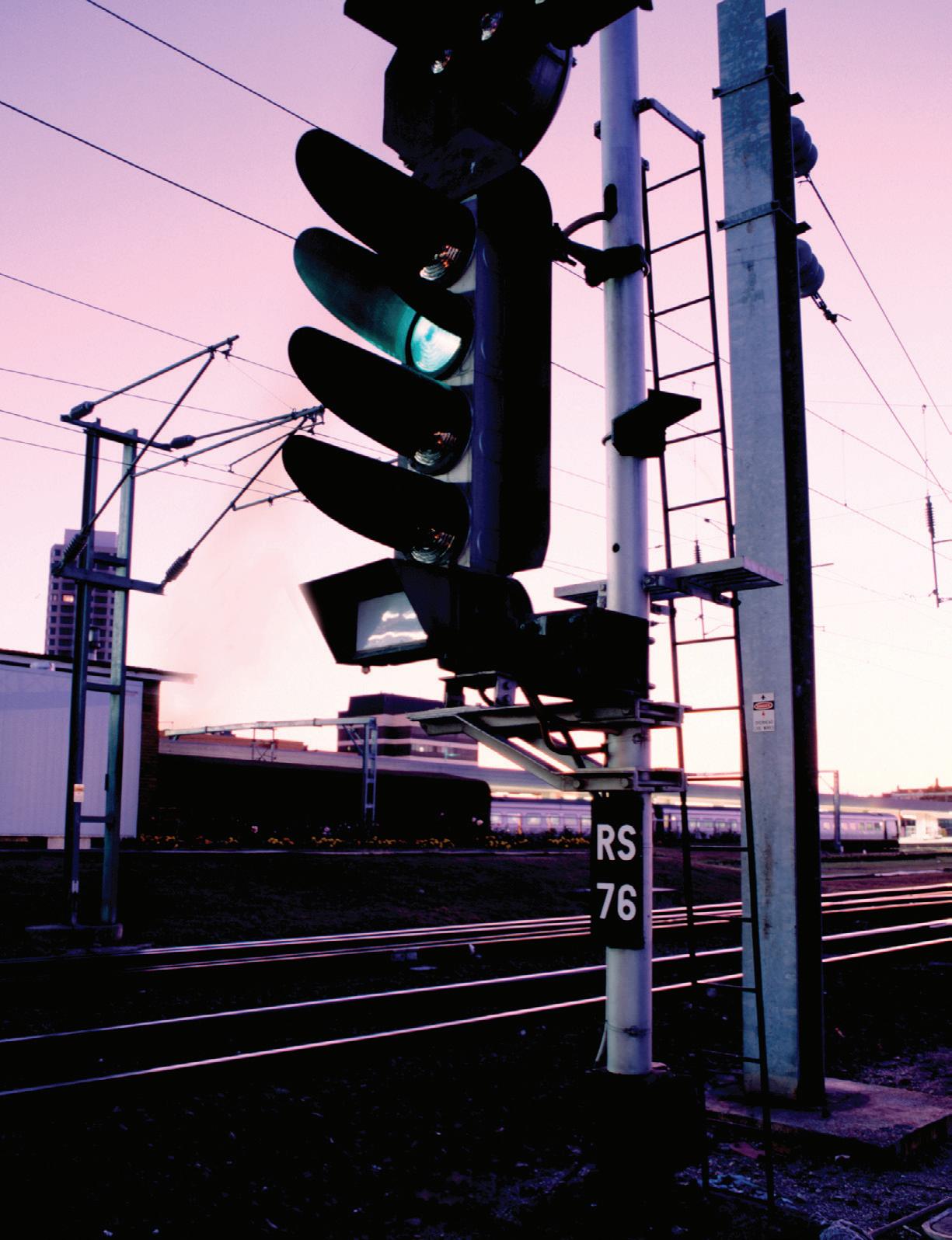
75 www.infrastructuremagazine.com.au September 2019 // Issue 12 SAFETY AND RISK MANAGEMENT
Disaster Management 2019 is a two-day event that will look at the impacts a range of disaster events can have on the owners of critical assets; and provide tools to help your organisation minimise the impact of a disaster, and emerge stronger than ever before.

IS YOUR ORGANISATION PREPARED TO
HANDLE A
We are living in an age where the threat of disaster is constantly imminent, and owners and managers of critical infrastructure - such as the assets that make up our national electricity grid – need to be well prepared for the range of disaster events that could potentially affect them.
Disaster can take many shapes or forms. It could be a natural disaster, such as bushfire, flood, drought or extreme heat. Or it could take the form of a terrorist attack, whether that be on your physical assets or a cyber terrorism attack on your systems. Or it could be something more obscure, like the threat of an industrial accident, an economic crisis, a resource crisis, or even a disease outbreak. It could happen six months from now, it could happen five years from now, or it could happen tomorrow.
Whenever it happens, or whatever form it takes, if you’re involved in the worlds of infrastructure, utilities or local government, you need to be thinking about how your organisation will prepare for, survive and then thrive in the face of disaster.
One of the best ways for major asset owners to ensure they are up to date with the latest industry thinking when it comes to surviving crisis situations is at Disaster Management 2019, taking place from 21-22 November 2019 at the Pullman Albert Park, Melbourne.
Brought to you by Energy, Infrastructure and Utility magazines, Disaster Management 2019 will help your organisation ensure it is prepared for the range of disaster events that can strike critical asset owners at any time.
WHY ATTEND?
If you work in the area of critical services, such as energy utilities or infrastructure, and you’ve ever asked yourself, “Is our organisation really prepared to deal with the effects of a disaster event?”, then you need to attend this event.
The fact of the matter is, in the world of critical infrastructure, you might not be able to stop the worst from happening, but you can reduce the impact of a crisis by being prepared and ready to act.
At Disaster Management 2019, you will:
♦ Explore the breadth of disaster events that could strike the infrastructure sector
♦ Prepare for the potential impacts these crises could have on your organisation
♦ Delve into the disaster response process, and highlight the critical steps you need to take to effectively manage a disaster event
♦ Develop strategies to enhance the organisational resilience of your business
♦ Learn how to emerge from a disaster as a stronger organisation than before
We will do this through an expert speaker lineup, which will feature experts from within the world of disaster management; as well as representatives from infrastructure organisations that have survived their own disaster events and emerged as stronger, more capable businesses.
Speakers at the event include Paul Jordon, Executive General Manager, Distribution at Energy Queensland, who will be discussing the challenges facing Energy Queensland after the
76 September 2019 // Issue 12 www.infrastructuremagazine.com.au
SAFETY AND RISK MANAGEMENT
CRISIS?

devastating Townsville floods in February, and his insights into surviving and thriving after this event; as well as Simon Dunstall from the Analytics and Decision Sciences Program at Data61, who will be discussing the work he does to quantify and manage the bushfire-related risks posed by powerlines.
Conference highlights include multiple speed networking sessions, where delegates are guaranteed introductions to colleagues within the industry; as well as a number of expert panel sessions where representatives from different organisations will compare and contrast their experiences, providing valuable insights across the entire chain of disaster management.
Disaster Management 2019, aimed at helping critical service providers prepare, survive and thrive in the face of major disaster events, is taking place from 21-22 November 2019 at the Pullman Albert Park, Melbourne.
Pre-sale tickets for the event, which can save you over $1000 off the standard ticket price, are currently available. For more information and to book your tickets, head to www.disaster-management.com.au/buy-tickets/
The conference program will be built around three central themes, covering:
Preparing
Identifying and preparing for strategic risks
Identifying vulnerabilities
Anticipating and monitoring potential risk factors
Crisis simulation and planning
Disaster prevention
Surviving
Real-time response
Crisis communications
Management and leadership in crisis
Event monitoring
Procedures for emergency management
Enacting your crisis management plan
Thriving
Restoring services
Communication post disaster
Bouncing back from disaster
Building resilient communities
Finding opportunities to rebound
Knowing when a disaster event is over
Managing the recovery period
Assessing previous disaster performance
77 www.infrastructuremagazine.com.au September 2019 // Issue 12
SAFETY AND RISK MANAGEMENT
Disaster Management
Disaster Management
Disaster Management
2019
2019
2019
What images does the word ‘safety’ conjure up in your mind? Perhaps it’s high visibility workwear? Checking off boxes on an audit form? Equipment costs? Or perhaps the task of preparing reports for management to demonstrate compliance? Many of these responses are typical. Far less typical is the scenario of colleagues at all levels of an organisation proactively engaging in discussions around safety.
Across the freight and logistics industry, many remain so focused on the administrative processes that surround safety compliance that they neglect to have these essential conversations. Even when the conversations do occur, they are often too focused on the processes around safety, rather than the people involved. After all, safety issues are not solely caused by issues with vehicles or equipment. Suppose a colleague is struggling with pressures at home, or with mental health issues that might not be immediately apparent. These matters won’t necessarily be picked up by a traditional safety audit or compliance check – yet they can undoubtedly be contributing factors to workplace safety issues if left unaddressed.
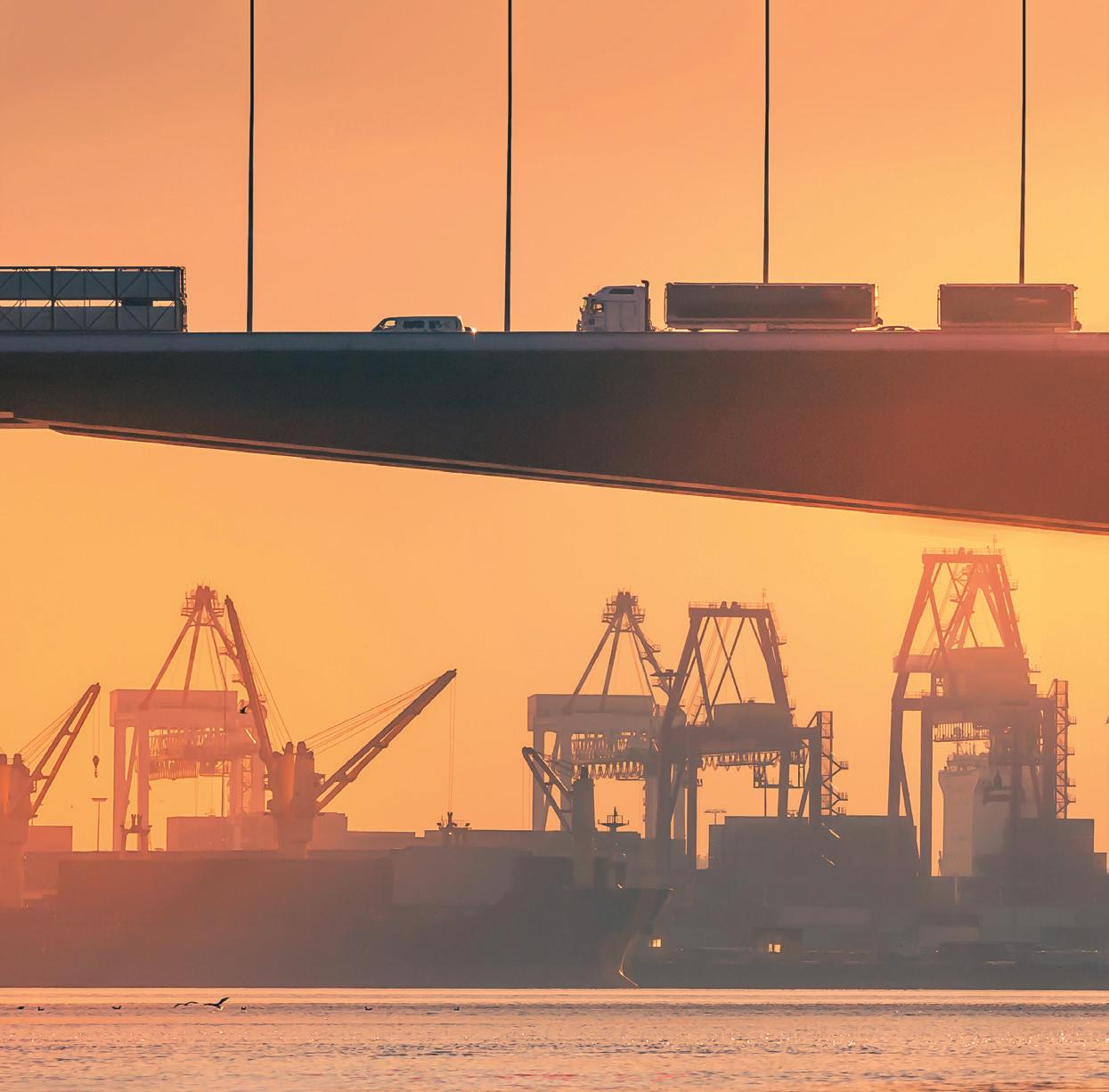
CHECKING IN, NOT CHECKING OFF
by Kirk Coningham, CEO, Australian Logistics Council
September 2019 // Issue 12 www.infrastructuremagazine.com.au 78
FREIGHT AND LOGISTICS
It is easy to pay lip service to the idea that “everyone” is responsible for safety. What is far more difficult is to foster an organisational culture that prioritises safety, from the basement to the boardroom, and recognises that safety is fundamentally about people, not processes.
It is one thing for managers and executives to count the number of green ticks on a document and satisfy themselves that everything is going well in terms of meeting an organisation’s safety obligations.
Yet, too much of what is done in the name of safety can ultimately be unnecessary or ineffective. As we all understand, a high degree of activity does not necessarily equate to a high quality of output.
DEVELOPING AN ORGANISATIONAL SAFETY CULTURE
Changing the focus from one of mere compliance to one of conversation and collaboration is the central theme for the 2019 ALC & ATA Supply Chain Safety Summit, which will be held at the Hilton Sydney from 16–17 September.
For the second year running, ALC and the Australian Trucking Association (ATA) are joining forces to present Australia’s most significant annual supply chain safety event, and help industry participants at all levels to deliver improved safety outcomes in their businesses and across the industry.
management of safety issues.
Greg Smith, author of Paper Safe, will explore some of the hard questions around conventional approaches to safety in our workplaces – and whether the preponderance of bureaucracy that has sprung up around safety management systems in recent times is producing perverse outcomes.
He will also set out some of the steps that can be taken to reconnect employers and employees to the original purpose of WHS – creating and maintaining safer workplaces – and move away from the intense focus on paperwork and compliance reporting.
This theme will be built upon by Marc McLaren from Art of Work, an organisation that helps companies to harness the expertise and insights of their people to deliver improvements
social isolation and pressures placed on domestic relationships due to long absences.
A FOCUS ON PEOPLE IS CRITICAL
Summit participants will have the chance to hear directly about some practical initiatives that are being developed by the industry to deal with these issues, ensuring that members of its workforce are well-supported and have a place to turn in the event that these pressures begin to overwhelm.
With the Master Code for heavy vehicle safety having been in operation since November 2018, the Summit will also be an important opportunity for those within the industry to provide feedback on how it has assisted them in their own operations, and in improving understanding of how the Chain of Responsibility works. This issue will be the focus for one of the Summit’s interactive workshops.

The program for this year’s Summit has been developed to address safety imperatives relevant to all modes of freight transport, and to provide attendees with the insights and practical advice they need to effectively influence the safety approach taken in the day-today operation of their own businesses.
This will include updates from regulators and policymakers, technology demonstrations, practical case studies of how various parties are meeting their Chain of Responsibility obligations and discussions on measuring safety performance. Attendees will also learn about the causes of truck fires and roll overs, as well as the latest developments on managing fatigue.
Particular highlights will be keynote presentations delivered by two highly regarded safety experts whose work challenges many of the assumptions often made when it comes to the
to safety, beyond what bureaucracies and systems of compliance can know or predict.
There will also be opportunities for attendees to drill down into specific areas of safety and consider how supply chain participants can develop solutions to long-term challenges that can lead to safety issues in the workplace.
A particular focus in this respect will be on what more can be done to improve the health of the freight logistics workforce. Australia’s supply chain relies on dedicated professionals who often spend long periods away from their families and friends in order to perform their roles.
This can engender very real health challenges, both in terms of risks to physical health through dietary, substance abuse and fatigue issues, as well as mental health through
Other workshop sessions will gather direct industry input on the review of the Heavy Vehicle National Law being undertaken by the National Transport Commission, use personal stories to consider how other parts of the supply chain interact on-site with heavy vehicle drivers, and explore in-depth ways it might be possible to better predict and manage worker fatigue.
As the development of technology offers new ways to improve the safety of our supply chains, Summit attendees will also be given a close look at how virtual reality is being deployed to deliver more effective safety training, as well as the impact of increasing automation and the safety issues that arise through the interaction of the human workforce with robotics.
The 2019 ALC & ATA Supply Chain Safety Summit promises to be an engaging, thought-provoking and practical two days that will give participants a competitive advantage when it comes to improving the safety and the productivity of their businesses. Moreover, it will play an important role in the industry’s continuing efforts to transform safety culture, moving from a focus on mere compliance towards a model that works proactively with an organisation’s personnel to address safety risks and put the safety focus where it should be – on people.
For more information, visit www. austlogistics.com.au/SafetySummit.
www.infrastructuremagazine.com.au September 2019 // Issue 12 79 FREIGHT AND LOGISTICS
FEATURES SCHEDULE
Spatial
80 June 2019 // Issue 11 www.infrastructuremagazine.com.au ADVERTISERS’ INDEX Smart cities Road surfacing and design, and flexible pavements Noise and vibration Earthmoving outlook Bridges Ports Urban development Automated and electric vehicles DISTRIBUTION SMART CITIES 2020 March 2020 Deadline: 20 December 2020 Software, communications and connectivity Signalling, tracking and control systems Rail Equipment Condition monitoring and maintenance
& GIS Mobility as a Service Training and skills DISTRIBUTION SYDNEY BUILD EXPO June 2020 Deadline: 10 April 2020
Ancor Loc 10 Artcraft 50 AusRail 69 Australian Tunnelling Conference 51 Corrosion & Prevention 17 Deutsche Bahn 12 Disaster Management OBC Hard Metal Industries 45 Hexagon PPM 34 Hi-Lux Technical Services 38 InEight 8 Intelligent Transport Systems 35 John Deere 55 National Roads & Traffic Expo 15 OzPipe XIX IBC Phoenix Contact Australia 49 Position Partners 19 Pyrotek 57 Queensland Department of State Development, Manufacturing, Infrastructure and Planning...................................................................29 Safety in Action 73 Taylors 27 TM Stagetec Systems 13 TrafficSensors.Com 33 Vermeer IFC-1 WAGO 3 West-Trans 11 November 2019 Deadline: 4 October 2019 AusRail IoT & cloud communication Airports Disaster management Corrosion Landscaping and vegetation management Security and critical infrastructure DISTRIBUTION AUSRAIL AUSTRALIAN AIRPORTS ASSOCIATION CONFERENCE CORROSION AND PREVENTION DISASTER MANAGEMENT September 2020 Deadline: 3 July 2020 Road and Traffic Intelligent Transport Systems (ITS) Tunnels Concrete Cranes & heavy lifting Safety and risk management Freight and logistics Sustainability Asset Management Asset inspection & drones/UAVS Security and critical infrastructure DISTRIBUTION ASSET MANAGEMENT FOR CRITICAL INFRASTRUCTURE 2020

If your business involves plastics pipe systems, OZPIPE XIX is the one event you cannot miss in 2019.
Delegate numbers are strictly limited so register early to secure your position and take advantage of the early-bird rates.



For two days over 7th and 8th November 2019, PIPA and the international Plastic Pipe Conference Association will gather the world’s foremost plastics pipe experts, together with Australia’s pipeline designers, operators and manufacturers, to share knowledge and latest developments in the fields of:
• Performance standards for recycled plastics in highway culvert and drainage pipes,
• Structural design research into large diameter buried drainage pipe,
• Conventional and trenchless pipe installation and design processes,
• Advances in plastic pipe welding and jointing processes,
• Plastics pipe asset-life research and future ser vice-life expectations, and

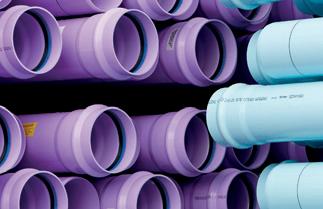
• State-of-the-art pipeline case studies from around the world. The location of this event is Dockside, on Sydney’s magnificent Cockle Bay Wharf.









MAIN SPONSORS iPAD SPONSORS NETWORKING EVENT SPONSOR LUNCH BREAK SPONSOR
ozpipe.com.au REGISTER NOW Early bird rates available for delegates who register now online - www.ozpipe.com.au + present GOLD SPONSORS





Brought to you by www.disaster-management.com.au EXCLUSIVE PRE-SALE ACCESS: REGISTER BEFORE 4 OCTOBER 2019 TO SAVE UP TO $1000 PER TICKET CASE STUDIES from Australian disaster events STRUCTURED networking opportunities Helping critical services prepare, survive and thrive in the face of major disaster events NOVEMBER 21–22, 2019 PULLMAN ALBERT PARK, MELBOURNE Disaster Management 2019




















 Grant Burton
Deputy Executive Director, Asset Management Division, Sydney Trains
Grant Burton
Deputy Executive Director, Asset Management Division, Sydney Trains


 John Kilgour CEO, Civil Contractors Federation,
Susan Harris Chief Executive Officer, ITS Australia
John Kilgour CEO, Civil Contractors Federation,
Susan Harris Chief Executive Officer, ITS Australia



















































































 Source:
Source:



























































































